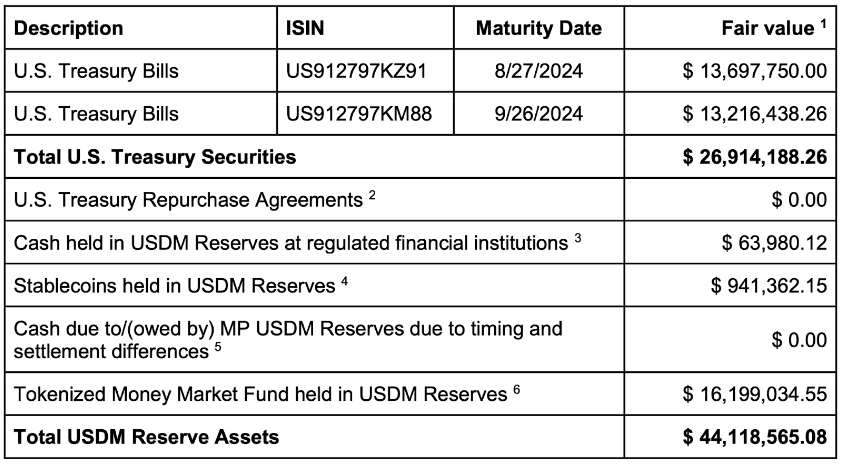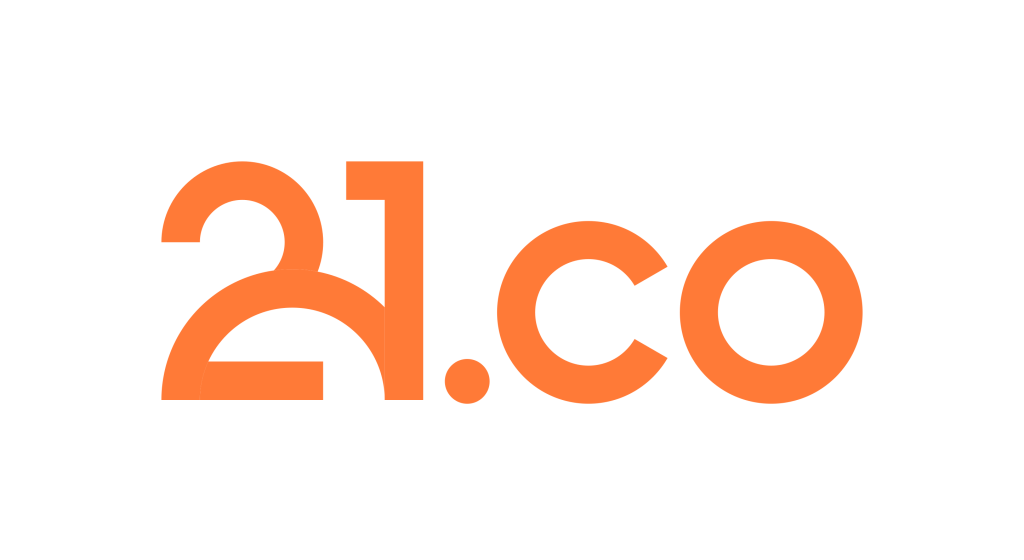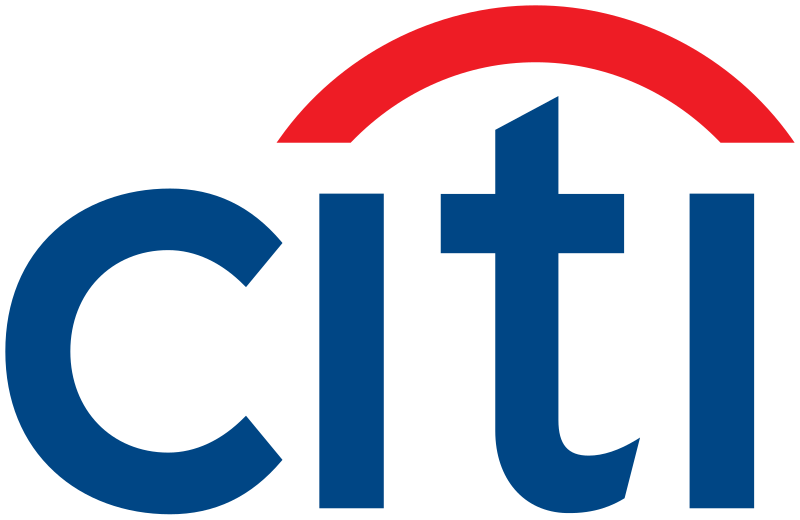Let’s look at some examples from the IP space.
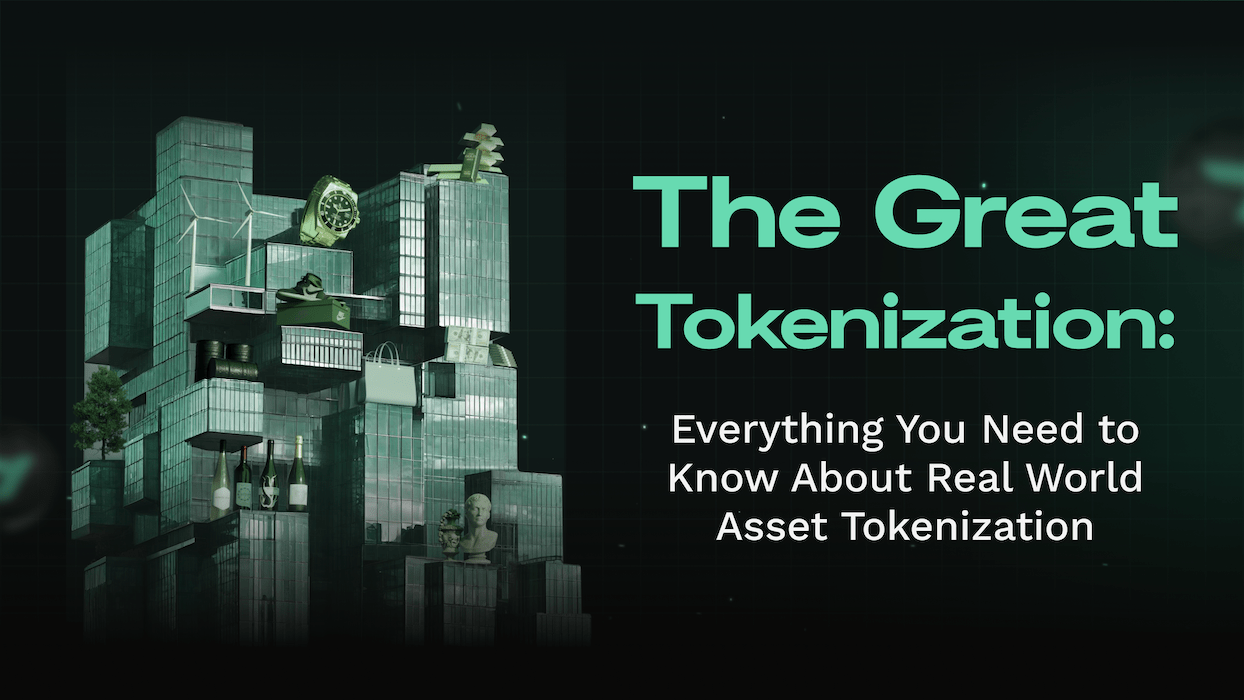
Table of Contents
- The Trillion Dollar Opportunity
- Understanding the Benefits
- Tangible vs Intangible Assets
- Current State of Tokenization
- Infrastructure
- Government Securities
- Private Credit
- Stablecoins
- Commodities
- Real Estate
- Intellectual Property
- Luxury Collectibles
- Carbon Credits
- Honorable Mentions
- The Future of Tokenized Assets
- 2030 Market Size Predictions
- Capitalizing on The Great Tokenization
- Tren Finance & RWA Tokenization
The Great Tokenization: Everything You Need to Know About Real World Asset Tokenization
As blockchain technology matures and expands its reach, we are rapidly witnessing the tokenization of real world assets, or as we like to call it: “The Great Tokenization” – a transformation of hundreds of trillions of dollars worth of asset ownership, trading and value creation.
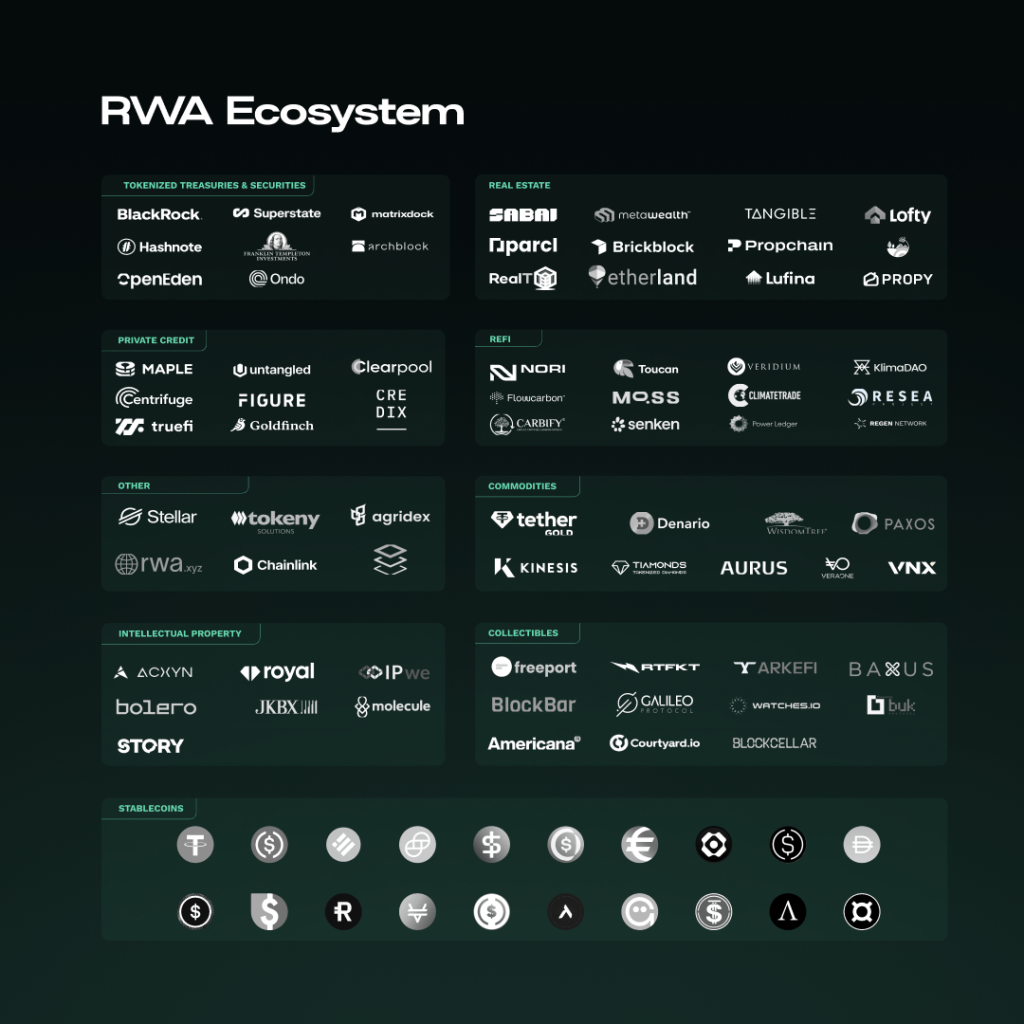
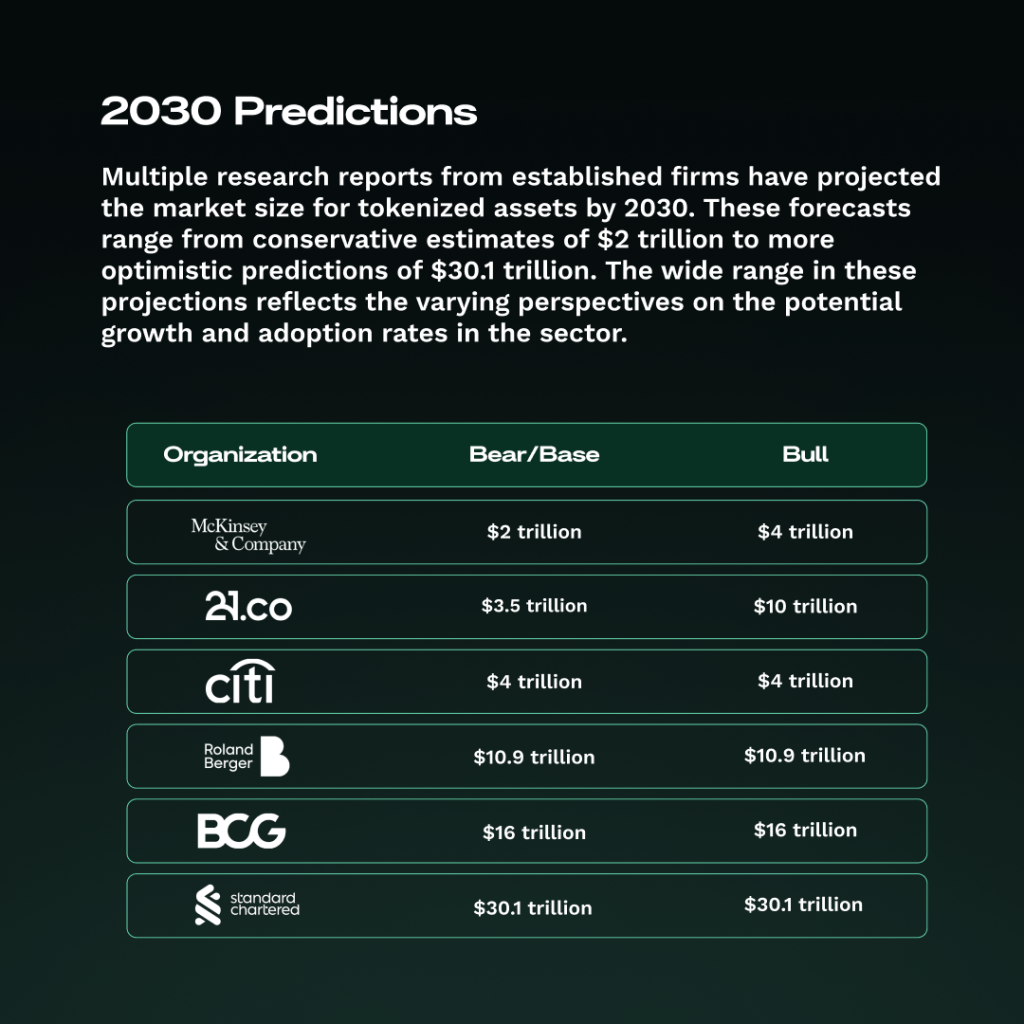
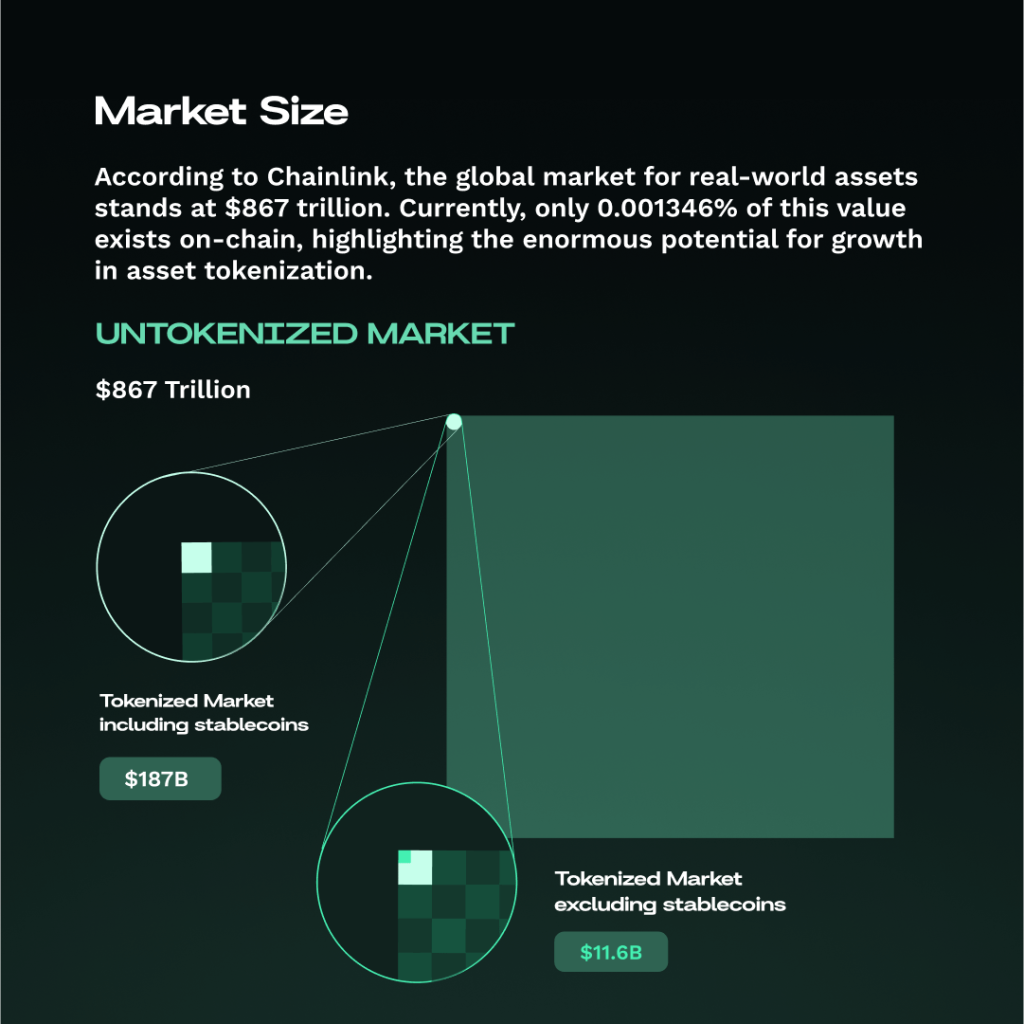
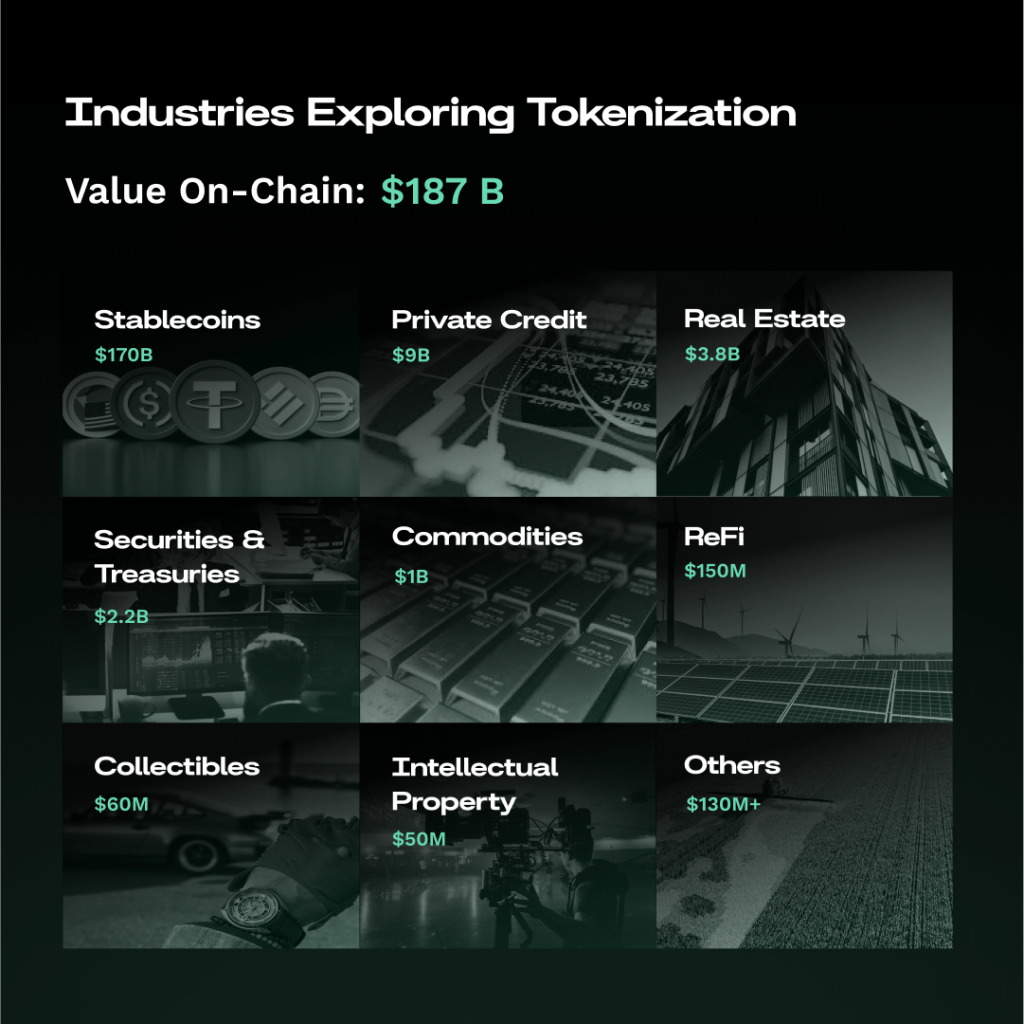
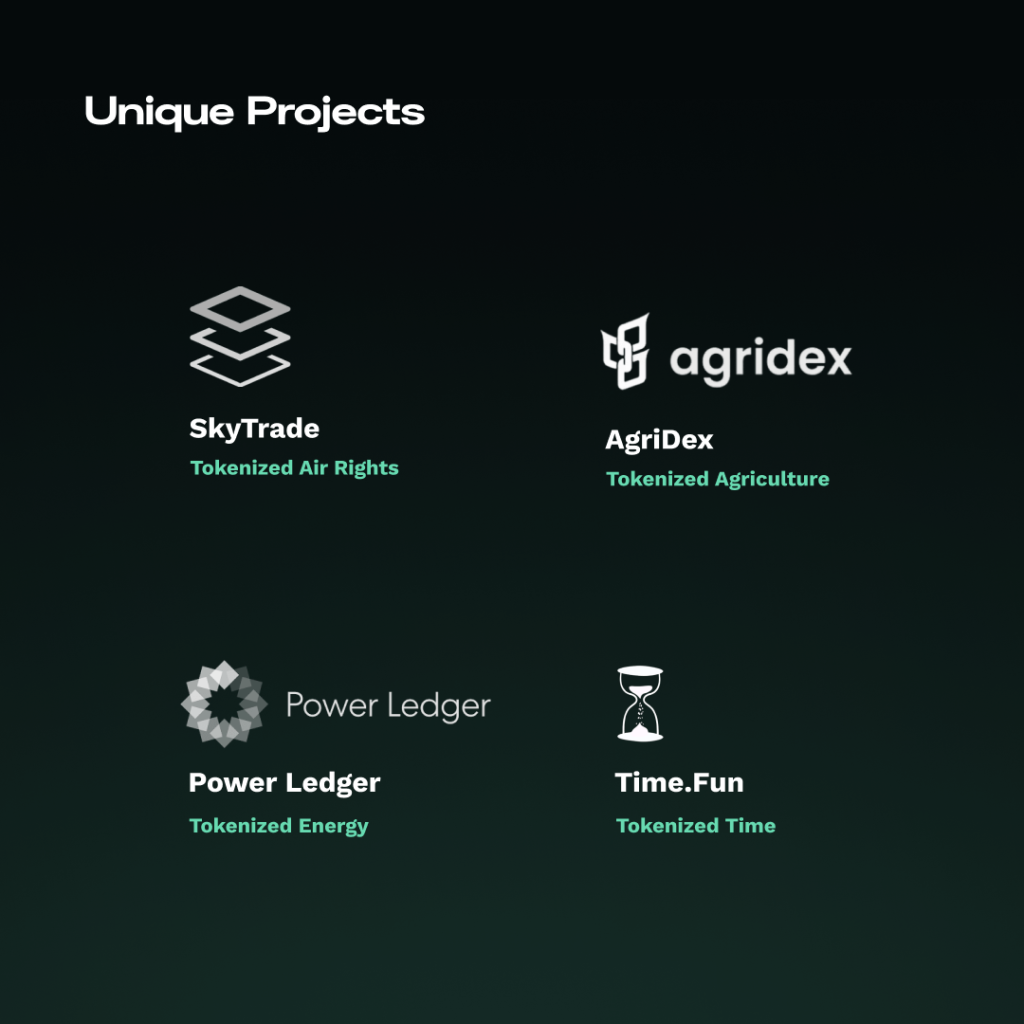
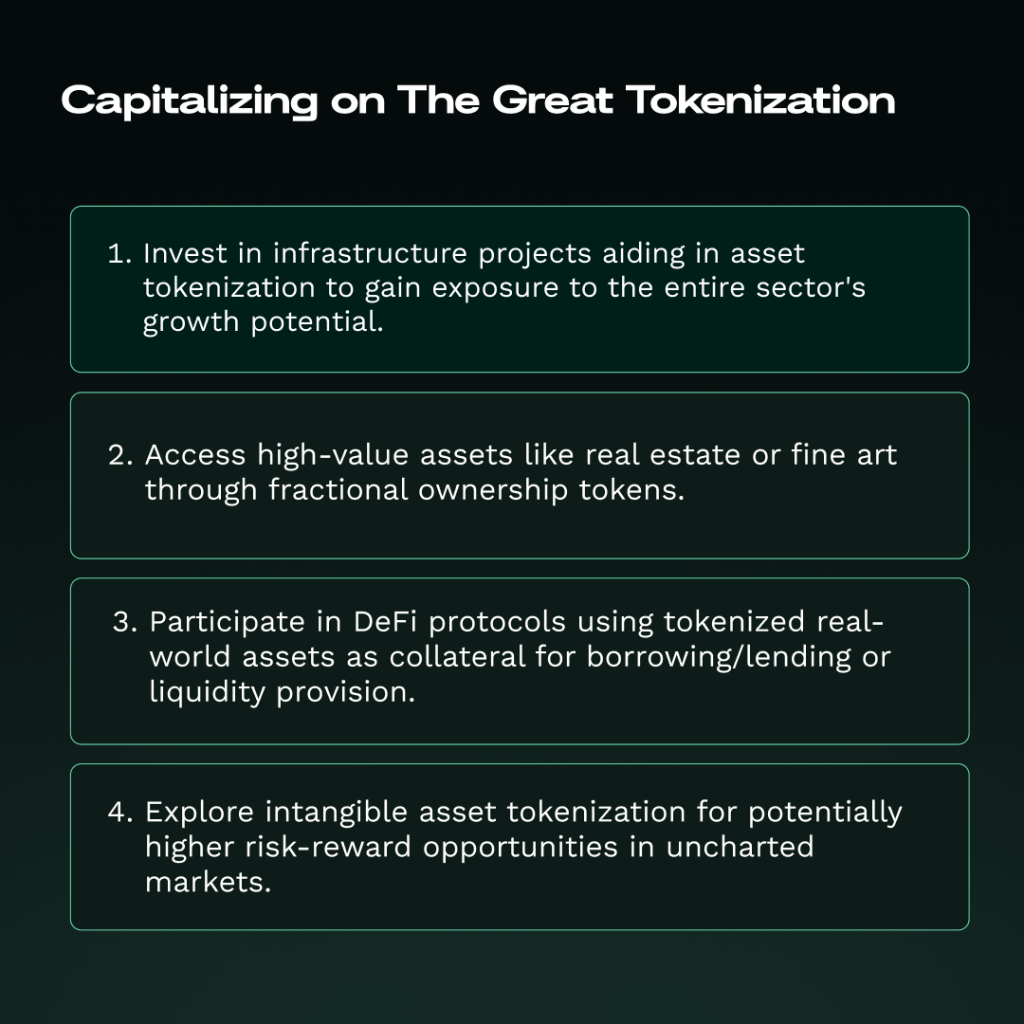
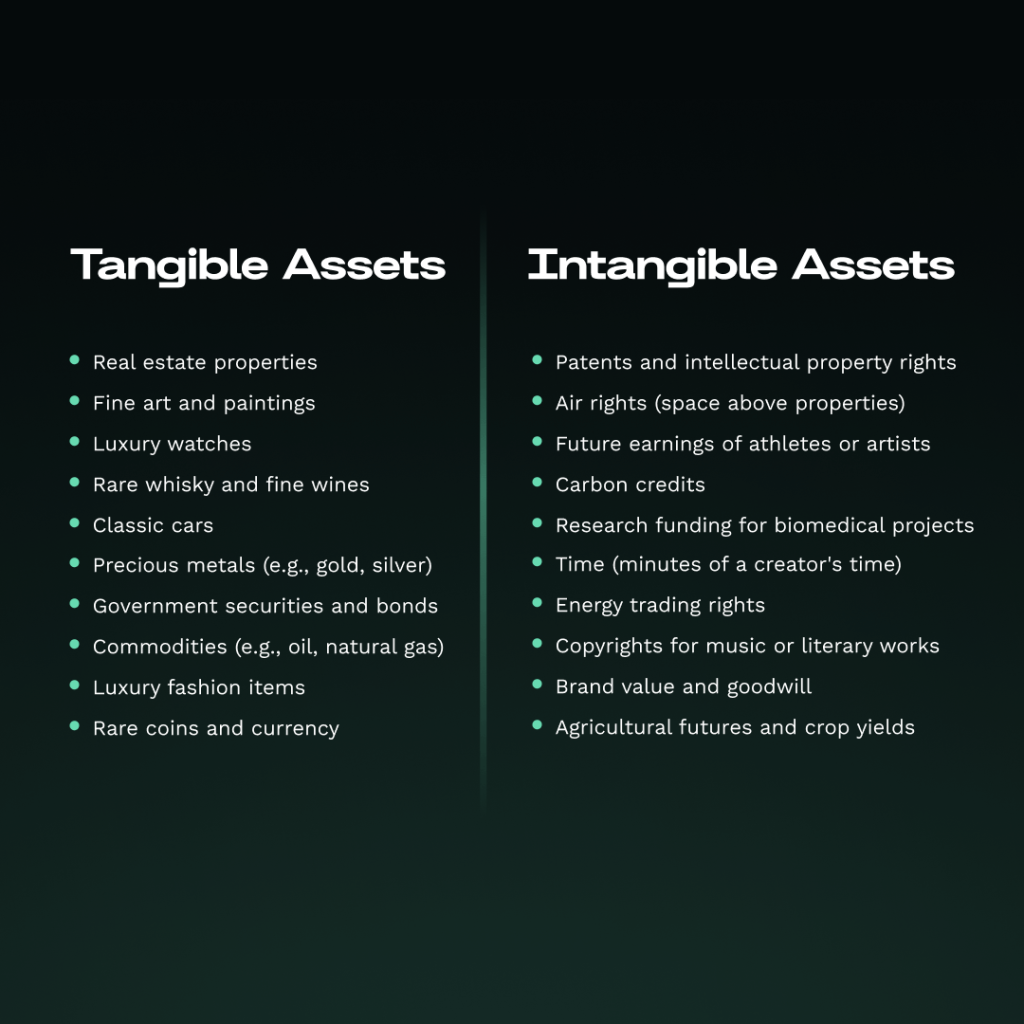
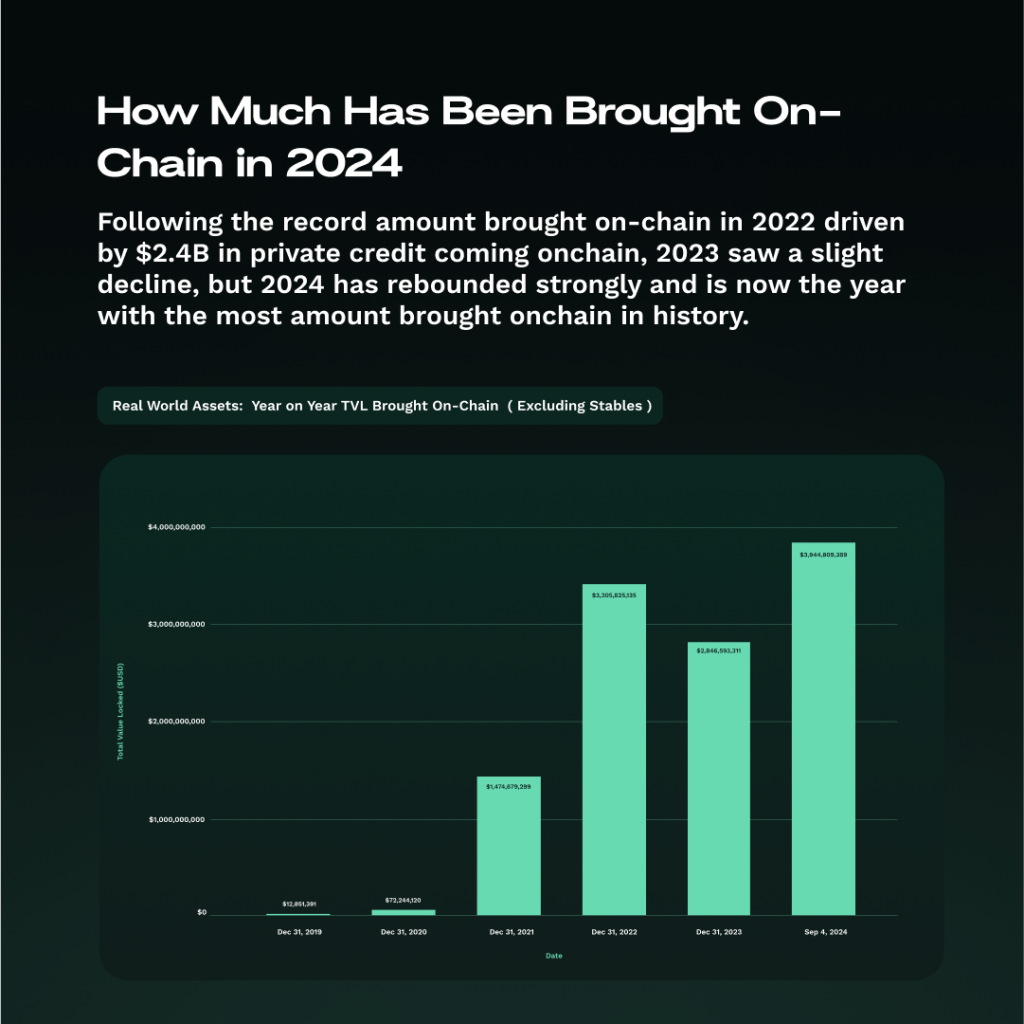
Imagine owning a slice of the air above Manhattan, and trading it like a stock. Picture yourself investing in a Picasso masterpiece for just $50, or buying a government bond with the tap of your smartphone, or purchasing 30 minutes of your favorite crypto personality’s time (which is tradable, and can go up or down in value). These aren’t wild futuristic ideas – they are a few of the interesting things happening right now.
The tokenization of real-world assets is unlocking markets previously inaccessible to most investors. Real estate ownership is being fractionalized, allowing investors to purchase shares in properties all over the globe for less than the cost of a nice dinner. Government securities, traditionally the domain of large institutional investors, are finding their way onto the blockchain, making these investments accessible to a broader audience. Tokenized energy, time, airspace, IP, mortages, car leases, carbon credits. you name it, if it’s an asset, tangible or intangible, someone is working to tokenizing it right now.
If you’re new to this idea: at its core, tokenization the process of converting rights to an asset – whether physical or digital, tangible or intangible – into a digital token on a blockchain. This seemingly simple concept is unleashing a world of possibilities, because of its four key benefits:
- Increased liquidity
- Fractional ownership
- Enhanced transparency
- Reduced transaction fees
The implications are vast and varied. In the world of scientific research, intellectual property rights are being tokenized, revolutionizing how biomedical studies are funded. The fine spirits market is experiencing a renaissance of authenticity and accessibility. Even precious metals like gold are being digitized, allowing investors to own and trade fractions of gold bars without ever touching the physical asset.
From real estate to rare whisky, from carbon credits to future earnings, the potential for tokenization appears boundless. It’s not only changing the way we invest but also reshaping our very concept of ownership and value.
In this report, we’ll dive into the world of tokenization and its far-reaching implications. We’ll explore unique projects, examine the technologies driving this revolution, and peek into the future of asset ownership and trading. Let’s explore how The Great Tokenization is redefining the global financial landscape in ways we’ve never seen before.
Part 1
The Great Tokenization: Trillion Dollar Opportunity
Hundreds of trillions of dollars worth of assets could potentially be tokenized. At the time of writing, roughly $185bn (including stablecoins) has been tokenized according to RWA.xyz — naturally people are wondering: what’s this all about, and how can one capitalize on the great tokenization?
Why Blockchain? The Foundation of Tokenization
Crypto sometimes has a reputation of being a solution looking for a problem. When it comes to the tokenization of assets, the benefits are clear. It’s a better solution than the existing one. Why is blockchain so crucial to this transformation? Traditional asset management has long been plagued by significant problems that frustrate investors, issuers, and regulators alike. Lack of transparency in private markets leads to mispricing and increased risk. Illiquidity in high-value assets like real estate or fine art ties up capital for extended periods. High barriers to entry exclude small investors from diversification opportunities. Inefficient processes involving multiple intermediaries result in slow, costly, and error-prone transactions. Limited trading hours prevent quick reactions to global events, while opaque markets leave room for fraud and manipulation.
Blockchains offer solutions to these long-standing issues. It brings a level of transparency and security previously unattainable, recording all transactions on a public ledger that’s immutable and accessible to all participants. This openness builds trust but also significantly reduces the potential for fraud, addressing the opacity that has long characterized many asset markets.
Perhaps the most revolutionary aspect of blockchain-based assets is their enhanced tradability. The technology enables round-the-clock trading, breaking free from the constraints of time zones and reducing reliance on intermediaries. This continuous market activity breathes new life into traditionally illiquid assets. Imagine being able to trade a fraction of a real estate property as easily as you would a stock – that’s the power of tokenization.
But the benefits don’t stop at transparency and tradability. Blockchain’s programmability, through smart contracts, opens up a world of possibilities for asset management and governance. Dividend distributions, voting rights, and other complex processes can be automated, increasing efficiency and creating new avenues for investor participation. This addresses the cumbersome nature of managing corporate actions in traditional systems.
These features combine to democratize investment opportunities in unprecedented ways. High-value assets that were once the exclusive domain of wealthy investors can now be divided into smaller, more accessible units. This fractional ownership model is expanding access to a diverse range of assets, from fine art to commercial real estate, allowing a broader spectrum of investors to build diversified portfolios and breaking down the high barriers to entry that have long excluded small investors.
Understanding The Benefits
Tokenization works by creating a digital representation of an asset on a blockchain. This could be anything from a piece of real estate to a work of art, or even intangible assets like intellectual property rights. Each token represents a share of ownership of the underlying asset, allowing for more granular and flexible ownership structures.
Tokenization Benefits - The Four Pillars
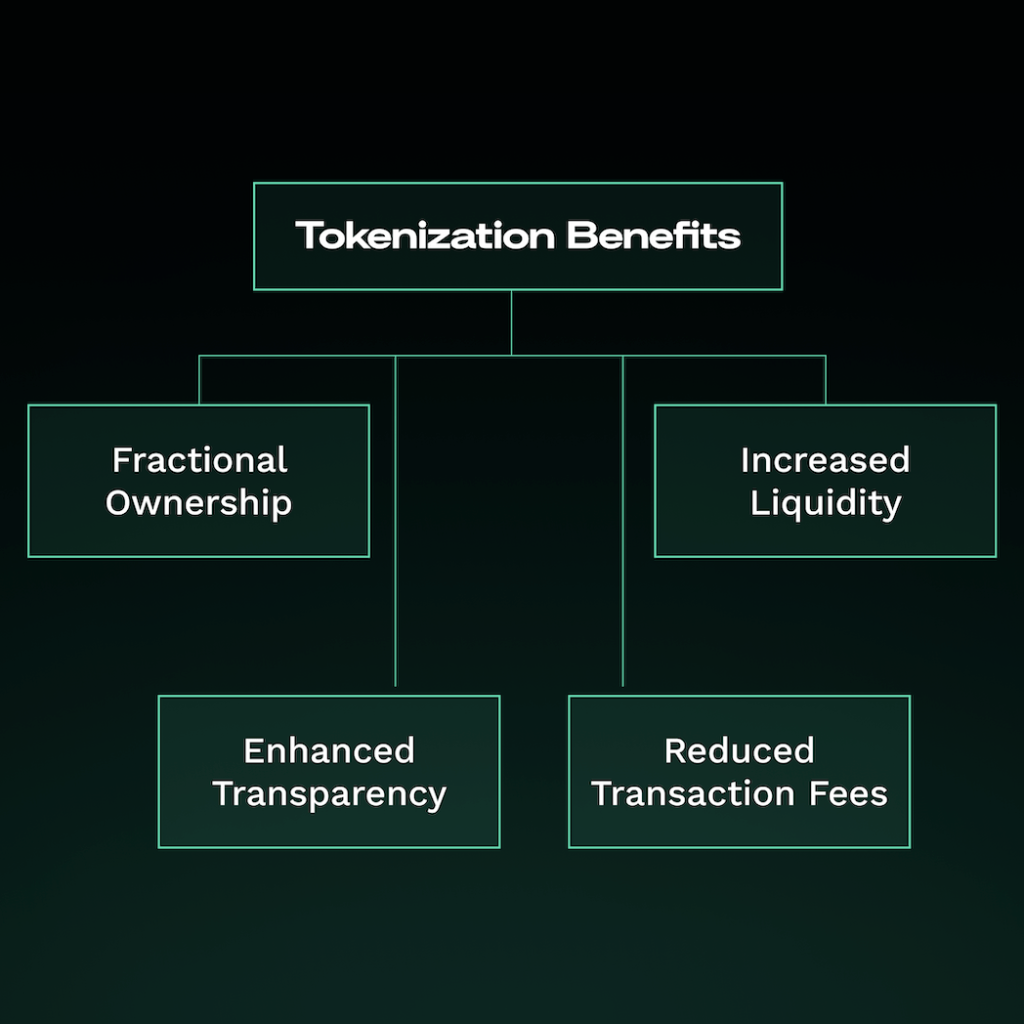
- Fractional Ownership: By dividing assets into smaller, more affordable units, tokenization democratizes access to investments that were previously out of reach for many. For example, instead of needing millions to invest in prime real estate, investors can purchase tokens representing a small fraction of the property.
- Enhanced Transparency: Blockchain technology provides an immutable record of all transactions. This increased transparency can reduce fraud, enhance trust, and simplify auditing processes.
- Reduced Transaction Fees: By streamlining processes and removing intermediaries, tokenization can significantly reduce the costs associated with asset transfers and management.
- Increased Liquidity: Tokenization can turn traditionally illiquid assets into easily tradeable digital tokens, potentially creating new, more liquid markets for a wide range of assets.
Tangible vs Intangible Assets
One of the really interesting aspects is the tokenization of intangible assets. These are assets that historically have not been easy to turn into liquid, tradable items. Through tokenization however, things such as a claim on a person’s time or intellectual property become liquid assets that owners can easily buy and sell.
Tangible Assets: Physical assets with a real, measurable value.
Intangible Assets: Non-physical assets that still hold value.
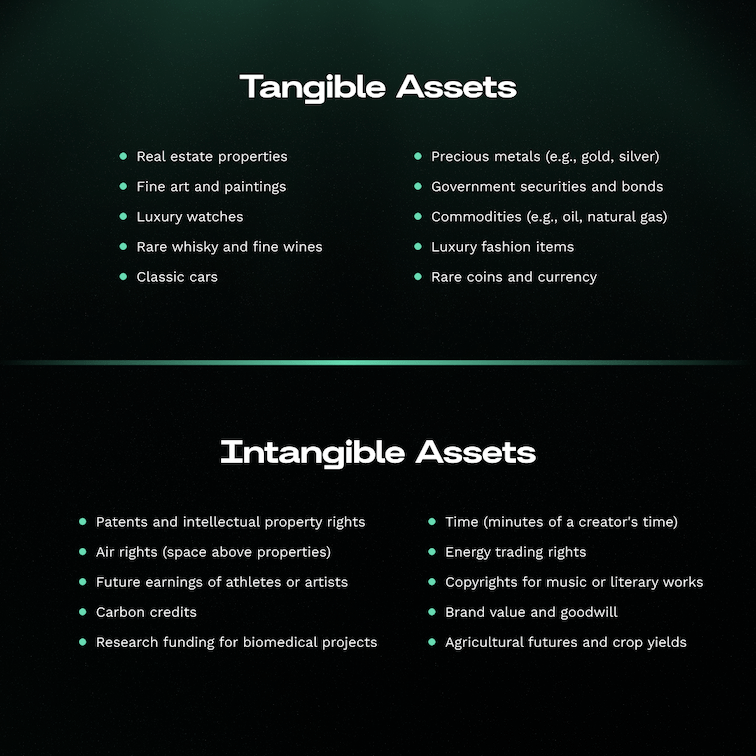
While tokenization of tangible assets like real estate and fine art is groundbreaking in its own right, what truly excites us, as mentioned above, is the potential for bringing intangible assets on-chain. These are assets we never before considered as having proper value exchange mechanisms. Intellectual property rights, future earnings, carbon credits, and even personal time are now being tokenized, creating entirely new markets and ways of perceiving value.
Imagine trading the future earnings of an up-and-coming artist, investing in the patent for a groundbreaking medical discovery, or buying a share in the carbon offset potential of a rainforest. These intangible assets, once difficult to quantify and trade, are now becoming accessible and liquid through tokenization.
As we move further into the era of The Great Tokenization, we can expect to see an increasing number of both tangible and intangible assets being tokenized. This shift promises to create more efficient and liquid markets across a wide range of industries, blurring the lines between physical and digital asset ownership.
Part 2
The Current State of Tokenization
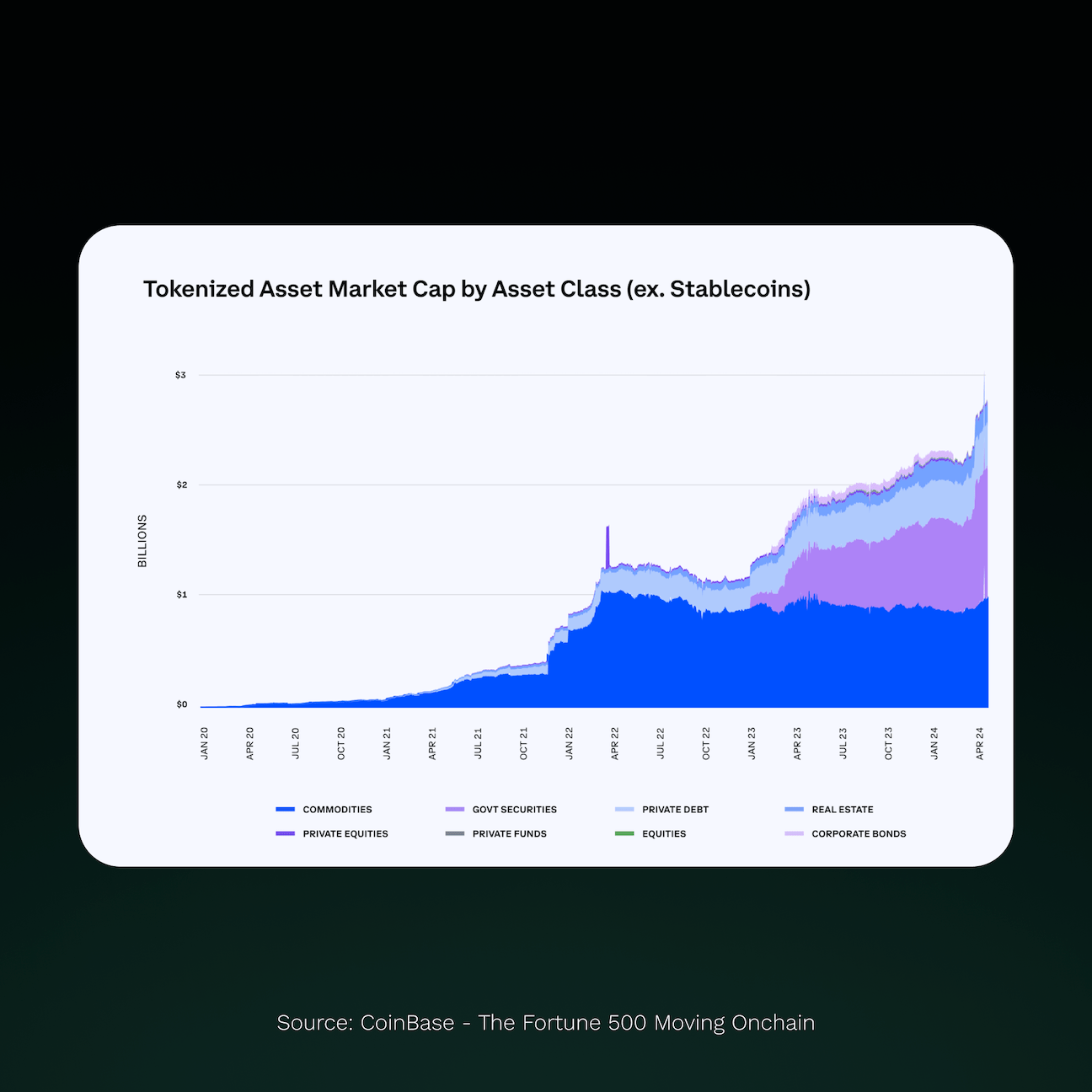
The reason we wanted to write this report in the first place was that, through our own research, we came to the conclusion that there is a lot more activity in the RWA tokenization space than we think most people realize. It’s exciting, and we wanted to bring more attention to the movement overall, as well as individual projects.
Recent projections paint a picture of explosive growth in the tokenization market. Estimates suggest that by 2030, tokenized assets could reach a market size of anywhere from $2 trillion to $10.9 trillion, depending on whose predictions you believe to be more accurate. Real estate, debt instruments, and investment funds are expected to lead this charge, emerging as the top three tokenized asset classes.
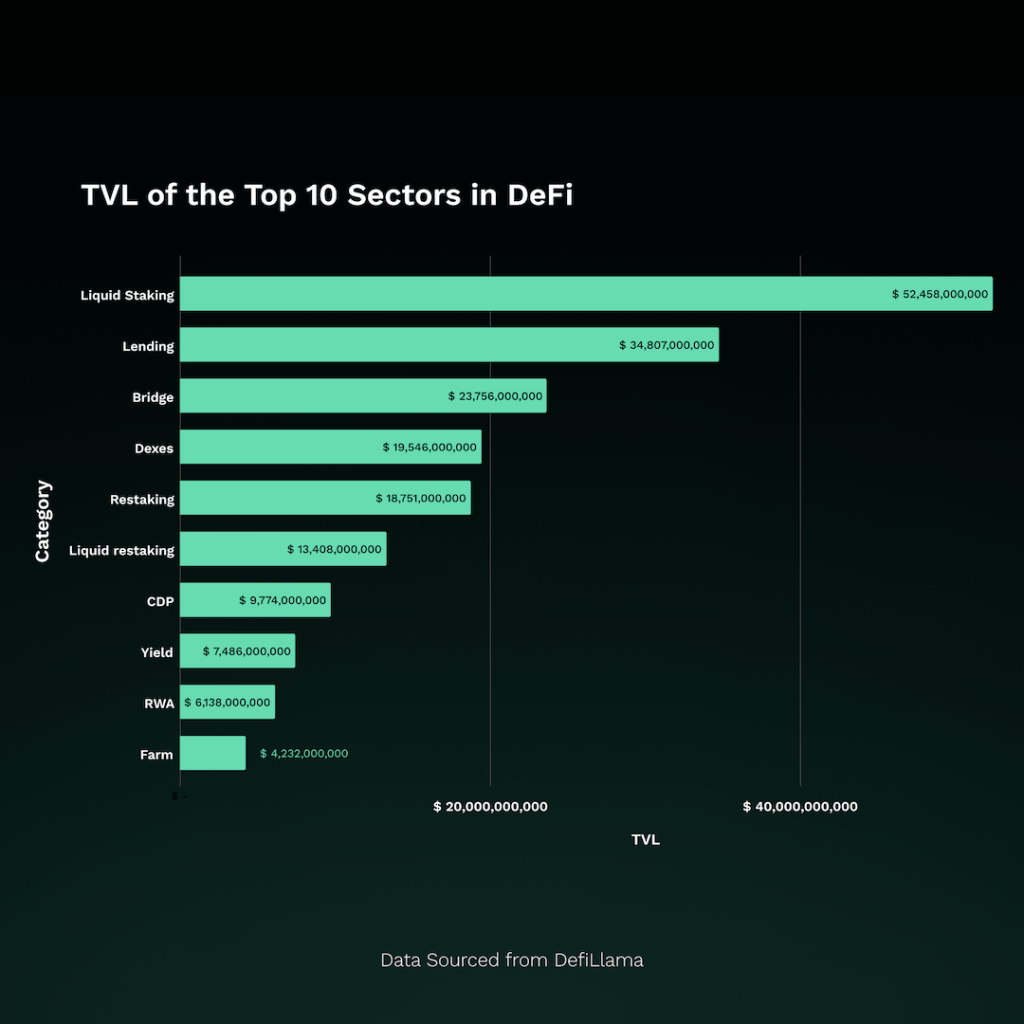
The impact of tokenization is already being felt in the DeFi sector. As of 2024, Real World Assets have carved out a significant niche, representing the 9th largest sector in DeFi with a Total Value Locked of $6.13 billion. This figure is a testament to the growing confidence in tokenized assets and their ability to bridge the gap between traditional finance and DeFi.
Ecosystem Overview
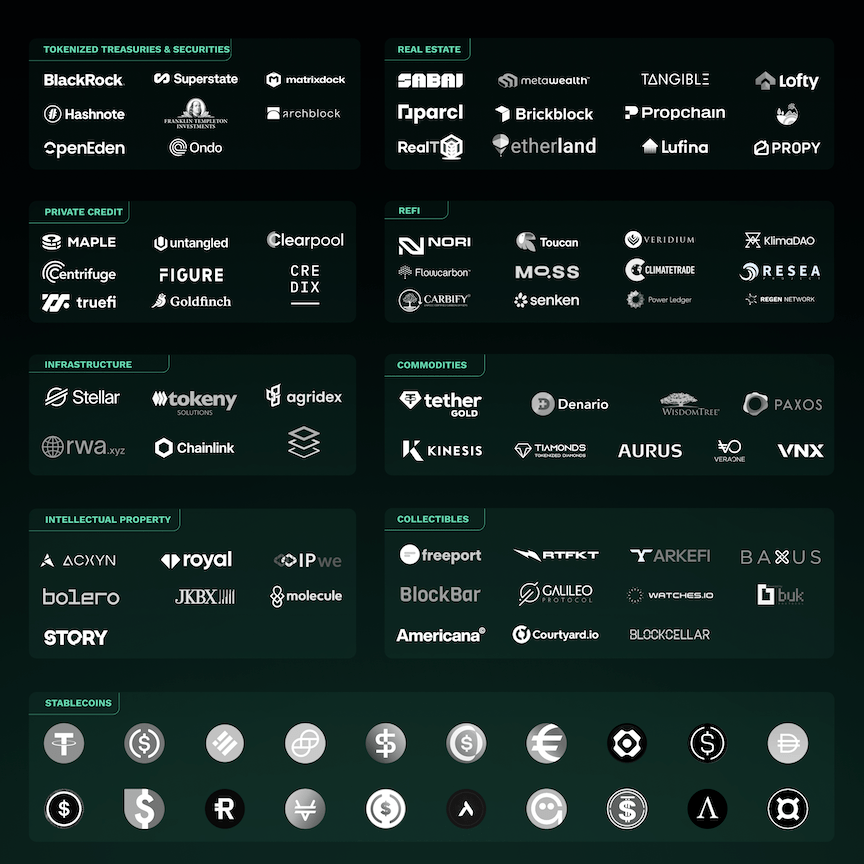
The RWA ecosystem is rapidly evolving, featuring a diverse range of projects that are bringing traditional assets onto the blockchain. This sector spans from conventional financial instruments such as tokenized treasuries and securities to more unconventional developments like tokenized intellectual property. Projects in this ecosystem are working to tokenize everything from private credit and real estate to commodities and high-value collectibles, highlighting the versatility of blockchain technology in reimagining how assets are owned and traded.
What makes this ecosystem particularly exciting is its potential to transform traditional markets by increasing accessibility, liquidity, and efficiency. Whether it’s enabling fractional ownership of premium real estate, democratizing access to fine art investments, or creating new ways to trade commodities, these projects are pushing the boundaries of what’s possible in finance and asset management. As the space continues to mature, we’re seeing an increasing convergence between traditional finance and blockchain technology, with stablecoins backed by real-world assets serving as a bridge between these two worlds. This dynamic and rapidly growing ecosystem reflects the broad potential of blockchain to revolutionize how we perceive, value, and trade assets in the global economy.
Now, let’s take a deep dive at some key sectors embracing tokenization.
Infrastructure
The blockchain ecosystem has witnessed significant advancements in recent years, particularly in scalability, security, and interoperability. These improvements have substantially reduced the barriers to adoption for both permissioned and permissionless ledgers. Enhancements in SDKs and tokenization standards have streamlined implementation processes, making it easier for various stakeholders to engage with blockchain technology.
This evolution in infrastructure has led to a surge in real-world assets being brought on-chain. Major financial market infrastructures like DTCC, Clearstream, and Euroclear are launching tokenization pilot projects, indicating a growing acceptance of blockchain technology in traditional finance. These developments have created a solid foundation for the tokenization of a wide range of assets, from real estate to financial instruments.
Current State: Infrastructure Outpacing Adoption
Despite the rapid development of infrastructure, we are currently at an interesting juncture where the technology seems to be ahead of widespread adoption. While the capability to tokenize and fractionalize various asset classes exists, many verticals are struggling to create liquid markets around these tokenized assets. This situation suggests that the opportunity for innovators now lies in building out applications to onboard buyers and create demand for tokenized assets, much like the situation in crypto in general.
Data Accessibility
One of the significant challenges in RWA tokenization is the migration of data from centralized infrastructures to blockchain-based systems. Projects like RWA.xyz are working to make this data readily available and easily accessible. This transition is crucial but complex, sort of like “changing the engine of a car while driving at full speed.” It requires careful management to ensure the security and continuity of daily operations while implementing the new infrastructure. In this context, oracle networks play a vital role in bridging the gap between off-chain data and on-chain smart contracts. Projects like Chainlink have become instrumental in providing reliable, tamper-proof data feeds that are essential for accurately representing and valuing real-world assets on blockchain networks.
The integration of oracle services enhances the reliability and functionality of tokenized assets by providing real-time, accurate data from the traditional financial world to blockchain networks. This includes price feeds, market data, and other crucial information that enables smart contracts to execute based on real-world events and conditions. As the RWA tokenization ecosystem matures, the role of oracles in maintaining the integrity and functionality of these digital representations of physical assets becomes increasingly critical. Their ability to provide secure, decentralized data bridges is fundamental to creating a trustworthy tokenized asset marketplace.
Regulation
Regulation plays a pivotal role in the adoption and growth of RWA tokenization. As the industry evolves, there is an increasing need for clear regulatory frameworks that can accommodate the unique aspects of blockchain-based assets. Major financial institutions are driving conversations with regulatory authorities, as evidenced by industry papers like “Advancing the digital asset era, together” (September 2023). These discussions are crucial for establishing a balanced regulatory environment that encourages innovation while ensuring investor protection.
Looking ahead, several key trends and developments are likely to shape the future of RWA tokenization infrastructure:
- Shift to Specialized Infrastructure: As tokenization becomes more prevalent, we anticipate a move from general-purpose to use case-specific tokenization infrastructure. This shift will enable more robust and tailored solutions for specific applications and asset classes.
- Improved Buyer Onboarding: There is a growing need for infrastructure improvements to facilitate the onboarding of buyers, particularly in emerging asset markets. This will be crucial for creating liquid markets for tokenized assets.
- Enhanced Cross-Chain Capabilities: As the ecosystem expands, improvements in cross-chain interoperability will become essential to provide token holders with a frictionless experience when navigating across different blockchain networks.
- Modular Architecture: The industry is moving towards a more modular architecture, aiming to enhance interoperability, spur innovation, enable customization, and create a seamless ecosystem.
- Flexibility and Agility: As the technology landscape evolves, founders and developers in this space need to maintain flexibility. Different components of the existing stack may emerge as more preferred or effective, necessitating adaptability in approaches.
While significant progress has been made in developing the infrastructure for RWA tokenization, there is still a long way to go before the full scope of The Great Tokenization can be realized. The focus is now shifting towards creating more specialized applications, improving market liquidity, and addressing regulatory challenges. As these areas develop, we can expect to see a more mature and widely adopted RWA tokenization ecosystem emerge.
Infrastructure Examples
Let’s look at some of the infrastructure projects that are specifically focused on the RWA space.
Chainlink
Chainlink is a decentralized oracle network that plays a crucial role in connecting blockchain-based smart contracts with real-world data and off-chain systems. Founded in 2017, Chainlink has positioned itself as a critical infrastructure provider for the emerging tokenized economy, facilitating the secure and reliable transfer of information between on-chain and off-chain environments.
At its core, Chainlink offers a suite of services designed to support the tokenization of real-world assets (RWAs) and enable their integration into blockchain ecosystems. These services include:
- Proof of Reserve: This feature provides autonomous, reliable, and timely verifications of cross-chain or off-chain reserves backing tokenized assets. It enhances transparency and allows for the implementation of circuit breakers to protect users if discrepancies arise between off-chain assets and their tokenized counterparts.
- Data Feeds and Data Streams: Chainlink offers secure and decentralized sources of financial market data covering commodities, equities, forex, indices, and cryptocurrencies. This real-time information is crucial for accurately pricing and managing tokenized assets.
- Cross-Chain Interoperability Protocol (CCIP): This protocol enables the secure transfer of data and assets across different blockchain networks, addressing the fragmentation issues in the blockchain space and facilitating seamless interactions between various tokenized assets.
- Functions: This service allows any off-chain event or data to be synchronized or published on-chain, including corporate actions, proxy voting, ESG data, dividends, and net asset values (NAV). This capability is essential for maintaining up-to-date information on tokenized assets.
Chainlink’s current efforts in aiding tokenization are evident through its collaborations with major financial institutions and market infrastructure providers. For instance, Chainlink has worked with SWIFT, the global messaging system for financial institutions, to demonstrate interoperability between blockchain networks and traditional banking systems. The company has also partnered with the Depository Trust & Clearing Corporation (DTCC) to explore bringing capital markets on-chain.
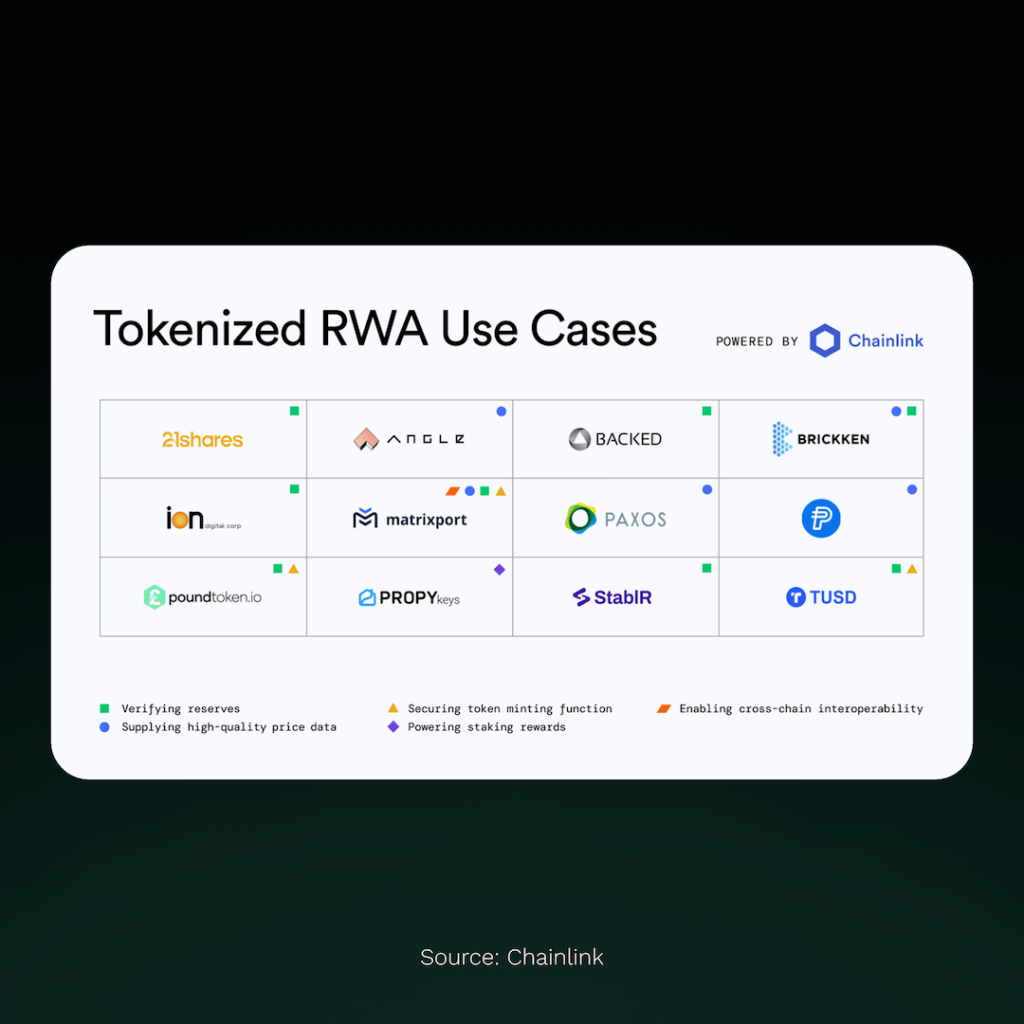
Chainlink’s role in real-world asset tokenization is demonstrated through its partnerships across blockchain projects. The image above illustrates how protocols utilize Chainlink’s services for RWA-related functions. These functions include reserve verification, price data provision, token minting security, cross-chain interoperability, and staking reward calculation. This range of applications indicates Chainlink’s position in supporting RWA tokenization infrastructure across multiple blockchain use cases.
Chainlink’s importance in the future of bringing assets on-chain stems from several factors:
- Trust and Reliability: With over $14 trillion in total transaction value enabled since 2022, Chainlink has demonstrated its capacity to handle large-scale financial operations securely.
- Interoperability: As the tokenized asset ecosystem grows across multiple blockchains, Chainlink’s CCIP will be crucial in enabling seamless cross-chain interactions and liquidity.
- Data Integrity: The ability to provide accurate, real-time data from off-chain sources is vital for maintaining the value and functionality of tokenized assets.
- Compliance and Identity: As regulatory scrutiny increases, Chainlink’s development of privacy-preserving identity solutions like DECO will be essential for ensuring compliant transactions in the tokenized asset space.
- Scalability: Chainlink’s infrastructure is designed to scale, making it capable of supporting a growing ecosystem of tokenized assets across various sectors.
Chainlink’s suite of services, established partnerships, and proven track record position it as a key enabler in the ongoing transition towards a tokenized economy. As the bridge between traditional finance and blockchain technology, Chainlink is set to play a crucial role in unlocking the full potential of real-world asset tokenization.
Stellar Foundation
Stellar, launched in 2014, is a blockchain network designed for efficient cross-border transactions and asset tokenization. The platform has grown to over 8 million accounts and developed a infrastructure for handling real-world assets. Stellar’s focus on transaction efficiency is reflected in its average transaction cost of $0.000065, which facilitated 460 million transactions in the first quarter of 2024.
Stellar’s capacity for tokenizing and managing RWAs has led to partnerships with established financial institutions. MoneyGram and Circle utilize Stellar for cross-border payments, while Franklin Templeton has implemented its BENJI token and money market fund on the platform. Additionally, WisdomTree has issued 13 regulated funds, a digital gold token, and a digital dollar on Stellar, all under US regulations, with a growing supply of around $23 million USD. The Stellar ecosystem’s RWA metrics indicate growth, with a total asset supply of over $533 million and an RWA payments volume of $1.6 billion, illustrating its role in integrating traditional finance with blockchain technology.
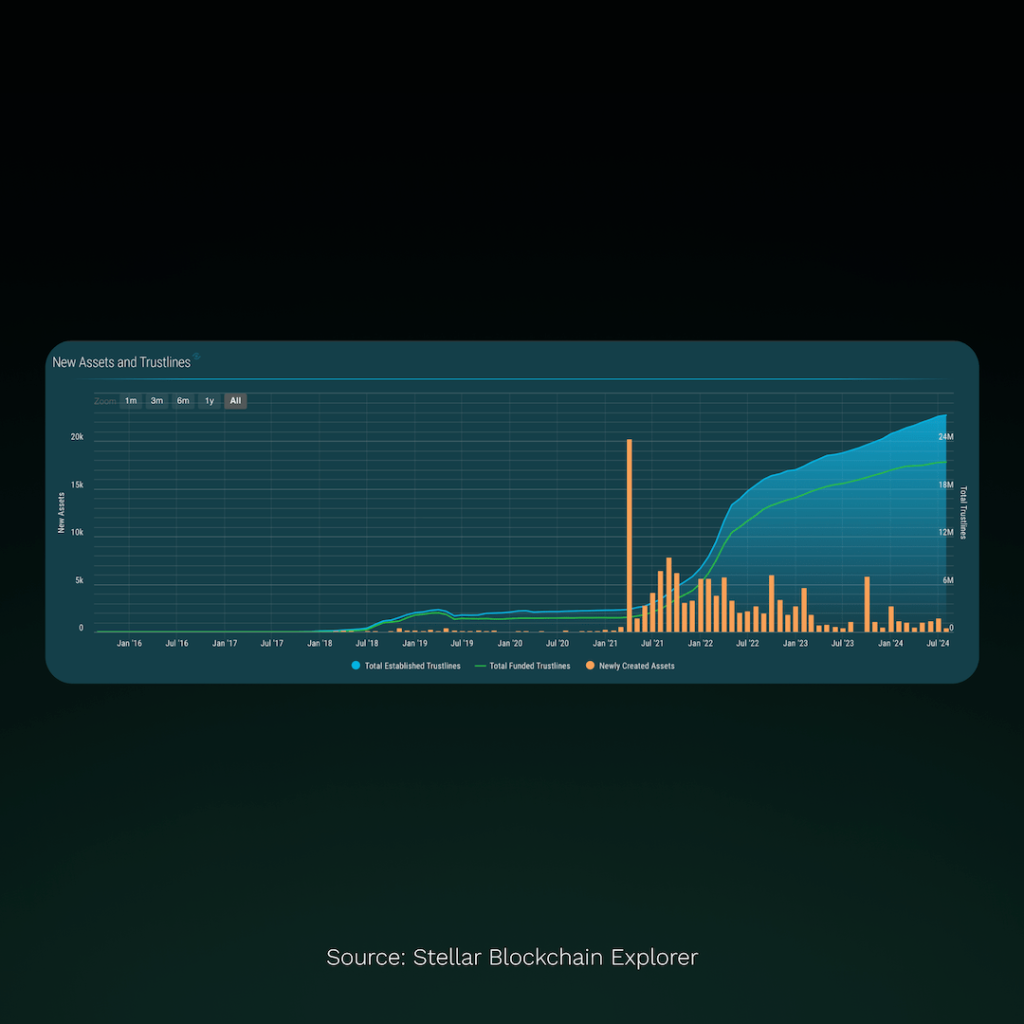
A key feature of Stellar’s architecture is the concept of trustlines. A trustline is essentially a connection between two accounts that allows them to hold and transact in a specific asset. Before an account can receive any asset other than the native XLM, it must establish a trustline with the issuing account. This mechanism enables Stellar to support a wide variety of assets while maintaining user control over which assets they interact with. The chart above provides insight into the growth of Stellar’s ecosystem. It shows a significant increase in total established trustlines and funded trustlines starting from mid-2020, with the number of trustlines reaching over 20 million by 2024. This trend indicates growing adoption and utilization of various assets on the Stellar network. The sporadic spikes in newly created assets suggest periodic waves of new token issuances or projects joining the Stellar ecosystem.
Projects are attracted to Stellar for its asset tokenization infrastructure and its potential to adapt traditional financial products. The Franklin OnChain U.S. Government Money Fund on Stellar demonstrates the platform’s applicability in making financial markets more accessible. This aligns with Stellar’s stated mission of creating a more inclusive financial system, as noted by Denelle Dixon, CEO and Executive Director of the Stellar Development Foundation.
Stellar has supported basic smart contract functionality since its inception, but the introduction of Soroban, its advanced smart contracts platform, in March 2024 represents a significant development. This upgrade expands the potential use cases for the network, allowing for more complex decentralized applications to be built on Stellar. Soroban addresses limitations in Stellar’s previous smart contract capabilities, which were primarily used for basic functions like multi-signature transactions and atomic swaps. The new platform offers improved features including reduced transaction fees, increased scalability, and built-in contracts and host functionality. These enhancements position Stellar to compete more effectively in the smart contract space and potentially develop a more comprehensive DeFi ecosystem.
To support the adoption of Soroban, the Stellar Development Foundation has committed $100 million to projects building on the platform. This investment indicates Stellar’s focus on expanding its smart contract capabilities and serves as an incentive for developers to explore the network’s potential. As Stellar continues to evolve, it may play an increasingly significant role in the development of tokenized assets and decentralized finance applications.
Here’s a nice video from Stellar showing the real life impact of their work.

“We’re proud of all we’ve built with our ecosystem partners regarding payments and RWA capabilities. It’s only by merging those capabilities, real world assets and real world payment channels that we can truly enable financial equality and wealth preservation in much needed regions and demographics across the globe.”
Rob Durscki,
Senior Director of RWA Tokenization at Stellar Foundation
re.al
re.al, an EVM Layer 2 solution, launched its mainnet in May 2024, positioning itself as a dedicated platform for RWAs and DeFi. Built on Arbitrum Orbit technology, re.al aims to provide a permissionless environment for RWA tokenization and trading, addressing key challenges in traditional markets.
The platform’s architecture incorporates several key features designed to enhance its functionality and efficiency. At its core, reETH serves as the native gas token, accruing value through underlying ETH staking. re.al’s modular structure allows for potential future upgrades, ensuring adaptability in the evolving blockchain landscape. The initial configuration utilizes the Arbitrum Data Availability Committee (DAC) for transaction settlement, striking a balance between speed and cost efficiency.
In its first three months post-launch, re.al demonstrated promising traction, reporting a Total Value Locked of $76.75 million by August 2024. This TVL is distributed across several protocols within the re.al ecosystem, including Tangible, veRWA, Pearl, Arcana, and Stack. With 2,170 user accounts and 1.3 million processed transactions, the platform shows notable early adoption, though these figures represent a small fraction of the broader L2 and DeFi markets.
re.al’s focus on RWAs distinguishes it in the L2 landscape, aiming to address challenges such as limited liquidity and high barriers to entry by enabling fractional ownership and increased tradability. However, this specialization presents unique challenges, particularly in navigating the complex regulatory considerations involved in integrating real-world assets with blockchain technology.
The platform’s governance token, RWA, incorporates an innovative approach to L2 tokenomics. Utilizing a vote-escrow model (veRWA) for ecosystem participation and revenue sharing, re.al launched with 100% of the token supply in circulation and no future VC unlocks. The deflationary model, where tokens are burned when veRWA positions are unlocked early, aims to create scarcity over time. RWA accrues 100% of chain profits from transaction fees, with protocols on re.al sharing a portion of their fees with veRWA holders. This approach aligns long-term holder interests with the platform’s development, though its effectiveness in practice remains to be seen over a longer period.
As re.al continues to evolve, critical factors to monitor include its ability to attract and retain liquidity, navigate complex regulatory landscapes, and scale efficiently while maintaining security. The platform’s long-term viability and impact will depend on its ability to effectively bridge traditional finance with blockchain technology, all while competing in an increasingly crowded L2 market. re.al’s unique approach to tokenomics and RWA integration may prove to be key differentiators in its quest for widespread adoption in the emerging tokenized real-world assets market.

“Tokenized Real World Assets currently represent a $6.5 billion market, but we believe their true potential is yet to be realized. Tokenizing RWAs and bringing them onto the blockchain offers numerous advantages: transactions become faster, easier, free from third-party intermediaries, and unrestricted by geographical boundaries.
DeFi innovations have already revolutionized finance, and when combined with RWA tokenization, the possibilities are endless. At re.al, we bridge these two worlds by merging RWA tokenization with a DeFi ecosystem specifically tailored for RWAs. This unique combination enhances composability, boosts capital efficiency, and introduces new financial primitives designed for this emerging category.”
Christian Santagata
Product Marketing Manager at re.al
Plume Network
Plume Network, launched in 2024, represents a novel approach to bringing real-world assets onto the blockchain through a specialized Layer 2 solution. Built on the Arbitrum Nitro stack and leveraging Celestia for data availability, Plume aims to create a more efficient and cost-effective environment for RWA tokenization and trading. The platform’s unique selling proposition lies in its integrated compliance tools and focus on regulatory adherence, addressing key concerns in the RWA space.
At the core of Plume’s offering is its support for multiple token standards, including ERC-3643, which is specifically designed for regulated securities. This standard incorporates built-in compliance features such as transfer restrictions and identity management, making it particularly suitable for tokenized RWAs. By integrating these standards directly into its infrastructure, Plume simplifies the process of bringing regulated assets on-chain while maintaining necessary compliance measures.
The platform’s architecture is designed to significantly reduce gas costs for RWA-related operations. By optimizing the execution of common RWA functions and leveraging Celestia’s data availability solution, Plume expects to achieve a 99.9% reduction in gas fees compared to traditional Ethereum transactions. This cost efficiency could prove crucial in attracting a wide range of RWA projects and investors to the platform, potentially catalyzing greater adoption of tokenized real-world assets.
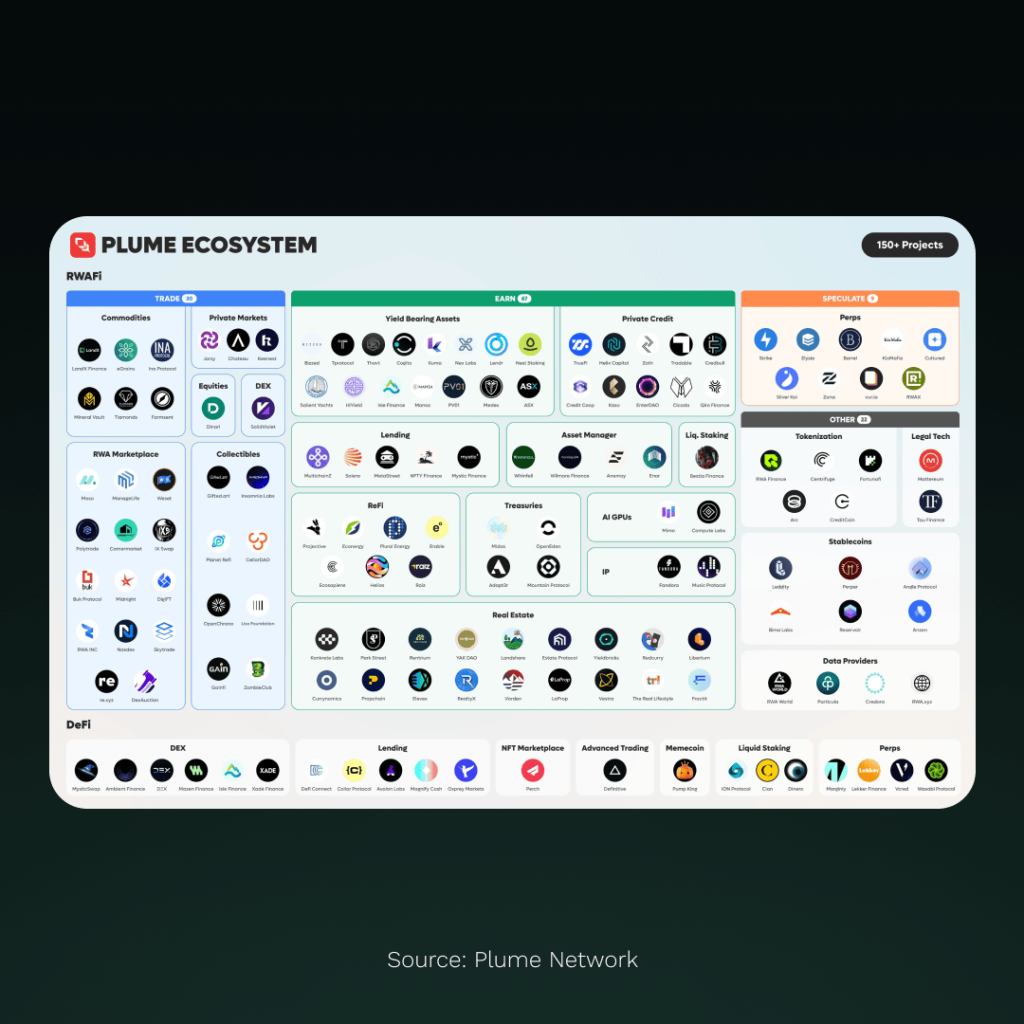
As of September 2024, Plume was still in its testnet phase but has already attracted over 150 RWA and DeFi projects to its ecosystem. These projects span a diverse range of assets, including collectibles, luxury goods, real estate, and more traditional financial instruments. The platform’s ability to support such a wide array of asset types demonstrates its flexibility and potential to become a comprehensive solution for the RWA market.
Looking ahead, Plume’s success will largely depend on its ability to navigate the complex regulatory landscape surrounding RWAs while maintaining the decentralized ethos of blockchain technology. The platform’s focus on compliance and its partnership with established players in both traditional finance and the crypto space position it well to tackle these challenges. However, as with any new entrant in the rapidly evolving L2 and RWA markets, Plume will need to prove its long-term viability and ability to compete with both established financial systems and other blockchain solutions targeting the RWA space.

“For the first time, we’re building a fully composable Real World Asset Finance (RWAfi) ecosystem centered around RWAs and DeFi, all within one unified and integrated platform. We provide an end-to-end tokenization engine and a seamless plug-and-play financial infrastructure for builders to create tangible value both onchain and offchain. With over 165 applications and teams onboard, we’re witnessing ‘The Great Tokenization’ in action—unlocking access to asset ownership, trading, and liquidity across a diverse array of markets, from real estate to intellectual property, in ways that were once unimaginable.”
Chris Yin
CEO & Founder at Plume Network
Mode Network
Mode is an Ethereum Layer 2 building as the DeFi hub of the Optimism Superchain. Mode boasts an innovative, aggressive ecosystem of talented DeFi builders and researchers.The dApps and initiatives are representative of this culture, including assets woven across multiple dApps to stack yield, bespoke AI products to abstract away the process of finding opportunities and managing positions, and a governance model that uses classic DeFi power games to align and direct incentives.
Amongst Mode’s many progressive DeFi initiatives, is the effort to build a native yield layer, ensuring most DeFi strategies have a base layer of appreciation. Chains like Blast have implemented this strategy transforming non-yield bearing assets on their bridge into the likes of sDAI and stETH, and rebranding the assets on the native chain. Mode is taking a different approach, while adhering to Superchain standards.
Although RWAs are a minor piece in this overall architecture, Mode’s design of their native yield layer illustrates how RWAs can be a critical piece in the bottom layer of the stack, especially when the objective is to create predictable, reliable yield for market participants.
Tokeny
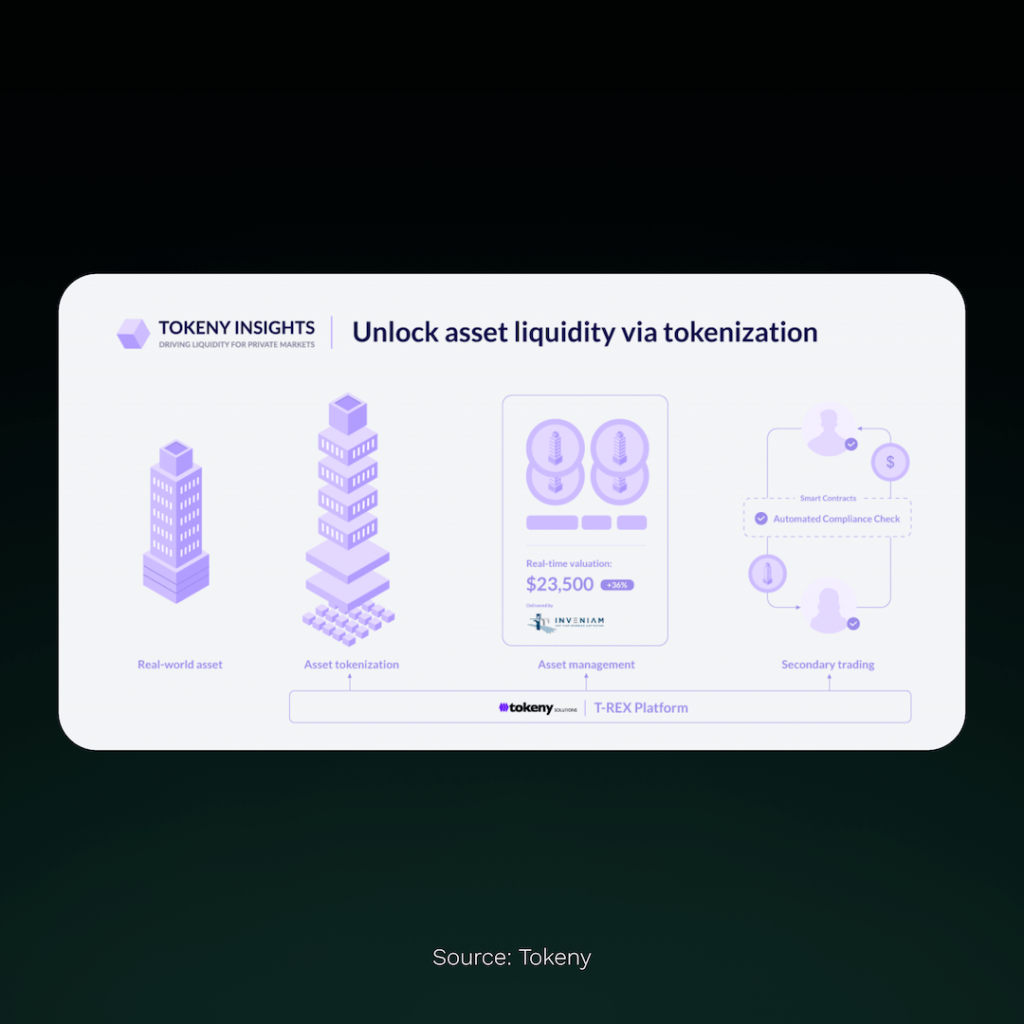
Tokeny Solutions, founded in 2017, develops tokenization infrastructure for the issuance and management of security tokens and regulated digital assets. The company created the T-REX (Token for Regulated EXchanges) protocol to address challenges in bringing real-world assets on-chain while maintaining regulatory compliance.
Central to Tokeny’s offering is the ERC-3643 token standard, designed for permissioned tokens suitable for regulated securities. ERC-3643 incorporates identity management and transfer restrictions directly into token smart contracts, allowing issuers to enforce investor eligibility, KYC/AML checks, and compliance rules on-chain.
Key features of Tokeny’s infrastructure include:
- On-chain identity management via ONCHAINID
- Customizable modular compliance rules
- Recovery mechanisms for lost private keys
- Support for corporate actions such as dividends and voting
As of 2024, Tokeny’s platform has facilitated the tokenization of over $28 billion in assets across more than 60 jurisdictions. Their technology has been used for tokenization projects in real estate, private equity, bonds, and carbon credits.
BlocHome, a real estate tokenization project using Tokeny’s technology, reported a 90% reduction in administrative costs. In another implementation, ABN AMRO used Tokeny to issue a €5 million tokenized green bond on the Polygon blockchain.
Tokeny’s infrastructure aims to increase liquidity and create new opportunities in private markets by enabling compliant on-chain representation of real-world assets. Their open-source approach with ERC-3643 contributes to standardization efforts in the tokenization sector.
As the tokenization market grows, Tokeny’s role as an infrastructure provider bridges aspects of traditional finance with blockchain technology. The continued development of ERC-3643 and related standards may influence the evolution of tokenized securities.
Government Securities
Government securities, also known as sovereign debt or government bonds, are debt instruments issued by a country’s government to finance its operations. These financial instruments are considered among the safest investments available, as they are backed by the full faith and credit of the issuing government. Currently, the primary buyers of government securities are institutional investors such as banks, pension funds, and insurance companies, as well as foreign governments and central banks.
There are several types of government securities, each serving different purposes and catering to various investor needs:
- Treasury Bills (T-Bills): Short-term securities that mature in one year or less.
- Treasury Notes: Medium-term securities with maturities between two and ten years.
- Treasury Bonds: Long-term securities with maturities of 20 or 30 years.
- Treasury Inflation-Protected Securities (TIPS): Securities that protect against inflation by adjusting the principal based on changes in the Consumer Price Index.
- Floating Rate Notes (FRNs): Securities with interest payments that rise and fall based on prevailing interest rates, typically with a 2-year maturity.
Traditionally, access to government securities has been limited to large institutional investors or high-net-worth individuals due to high minimum purchase requirements and complex trading processes. However, the emergence of tokenization is changing this landscape.
Market Size
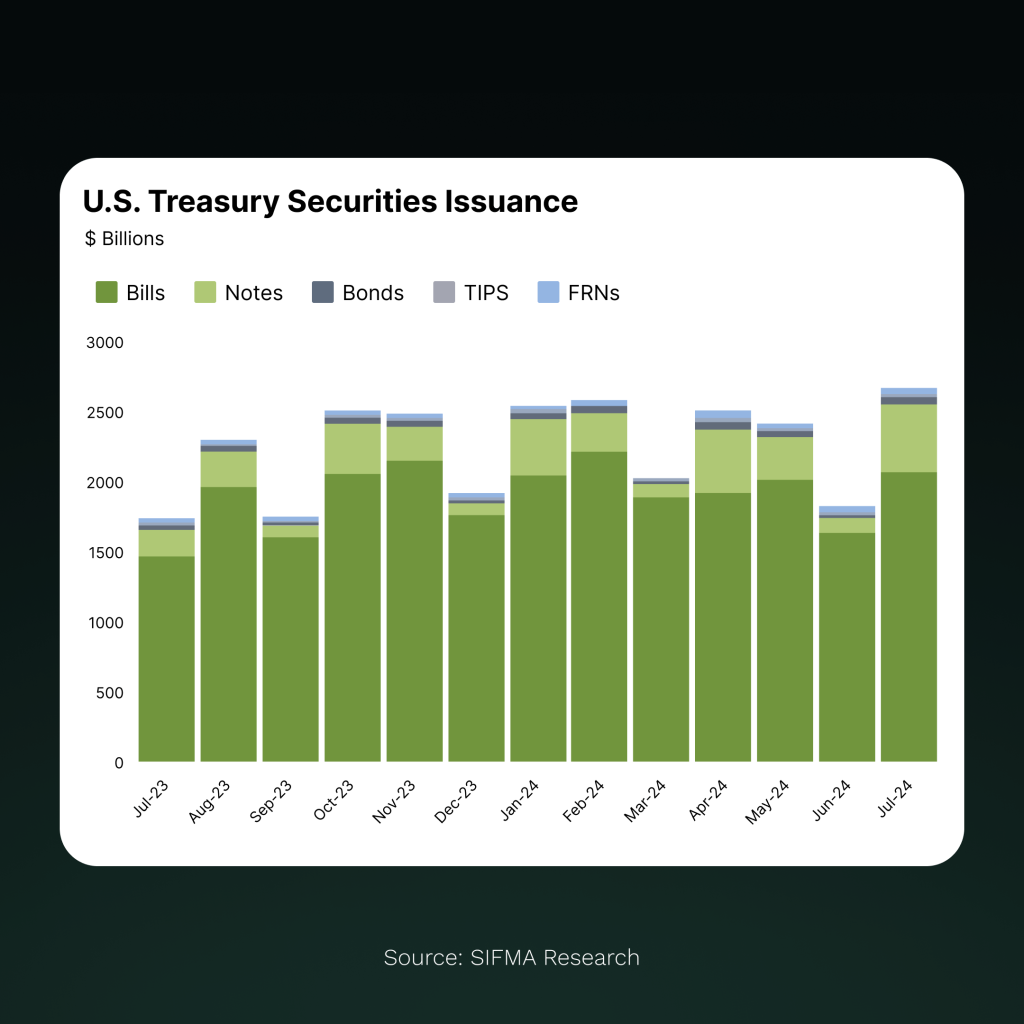
The image provides a snapshot of U.S. Treasury Securities issuance from July 2023 to July 2024, broken down by type of security: Bills, Notes, Bonds, TIPS (Treasury Inflation-Protected Securities), and FRNs (Floating Rate Notes).
Several observations can be made:
- Treasury Bills consistently make up the largest portion of issuances, indicating a significant demand for short-term government debt.
- There’s a noticeable increase in total issuance from June 2024 to July 2024, with the total rising from about $1.8 trillion to over $2.6 trillion.
- Treasury Notes (medium-term securities) show the most significant growth in this period, nearly doubling in volume.
- Bonds, TIPS, and FRNs make up a smaller but stable portion of the issuances throughout the year.
- The overall trend shows fluctuations in monthly issuance, but with a general upward trajectory, suggesting an increasing government borrowing need.
This data underscores the massive scale of the traditional government securities market, with monthly issuances in the trillions of dollars.
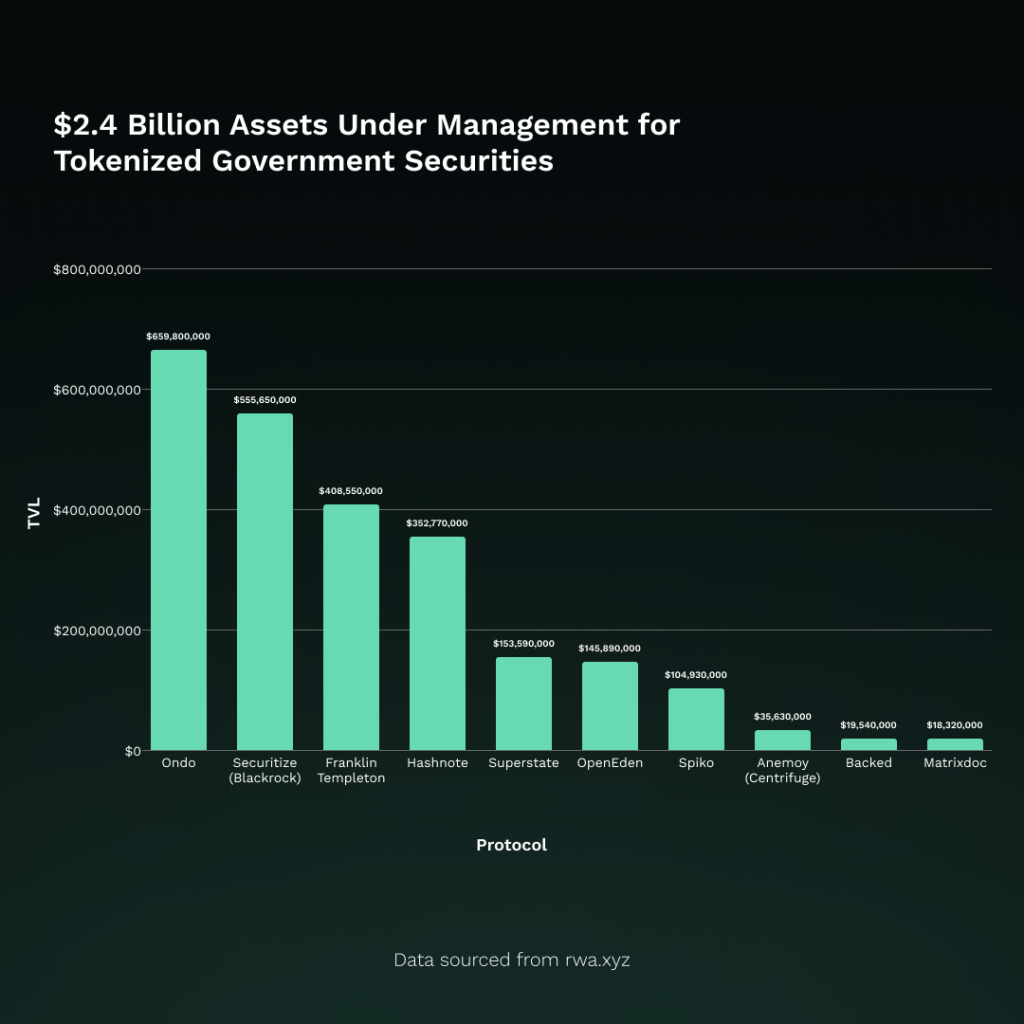
In contrast, as of October 2024, the total Assets Under Management (AUM) in tokenized government securities has reached $2.4 billion, according to data from rwa.xyz. This figure, while significant in the context of the nascent tokenized securities market, represents just a fraction of a percentage of the traditional market’s monthly issuance.
However, the $2.4 billion AUM in tokenized government securities underscores the growing acceptance and adoption of these innovative financial products. The landscape is diverse, with various tokenized government securities products currently available, spanning different blockchain networks and issuers.
This comparison highlights the enormous growth potential for tokenized government securities. As the technology matures and gains wider acceptance, there’s an opportunity to capture even a small portion of the traditional market, which could lead to exponential growth in the tokenized sector.
Protocol Overview
The tokenization of government securities is gaining traction across various blockchain platforms. Notably, Ethereum emerges as the dominant blockchain for these initiatives, hosting the majority of the listed protocols. This preference for Ethereum likely stems from its well-established smart contract capabilities and extensive developer ecosystem. However, we also see protocols leveraging other networks, such as Mantle, Polygon, Stellar, and Arbitrum, indicating a trend towards multi-chain strategies to enhance accessibility and potentially reduce transaction costs.
Among the protocols, Blackrock stands out as the leader in Assets Under Management with over $519 million, closely followed by Ondo Finance and Franklin Templeton. This significant participation from traditional financial giants like Blackrock and Franklin Templeton signals growing institutional confidence in blockchain-based financial products.
Among the protocols, Ondo Finance stands out as the leader in Assets Under Management with over $659 million, closely followed by Blackrock and Franklin Templeton. This significant participation from traditional financial giants like Blackrock and Franklin Templeton signals growing institutional confidence in blockchain-based financial products.
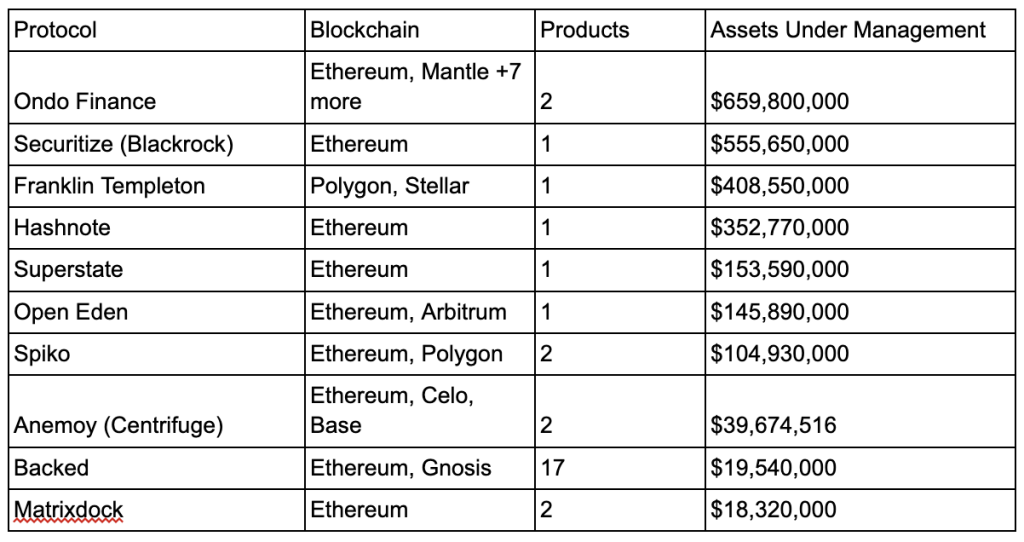
Opportunities & Challenges
The tokenization of government securities, spanning T-Bills, Notes, Bonds, TIPS, and FRNs, offers several potential benefits. It could significantly increase market accessibility, allowing for fractional ownership and potentially lowering barriers to entry for smaller investors who have traditionally been excluded from this market. The diverse range of protocols and blockchains involved, as seen in our overview, suggests a competitive landscape that could drive innovation and efficiency.
Additionally, the use of blockchain technology may enhance transparency and reduce settlement times, although these benefits are still being evaluated in real-world applications. The substantial AUM already achieved by leading protocols like Blackrock, Ondo Finance, and Franklin Templeton indicates growing confidence in these tokenized instruments.
However, challenges remain. Regulatory frameworks are still evolving to accommodate these new financial instruments, and questions about interoperability between different blockchain networks persist. The dominance of Ethereum in the current protocol landscape highlights the need for cross-chain solutions to ensure broader accessibility and resilience. Moreover, the technology’s ability to handle high-volume trading environments, typical in government securities markets which issue trillions in debt annually, is yet to be fully tested at scale.
As the market for tokenized government securities continues to grow, it will be crucial to monitor how these products perform in various market conditions and their impact on broader financial market dynamics. The involvement of major financial institutions, alongside crypto-native entities, suggests that tokenization is moving from the fringes of finance into the mainstream. This convergence of traditional finance and blockchain technology is potentially reshaping how we interact with government debt markets, promising a future where these foundational financial instruments are more accessible, efficient, and integrated with the digital economy.
Tokenized Government Securities Examples
Let’s look at some of the government securities projects making waves.
Blackrock BUIDL Fund
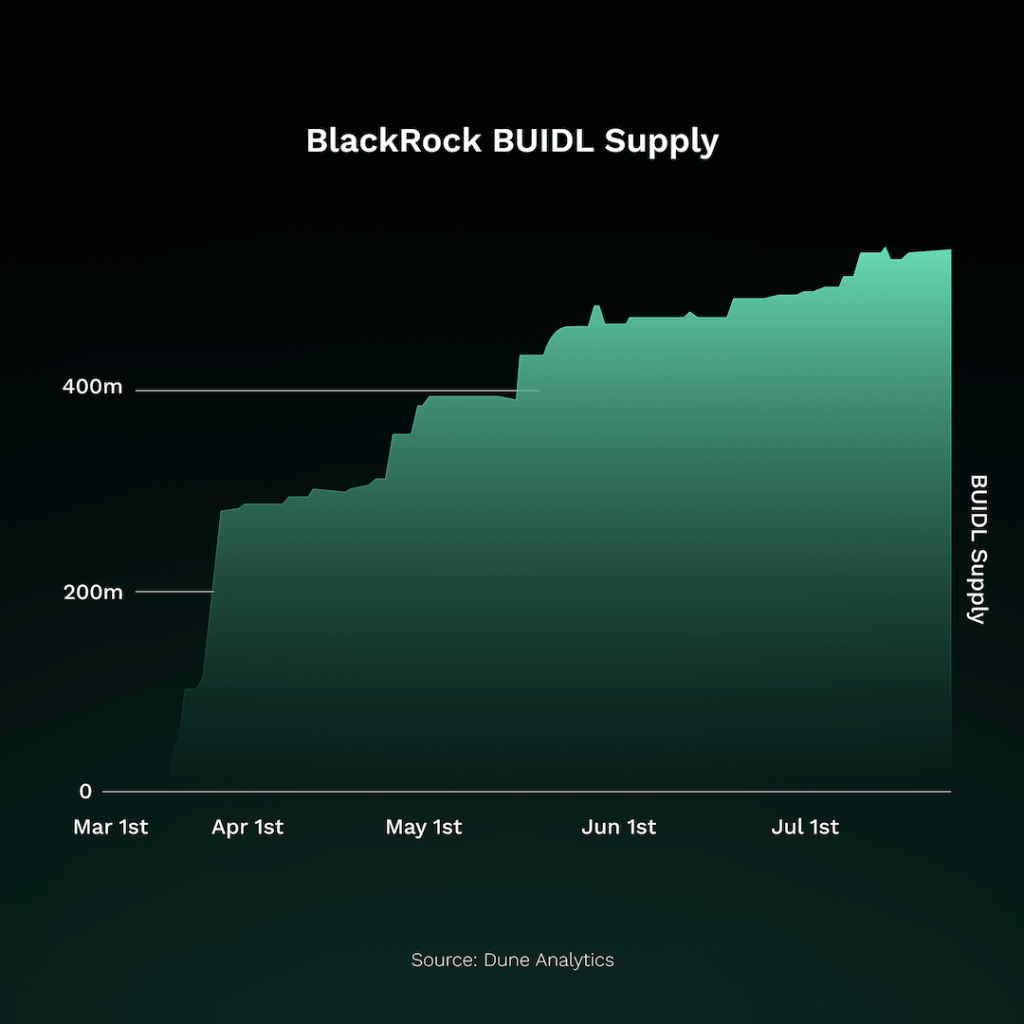
BlackRock, the world’s largest asset manager, made a significant leap into the tokenization space with the launch of its BlackRock USD Institutional Digital Liquidity Fund (BUIDL) on the Ethereum network in March 2024. This fund, developed in partnership with Securitize, allows qualified investors to earn US Treasury yields through tokenized assets, combining traditional finance with blockchain technology.
Securitize’s role in this venture is crucial. As the transfer agent and issuance platform for BUIDL, Securitize provides the necessary infrastructure for the fund’s operation. This collaboration marks a significant milestone in the regulated, compliant tokenization market in the United States, potentially attracting institutional capital and serious money managers to the Securitize ecosystem.
BUIDL’s impact has been substantial and rapid. Within four months of its launch, the fund reached a market cap of $500 million, making it the first tokenized treasury fund to achieve this milestone. As of September 2024, BUIDL’s assets under management had grown to $514 million, capturing around 23% of the $2.2 billion tokenized US Treasury market. The fund’s success demonstrates the scalability and demand for tokenized financial products in institutional markets.
The fund’s approach includes daily accrued dividends deposited directly into investors’ wallets as new tokens each month, maintaining a stable $1 per token value. This model has attracted significant players in the crypto space, with Ondo Finance becoming the largest holder of BUIDL at $173.7 million. Notably, on March 27, 2024, Ondo Finance reallocated $95 million of its own tokenized short-term bond fund to BUIDL, further validating the fund’s appeal.
BlackRock’s entry into tokenization, facilitated by Securitize, not only validates the technology but also paves the way for broader adoption of blockchain in traditional finance. As fiduciaries onboard with Securitize for access to BUIDL, they are likely to move significant capital into the fund and the broader Securitize ecosystem. This could lead to an increase in capital flows and activity for alternative investment products and listings on Securitize Markets’ primary and secondary trading venues, setting a precedent for other regulated venues in their issuer structuring and strategies.

“BUIDL became the largest tokenized treasury fund ever in just forty days, and currently makes up over 25% of the entire tokenized treasury market, but it’s important to note that we’re just scratching the surface on the fund’s potential. In traditional finance, nobody posts dollars as collateral. For every dollar in traditional finance there are two dollars in treasuries. In crypto the ratio is completely reversed. That will change as larger crypto institutions tap into tokenized funds like BUIDL to overhaul their treasury management systems. If you’re a DAO, you finally have a way to buy a treasury management product from a trusted asset manager like BlackRock that earns yield at very low risk. That will expedite the growth as more asset managers join the market. If stablecoins sit at $150B, the tokenized treasury market will naturally grow into the tens of billions range, soon.”
Carlos Domingo,
CEO & Co-Founder of Securitize
Franklin Templeton’s OnChain U.S. Government Money Fund
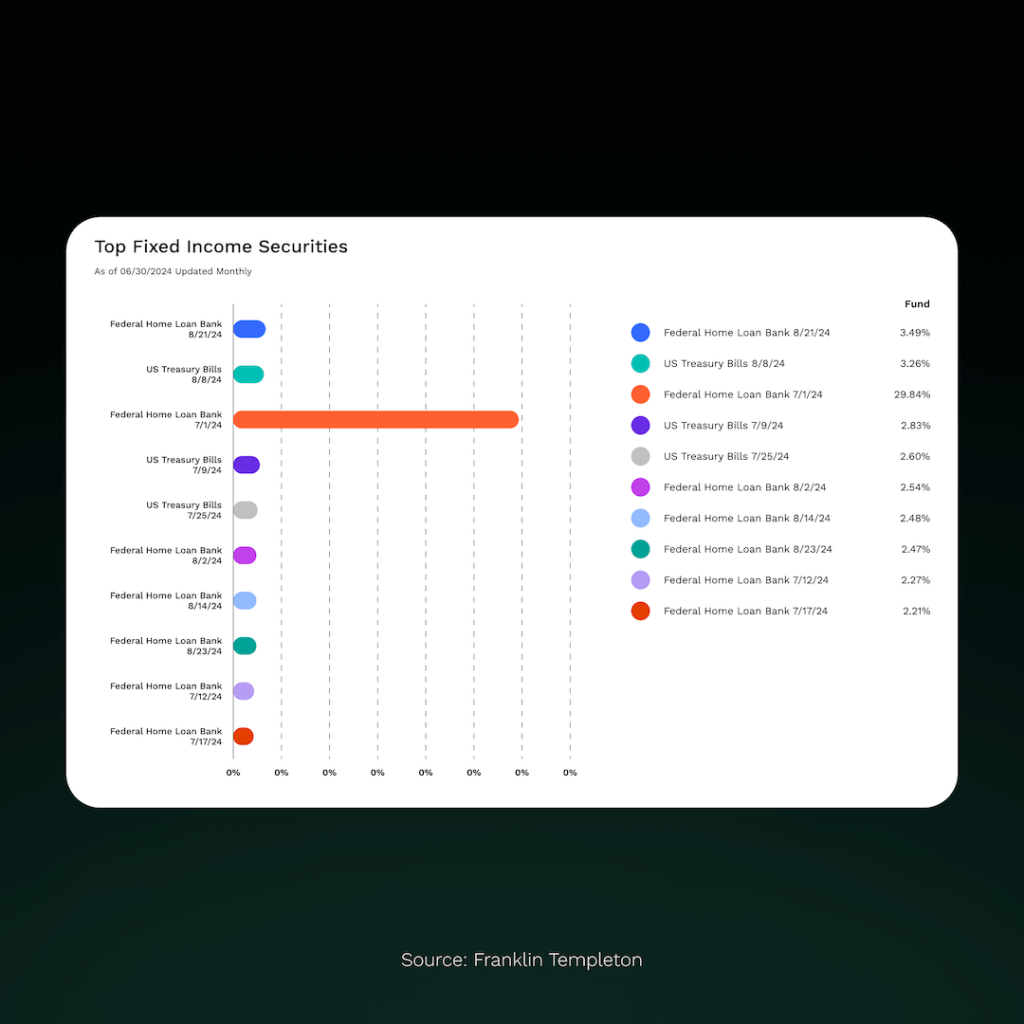
Franklin Templeton, one of the world’s largest asset managers, has pioneered the integration of blockchain technology into traditional financial products with its Franklin OnChain U.S. Government Money Fund (FOBXX). Launched in April 2021, FOBXX represents a significant step in the tokenization of regulated investment vehicles, offering investors the stability of a government money market fund combined with the transparency and efficiency of blockchain technology.
The fund’s impact on the financial services sector has been substantial. As of June 30, 2024, FOBXX had grown to over $360 million in assets under management, with a weighted average maturity of 25 days and a weighted average life of 39 days. This growth demonstrates the increasing acceptance of blockchain-based financial products among both retail and institutional investors. The fund invests at least 99.5% of its total assets in U.S. government securities, cash, and repurchase agreements collateralized by government securities or cash, maintaining a stable $1.00 share price while providing daily liquidity to investors.
What sets FOBXX apart is its use of a proprietary blockchain-integrated system for recordkeeping. The fund’s transfer agent maintains the official record of share ownership using features of traditional book-entry form combined with one or more public blockchain networks. This allows for real-time recording of fund ownership and has the potential to provide significant operational efficiencies. Investors can access their ownership information and initiate transactions through a mobile application, offering unprecedented convenience and transparency in the mutual fund space. Despite using blockchain technology, the fund does not invest in cryptocurrencies, maintaining its focus on traditional government securities.
ONDO Finance
Ondo Finance, established in 2021, focuses on tokenizing real-world assets, particularly U.S. Treasuries and money market funds. The company’s main products are USDY (US Dollar Yield) and OUSG (Ondo Short-Term US Government Bond Fund). USDY is a tokenized note backed by short-term U.S. Treasuries and bank deposits, while OUSG is a tokenized version of a BlackRock short-term U.S. Treasuries ETF. These products aim to provide blockchain-based access to traditional financial instruments.
As of August 2024, Ondo Finance’s Total Value Locked across its two main products has reached $577 million+, making it the largest issuer of tokenized treasuries. USDY accounts for $371 million+ of this total, with OUSG representing the remaining $206 million. This growth in TVL indicates increasing adoption of Ondo’s tokenized products since their launch.
Ondo’s approach includes implementing regulatory compliance measures, regular reporting, and third-party audits. The company has also established partnerships with firms in both traditional finance and the cryptocurrency sector, including BlackRock and Coinbase. These collaborations facilitate the creation and custody of Ondo’s tokenized products.
A key feature of Ondo’s USDY is its composability with DeFi and permissionless nature. Recently, USDY has gained significant momentum in DeFi protocols, being used for lending, borrowing, margins/perpetual trading, and more, all while earning yield. USDY uniquely combines investor protections typically found in traditional finance with yield generation, composability, and permissionless characteristics – advantages not offered by either stablecoins or other yieldcoins.
As of its one-year anniversary on the 26th of August 2024, USDY has expanded its presence to eight blockchains (Ethereum, Solana, Sui, Aptos, Arbitrum, Mantle, Mantra, and Cosmos). With integration across 70+ projects, USDY’s growing ecosystem reflects the increasing interest in bridging traditional finance with blockchain technology. As the market for tokenized RWAs continues to develop, Ondo’s progress offers valuable insights into the potential integration of traditional financial assets with blockchain technology.

“One novel distinction of Ondo’s USDY is that it is both composable with DeFi and permissionless. We have a lot of recent momentum in DeFi protocols, such as using yield-bearing assets for lending, borrowing, margins/perpetual trading and more all while earning yield. Other tokenized RWAs such as BlackRock’s BUIDL and Franklin Templeton’s Benji, while novel products, were not composable with DeFi or permissionless. USDY offers robust investor protections typically found in traditional finance and yield while also being composable and permissionless. Neither stablecoins nor other yieldcoins offered all of these advantages.”
Ben Grossman,
Sr. Director of Marketing at Ondo Finance
Backed
Backed has emerged as a significant player in the tokenization of government securities, demonstrating the growing appetite for blockchain-based representations of traditional financial instruments. The company has achieved a total issuance volume of $52,043,275, a figure that underscores the substantial market interest in tokenized government securities. This volume suggests that investors are increasingly comfortable with the concept of holding government debt instruments in tokenized form, potentially benefiting from the increased liquidity and accessibility that blockchain technology offers.
The company’s reach extends beyond mere issuance, as evidenced by its network of 40 ecosystem partners and 10 protocol integrations. These partnerships and integrations are crucial for creating infrastructure around tokenized securities, enabling seamless trading, custody, and settlement processes.
Products
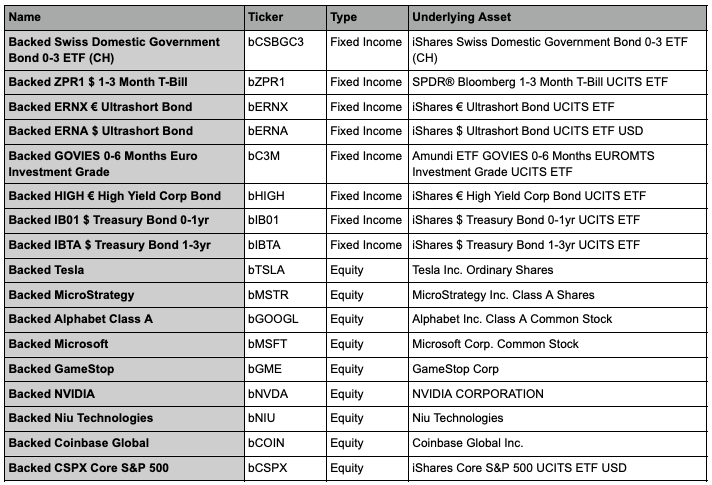
Backed’s product lineup, as illustrated in the above table, showcases a diverse range of tokenized assets, including both fixed income and equity products. Notably, the company offers tokenized versions of various government securities and ETFs, such as the Backed Swiss Domestic Government Bond 0-3 ETF (bCSBGC3) and the Backed ZPR1 $ 1-3 Month T-Bill (bZPR1). This comprehensive offering extends to equity products as well, including tokens representing shares in major tech companies like Microsoft (bMSFT) and NVIDIA (bNVDA). All products are launched with a total issuance volume of 100,000,000 CHF, indicating Backed’s commitment to providing ample liquidity. Furthermore, the company’s support for EVM-compatible chains across various networks enhances interoperability, allowing these tokenized assets to integrate seamlessly with DeFi protocols.
The case of Backed provides valuable insights into the evolving landscape of tokenized securities. While the current issuance volume represents a small fraction of the traditional securities market, it signifies a noteworthy start in bridging the gap between traditional finance and blockchain technology. As regulatory frameworks continue to develop and institutional adoption increases, companies like Backed are likely to play a pivotal role in shaping the future of securities trading and ownership. The company’s progress thus far, coupled with its diverse product offering and focus on interoperability, suggests that tokenized securities could become an increasingly important component of both the digital asset ecosystem and the broader financial markets.

“The tokenization revolution is in full swing. Financial institutions are embracing this technology, recognizing its potential to reshape the global financial landscape. The distinction between ‘real-world’ and digital assets will blur as blockchains become the settlement layer for all financial transactions, democratizing access to markets worldwide. The future of finance is borderless and inclusive.”
David Henderson,
Head of Marketing at Backed
Anemoy
Anemoy, launched in 2023, operates as a web3-native asset manager providing regulated, fully on-chain investment products. Their flagship offering, the Anemoy Liquid Treasury Fund, represents a novel approach to tokenizing U.S. Treasury bills through a regulated British Virgin Islands fund structure. The fund holds U.S. Treasury Bills with a maximum maturity of six months and processes investments and redemptions in USDC, offering daily liquidity to qualified non-U.S. professional investors with a minimum investment threshold of $500,000.
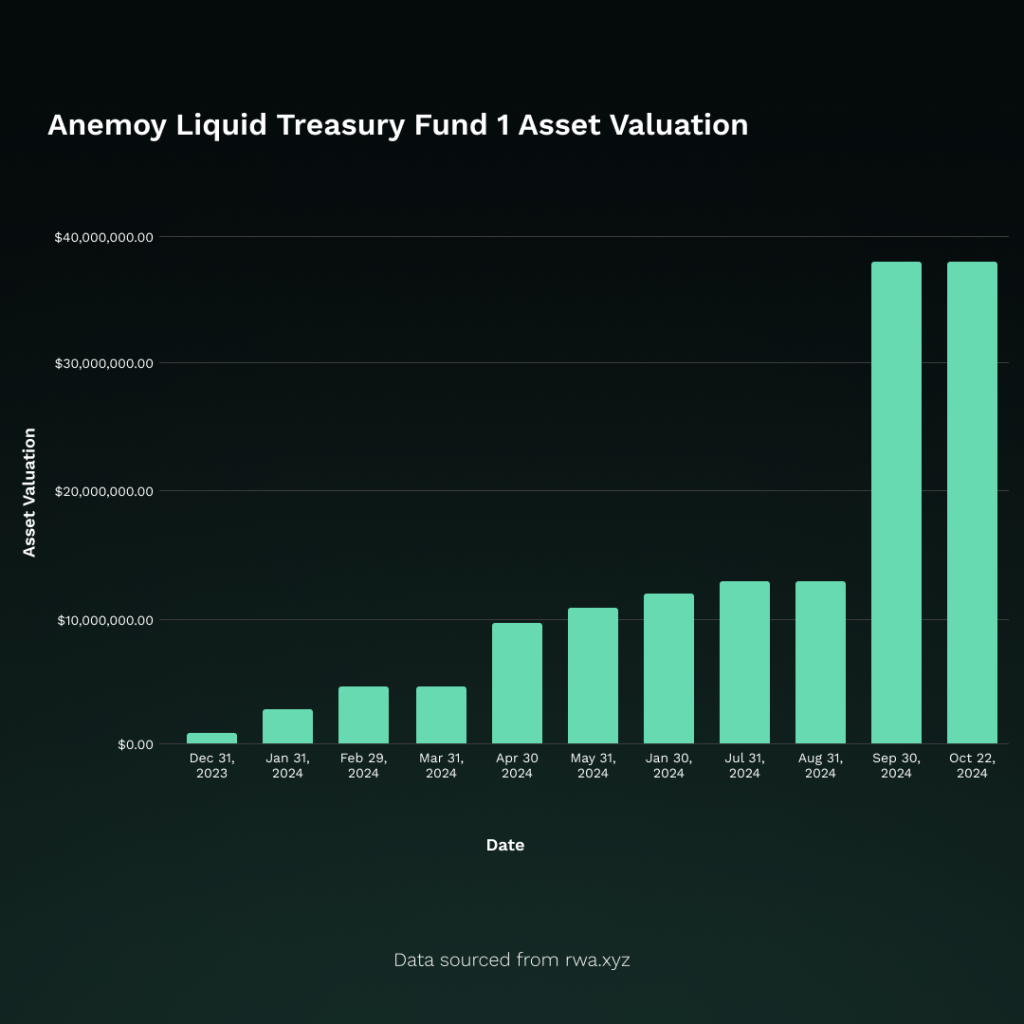
The fund’s architecture combines traditional financial infrastructure with blockchain technology. The physical Treasury bills are held by established Wall Street custodians, while the fund shares are issued as tokens through the Centrifuge protocol. This structure provides investors with direct legal ownership of fund shares, effectively reducing counterparty risk compared to traditional tokenized treasury products. Since its launch in December 2023, the fund has demonstrated significant growth, with assets under management increasing from approximately $1 million to over $38 million by October 2024, marking particularly strong expansion in September 2024.
A key distinguishing feature of Anemoy’s approach is its regulatory compliance and institutional-grade infrastructure. The fund operates under BVI Financial Services Commission oversight, requiring strict adherence to KYC and AML requirements. The tokens representing fund shares provide investors with legal claims on the underlying assets and include redemption-in-kind rights, allowing token holders to claim the physical Treasury bills directly from the custodian if needed. This regulatory framework, combined with the fund’s transparent structure, has attracted institutional investors, particularly DAO treasuries seeking regulated exposure to U.S. Treasury yields.
In 2024, Anemoy expanded its offerings by launching the DeFi Yield Fund, a market-neutral fund investing in DeFi strategies, demonstrating the platform’s capability to bridge traditional finance with decentralized systems. The fund uses Centrifuge’s infrastructure for tokenization and distribution, enabling investors to track assets and performance through public blockchain networks including Ethereum and Polkadot, with planned expansion to additional networks such as Arbitrum and Base. This infrastructure allows for cross-chain accessibility while maintaining the regulatory compliance and transparency standards established with their Treasury fund.
Private Credit
Private credit refers to loans provided by non-bank lenders, typically to mid-sized companies that are too large for traditional bank loans but too small to access public debt markets. These borrowers often include private equity-backed companies, growing businesses in need of flexible financing, and firms in specialized sectors.
Tokenized private credit takes this concept further by converting these loans into digital tokens on a blockchain. This process allows the loans to be divided into smaller, more tradable units, making them accessible to a broader range of investors, including retail participants who were previously excluded from this market.
According to the International Monetary Fund (IMF), the private credit market has experienced significant growth, reaching $2.1 trillion globally in 2022. This represents a substantial increase from just $0.2 trillion in 2000, demonstrating the rapid expansion of this asset class over the past two decades. As tokenization technology advances, it has the potential to further accelerate this growth by increasing liquidity and accessibility in the private credit market.
Market Growth
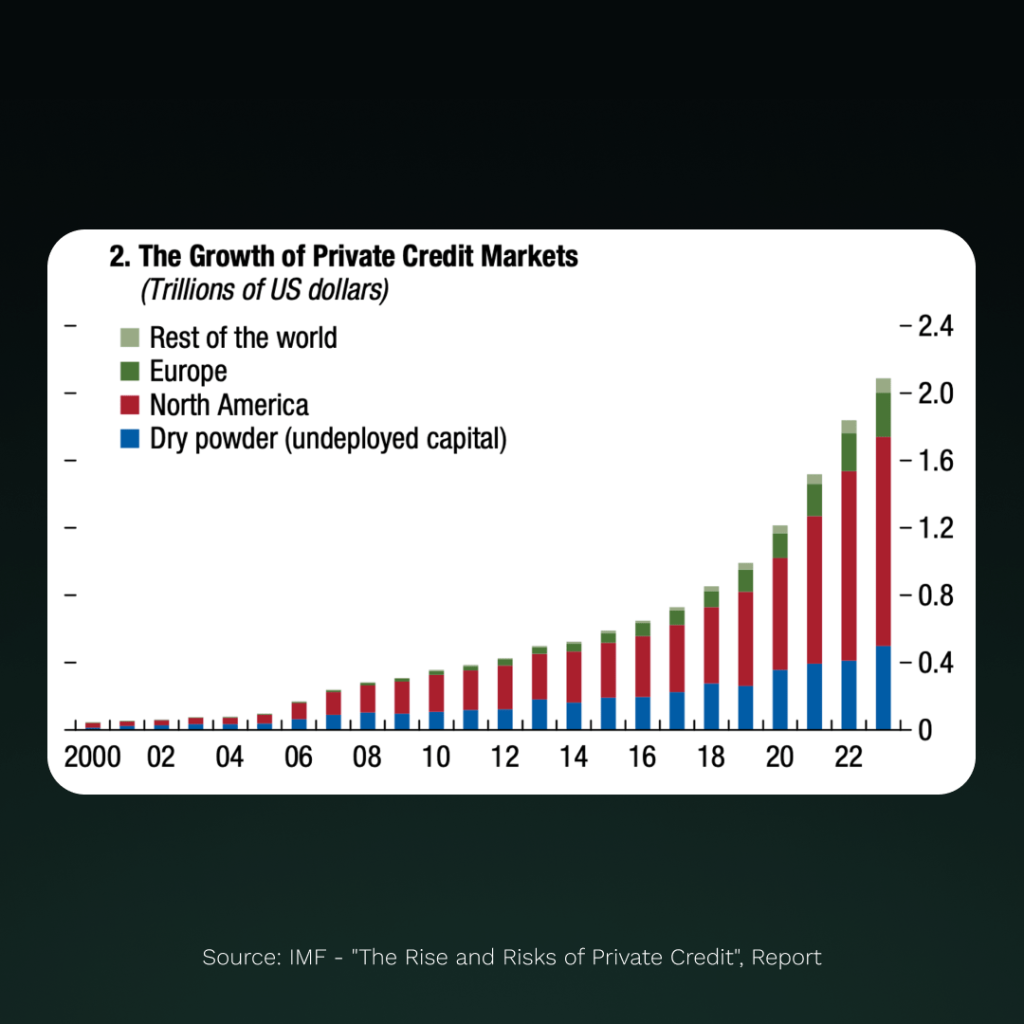
The chart above illustrates the growth of private credit markets from 2000 to 2022. The total market size has expanded from less than $0.2 trillion in 2000 to over $2.0 trillion by 2022, representing a tenfold increase in just two decades. This growth has been predominantly driven by North America, which accounts for the largest share of the market, followed by Europe, while the rest of the world shows a smaller but growing presence.
A notable feature of this growth is the increasing presence of “dry powder” or undeployed capital, particularly since 2014. This suggests a growing pool of available funds ready for investment in private credit opportunities. The steepening of the growth curve from 2014 onwards indicates an acceleration in market expansion, likely due to increased investor interest and favorable market conditions.
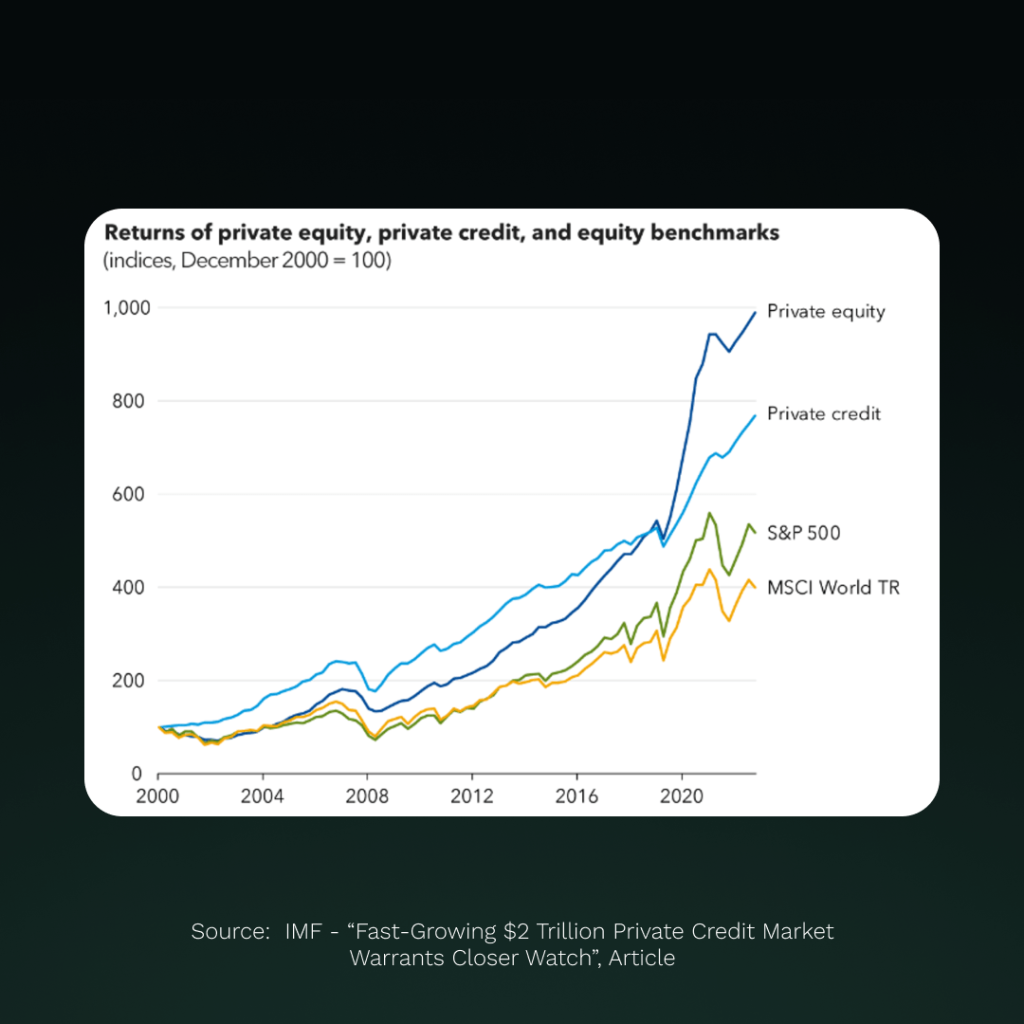
When comparing the returns of private equity, private credit, and equity benchmarks from 2000 to 2020, some important insights can be found. Both private equity and private credit have significantly outperformed traditional equity benchmarks (S&P 500 and MSCI World TR) over the 20-year period. Private credit, in particular, shows a more stable growth trajectory compared to private equity and public markets, with fewer sharp declines during market downturns.
Since 2016, private equity and private credit have shown accelerated growth, widening the performance gap with public market indices. Notably, during the 2008 financial crisis, private credit demonstrated better resilience compared to other asset classes, experiencing a smaller decline and quicker recovery. This performance history highlights the potential benefits of including private credit in a diversified investment portfolio.
These charts highlight the growth potential and attractive risk-adjusted returns offered by the private credit market. As tokenization makes this asset class more accessible, it could potentially unlock substantial value and democratize access to these high-performing investments, bringing the benefits of private credit to a broader range of investors.
Current Problems
The traditional private credit market, despite its growth, faces several significant challenges:
- Limited Liquidity: Private credit investments are typically illiquid, with long lock-up periods often lasting several years. This lack of liquidity makes it difficult for investors to exit their positions quickly if needed, potentially tying up capital for extended periods. For borrowers, this can mean less flexibility in refinancing or restructuring their debt.
- High Barriers to Entry: The private credit market has traditionally been accessible only to institutional investors and high-net-worth individuals. Minimum investment requirements often run into millions of dollars, effectively excluding retail investors and smaller institutions from participating. This limitation restricts the potential investor base and capital flow into the market.
- Lack of Transparency: Private credit transactions often lack the transparency found in public markets. Information about loan terms, borrower performance, and overall market trends can be difficult to obtain. This opacity can make it challenging for investors to accurately assess risks and make informed decisions.
- Inefficient Processes: Many aspects of private credit transactions, from origination to servicing, still rely on manual, paper-based processes. This inefficiency can lead to slower deal execution, higher operational costs, and increased potential for errors. It also limits the scalability of private credit operations, potentially constraining market growth.
Process
The process of tokenizing private credit typically involves the following steps:
- Asset Selection: Identify suitable private credit assets for tokenization.
- Legal Structure: Establish the legal framework for tokenizing the assets, ensuring compliance with relevant regulations.
- Smart Contract Creation: Develop smart contracts that encode the terms and conditions of the private credit assets.
- Token Issuance: Create digital tokens representing ownership or fractional ownership of the private credit assets.
- Distribution: List the tokens on appropriate platforms for trading or investment.
- Ongoing Management: Implement systems for managing loan servicing, interest payments, and compliance.
Overview
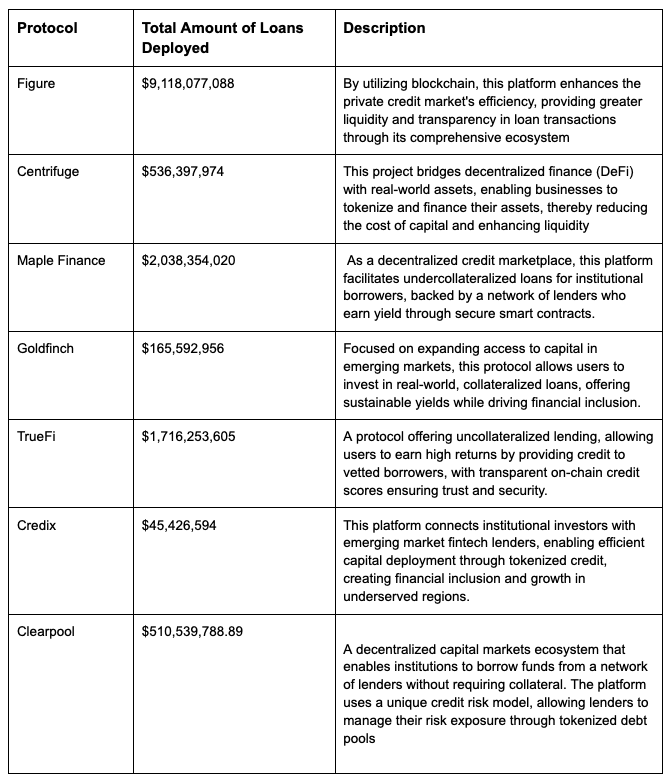
A Promising Future
The integration of blockchain technology into private credit markets presents a transformative opportunity to address longstanding challenges while unlocking new potential. Tokenization can significantly enhance liquidity by creating a more accessible secondary market for private credit assets. This increased liquidity could lead to more efficient price discovery and potentially lower borrowing costs for companies. Moreover, the fractional ownership enabled by tokenization can dramatically lower barriers to entry, allowing a broader range of investors to participate in this historically exclusive market.
Blockchain’s inherent transparency and immutability offer solutions to the opacity that has long characterized private credit markets. Smart contracts can automate many aspects of loan servicing, including interest payments and covenant monitoring, reducing operational costs and minimizing human error. This automation, combined with the real-time visibility of blockchain networks, can provide investors with unprecedented insight into the performance of their investments and the overall health of the market.
Perhaps most excitingly, tokenized private credit has the potential to unlock global liquidity pools, connecting borrowers and lenders across jurisdictions more efficiently than ever before. This global accessibility could lead to more diverse investment opportunities and potentially higher yields for investors, while providing businesses with access to a broader range of funding sources. As regulatory frameworks evolve to accommodate these innovations, we anticipate seeing accelerated growth in tokenized private credit, potentially reshaping the broader financial landscape. The convergence of traditional finance expertise with blockchain technology promises to create a more efficient, and dynamic private credit market, benefiting both investors and borrowers alike.
Tokenized Private Credit Examples
Let’s look at some of the private credits projects tokenizing assets.
Centrifuge
Founded in 2017, Centrifuge, focuses on integrating RWAs into the blockchain ecosystem. The platform aims to create a more efficient, transparent, and accessible financial system by tokenizing real-world assets and enabling their use in DeFi protocols. Centrifuge has achieved a cumulative loan amount of $636,033,954 and has tokenized 1,536 assets.
Centrifuge’s process for bringing off-chain assets on-chain involves several steps. Initially, real-world assets are represented as Non-Fungible Tokens (NFTs) on the Centrifuge Chain. These NFTs contain asset information used for pricing, financing, and valuation. To address confidentiality needs in financial transactions, Centrifuge developed a Private Data Layer, allowing secure access to additional asset data. The platform’s on-chain securitization process pools assets together, facilitating management of asset-backed securities. Centrifuge’s Liquidity Pools integrate with various DeFi protocols and chains, connecting traditional finance with DeFi. This approach has led to partnerships with entities such as MakerDAO, Aave, and BlockTower Credit.
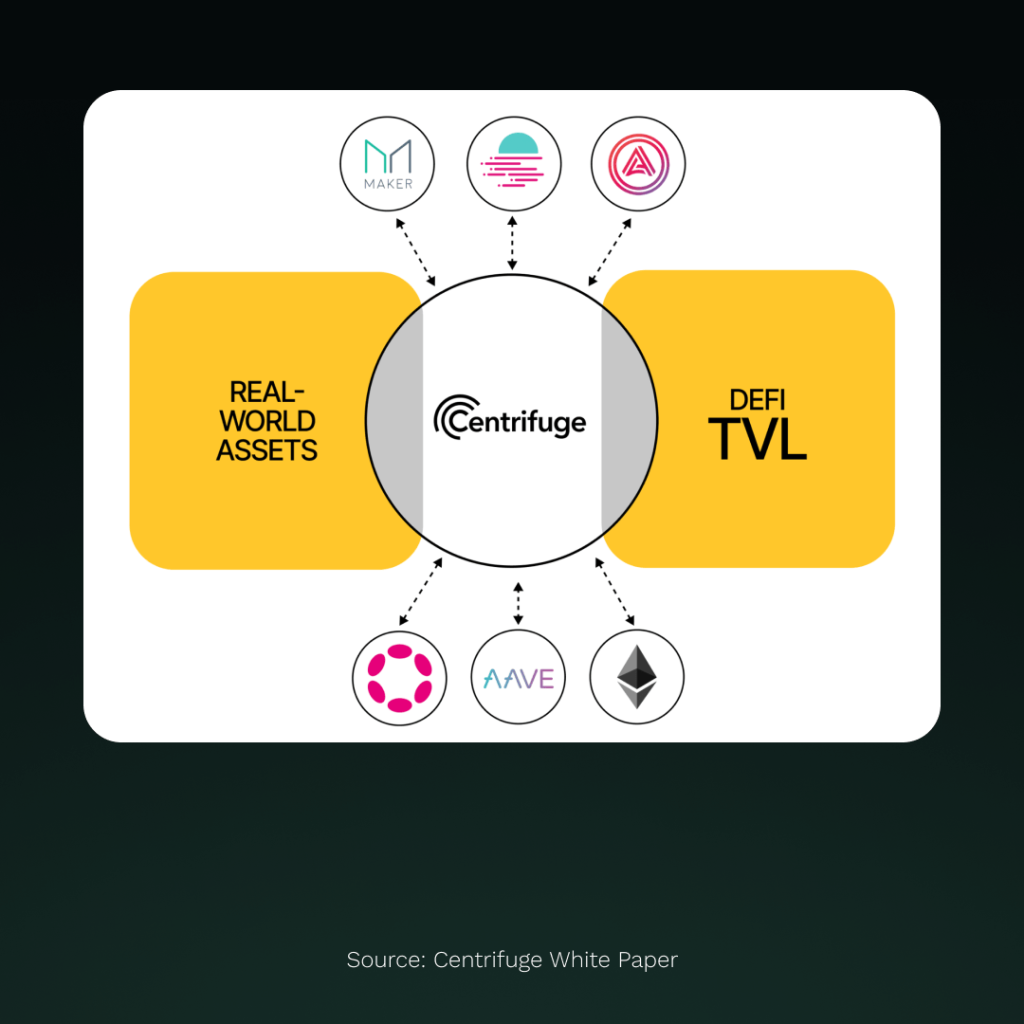
What makes Centrifuge particularly interesting is its role as a bridge between real-world assets and the DeFi ecosystem. As illustrated in the image above, Centrifuge acts as a central hub, connecting traditional real-world assets on one side with various DeFi protocols and platforms on the other. This unique position allows Centrifuge to tokenize and integrate real-world assets into the DeFi space, making them accessible to protocols like MakerDAO, Aave, and other Ethereum-based DeFi applications. The platform’s ability to interact with multiple chains and DeFi protocols significantly enhances its adoption potential and liquidity options. By facilitating this connection, Centrifuge opens up new possibilities for asset financing and trading, potentially increasing the accessibility of real-world assets to a wider range of DeFi investors and protocols
Centrifuge’s progress showcases the practical application of blockchain technology in traditional financial systems. The platform’s combination of asset tokenization, privacy-preserving technology, and cross-chain compatibility positions it uniquely at the intersection of traditional finance and DeFi. This convergence of traditional and decentralized finance opens up new possibilities for asset liquidity, global accessibility, and financial inclusion. As Centrifuge continues to develop and refine its offerings, it has the potential to play a significant role in shaping the future landscape of digital asset integration in finance, potentially unlocking new value in previously illiquid assets and creating more efficient capital markets..

“At Centrifuge, we’re focused on bringing real-world assets onchain to connect traditional finance with DeFi. Our goal is straightforward: to create a compliant and convenient way for investors to access a range of credit opportunities in one place. By curating quality assets and providing a secure platform, we’re making it easier for investors to engage with the future of finance.”
Bhaji Illuminati
CMO of Centrifuge
Maple Finance
By focusing on institutional-grade lending and borrowing, Maple Finance has carved out a unique niche, facilitating secured, collateralized loans to crypto-native institutions. This approach marries the efficiency of blockchain technology with traditional financial expertise, creating a lending ecosystem that’s attracting attention from both crypto enthusiasts and traditional finance professionals.
At the heart of Maple’s growth in the past twelve months has been its launch of Maple Direct to fill the void left by CeFi lenders since 2022. Maple internally hired experienced credit underwriters with Wall Street backgrounds so that it could manage lending pools itself. This involves performing due diligence, setting loan terms, and managing risk. This structure brings a level of professional financial oversight to the DeFi space that’s rarely seen, helping to build trust and credibility among institutional participants.
Maple’s expansion hasn’t been limited to a single blockchain. While primarily built on Ethereum, the protocol has extended its reach to other chains like Solana, increasing its market accessibility and offering cross-chain lending opportunities. This multi-chain approach has contributed to Maple’s growing total value locked, which currently stands at $342,231,443.
The protocol’s growth trajectory is perhaps best illustrated by its monthly revenue, as shown in the following graph:
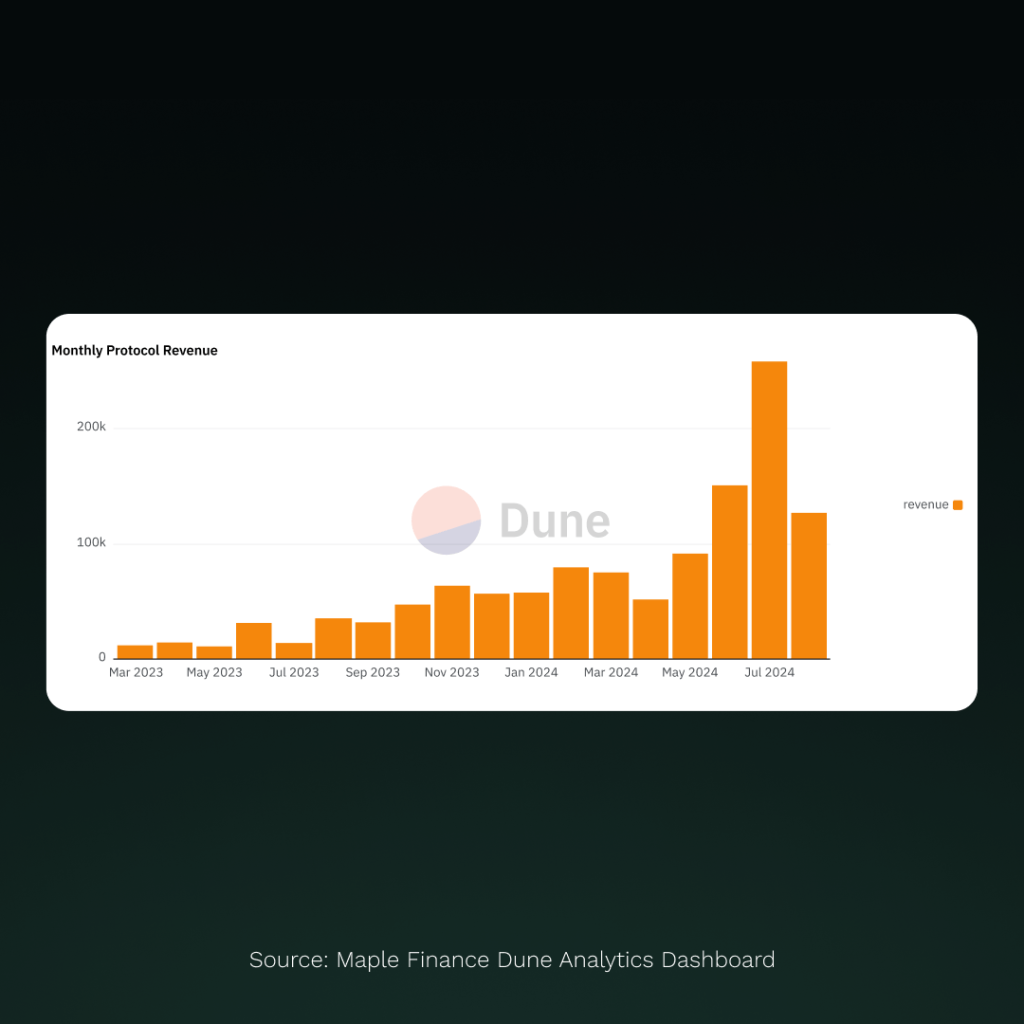
The chart reveals a clear upward trend in Maple’s monthly revenue, with a particularly sharp increase in mid-2024. The spike in July 2024 is especially noteworthy, showing revenue reaching a new high of 300k for the month. This substantial growth in fee generation is a strong indicator of increased protocol usage and adoption, reflecting Maple’s expanding role in the DeFi lending space.
Maple Finance has significantly expanded its product suite to cater to a diverse range of lender needs, marking a major step in broadening its user base. In June 2024, the protocol introduced Syrup.fi, a retail-focused arm providing permissionless access to institutional-grade yields. This move not only expands Maple’s market reach but also democratizes access to sophisticated financial products. Alongside Syrup, Maple Direct offers both High Yield and Blue Chips categories, with the latter having already issued over $160 million in loans to established, lower-risk institutions.
One of Maple’s most intriguing developments is its integration of real-world assets into its offerings. The Maple Cash pool, backed by short-dated U.S. Treasury bills, represents a significant step towards bridging traditional finance with DeFi. This product offers a lower-risk investment option while still leveraging the benefits of blockchain technology, potentially attracting more risk-averse investors. As the DeFi sector matures, Maple Finance’s institutional approach and innovative products may well serve as a model for bringing traditional finance practices into the blockchain era, potentially reshaping the future of lending itself.

“As pioneers in institutional lending, Maple Finance is bringing the trillion-dollar private credit market on-chain. Our vision is to be the gold standard for institutional lending in the digital age, which is evident in our approach to tokenizing Real World Assets and the phenomenal growth we’ve seen this year in our collateralized lending products to institutions. By bridging traditional finance with DeFi, we’re reshaping the market to create a more accessible, competitive, and forward-thinking lending ecosystem for institutional clients worldwide.”
Sidney Powell
CEO & Co-Founder of Maple Finance
GoldFinch
Goldfinch is a decentralized credit protocol that aims to bridge the gap between crypto-backed lending and real-world financing. Founded in 2020 by Mike Sall and Blake West, both former Coinbase employees, Goldfinch has quickly established itself as a significant player in the DeFi lending space. The protocol’s unique approach to undercollateralized lending has attracted substantial attention and investment, with over $37 million raised from 23 investors as of 2023.
At its core, Goldfinch operates on the principle of “trust through consensus,” a credit model that evaluates borrowers’ creditworthiness based on their past behavior and the collective assessment of other participants. This approach allows Goldfinch to offer loans without requiring crypto collateral, making it accessible to a broader range of borrowers, particularly those in developing countries who may lack access to traditional financial services. As of August 2024, Goldfinch has $72,330,392.46 in active loans, demonstrating the significant demand for its services.
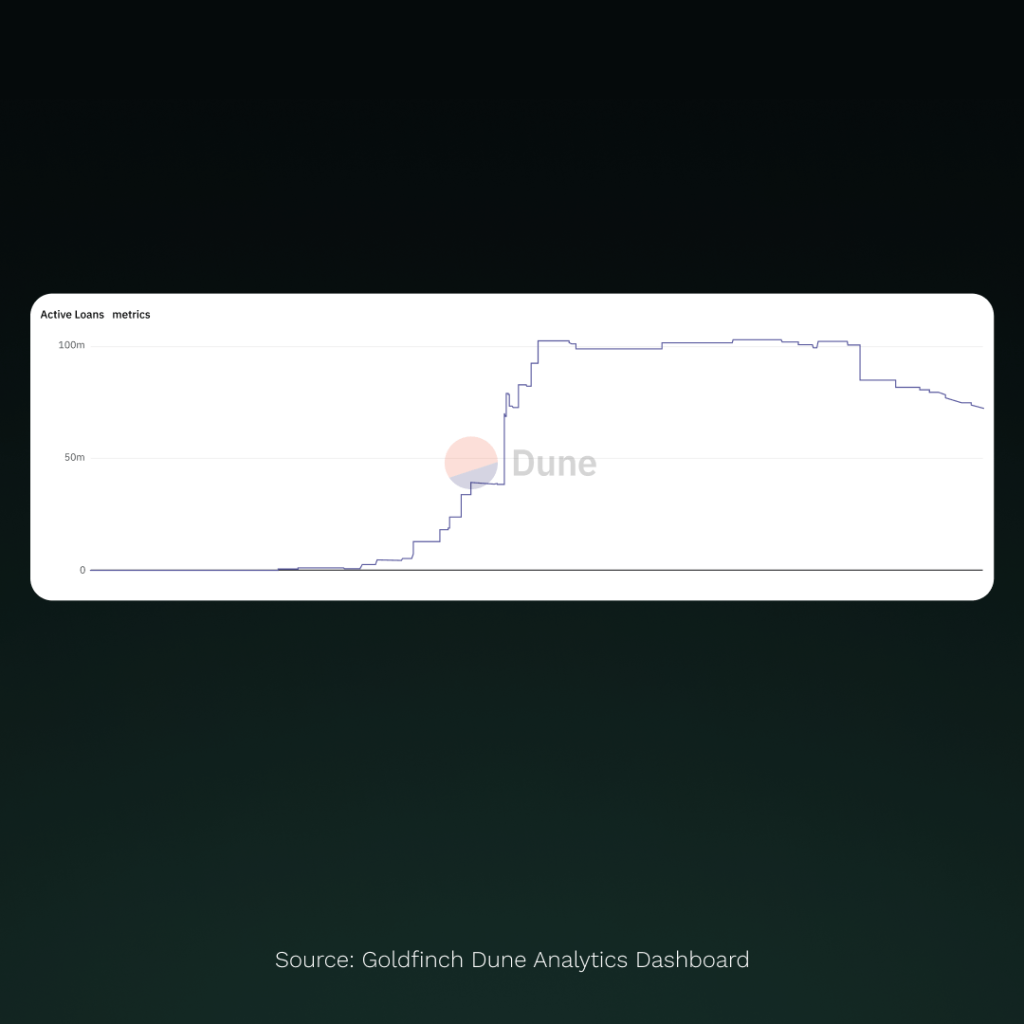
The protocol’s growth trajectory is evident in the Active Loans metrics chart, which shows a dramatic increase in loan volume from early 2021 to mid-2022, followed by a period of stability and a recent decline. This pattern reflects Goldfinch’s rapid expansion phase and subsequent maturation as it navigates market conditions and refines its lending strategies. Despite recent fluctuations, the protocol continues to generate substantial activity, with $60,523.32 in protocol fees collected over a 30-day period from July 15 to August 15, 2024.
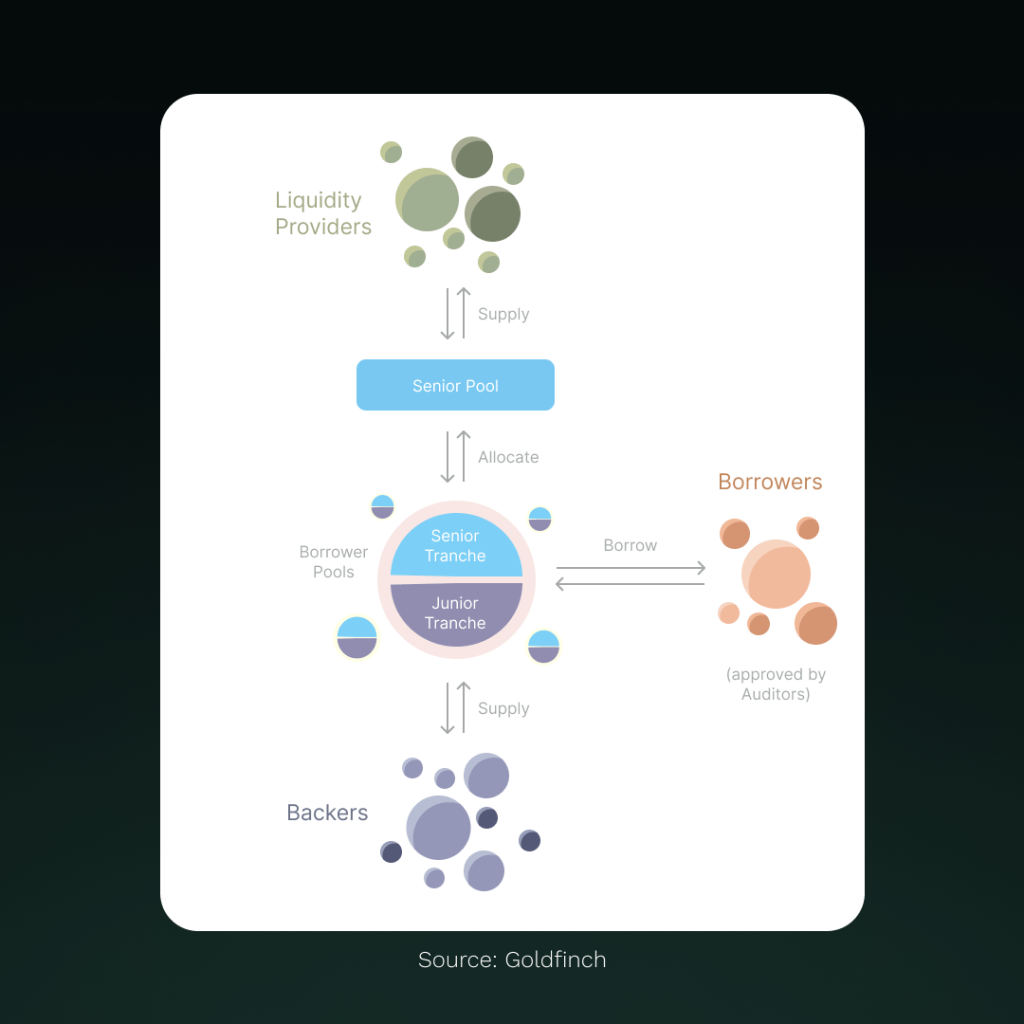
Goldfinch’s ecosystem is designed to create a symbiotic relationship between various participants. The protocol comprises Liquidity Providers, who supply capital to the Senior Pool; Backers, who provide first-loss capital to individual Borrower Pools; and Borrowers, who are approved by Auditors to access loans. This multi-layered structure allows for risk diversification and creates opportunities for different types of investors to participate based on their risk appetite and investment goals.
The Senior Pool acts as a central hub, allocating funds to various Borrower Pools. Each Borrower Pool is divided into a Senior Tranche and a Junior Tranche, with the latter absorbing potential losses first, providing an additional layer of security for Senior Tranche investors. This structure enables Goldfinch to offer more competitive rates to borrowers while still providing attractive yields to investors, particularly in the current low-yield environment of traditional finance.
By enabling the financing of off-chain economic activity through on-chain mechanisms, Goldfinch is creating a bridge between traditional finance and the crypto world, opening up new investment opportunities and potentially driving financial inclusion on a global scale. As the protocol continues to evolve, it faces both opportunities and challenges, with its ability to maintain growth while managing risk being crucial, especially as it expands into new markets and asset classes. The recent decline in active loans suggests that Goldfinch may be entering a phase of consolidation and refinement, potentially focusing on improving its risk assessment models and expanding its borrower base.
Stablecoins
Originally developed to address the high volatility of cryptocurrencies like Bitcoin and Ethereum, stablecoins have evolved to serve multiple functions within and beyond the cryptocurrency markets. Their primary purpose remains mitigating the price fluctuations that have historically hindered the widespread adoption of cryptocurrencies for everyday financial activities.
As the cryptocurrency and blockchain sectors have matured, stablecoins have gained increased attention from both the digital asset community and traditional financial institutions. Their potential to impact global finance extends beyond their original scope, with implications for payment systems, cross-border transactions, and financial inclusion.
The sustained interest in stablecoins reflects ongoing challenges in the broader cryptocurrency ecosystem. While decentralized currencies offer benefits such as trustless and borderless transactions, their price volatility continues to be a significant barrier to adoption for routine financial tasks, from daily purchases to long-term financial planning.
The first stablecoin - BitUSD
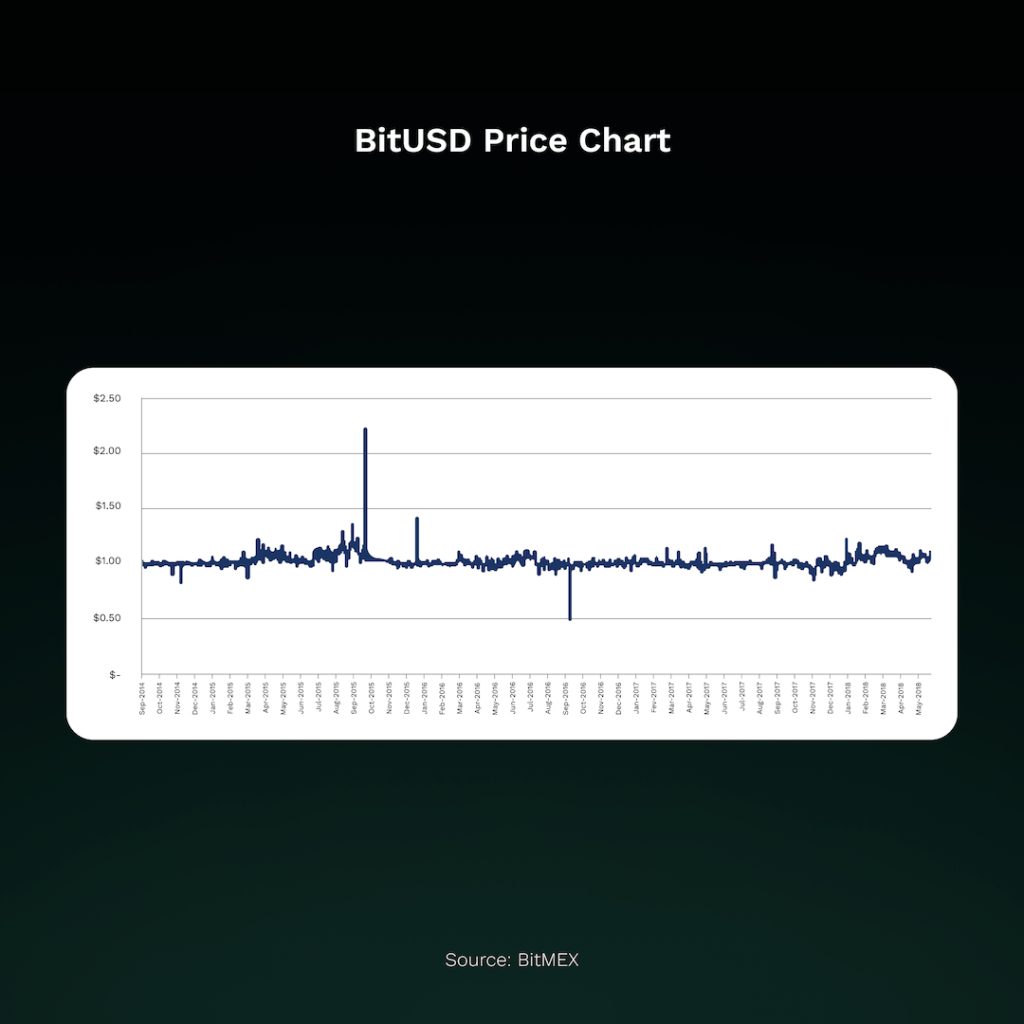
The concept of stablecoins, now a cornerstone of the cryptocurrency ecosystem, has its roots in an early project launched on July 21, 2014. BitUSD, the world’s first stablecoin, emerged on the BitShares blockchain, marking a significant milestone in the evolution of digital assets.
Conceived by visionaries Dan Larimer (EOS) and Charles Hoskinson (Cardano), BitUSD aimed to address the volatility issues plaguing early cryptocurrencies. This innovative approach sought to create a digital asset that could maintain a stable value relative to the US dollar, opening new possibilities for practical use cases in the blockchain world.
BitUSD employed a crypto-backed model, using the native BitShares token as collateral. This design attempted to maintain a 1:1 parity with the US dollar through a system of smart contracts and market incentives. However, the inherent volatility of its collateral asset proved to be a significant weakness.
In 2018, BitUSD lost its dollar peg and failed to recover, highlighting critical flaws in its design:
Collateral Vulnerability: The use of BitShares, itself an untested and volatile asset, as collateral exposed BitUSD to significant risk. Sharp declines in BitShares’ value could potentially leave insufficient collateral to maintain the peg.
Absence of a Price Oracle: The lack of a reliable mechanism to provide real-world exchange rates was a controversial aspect of BitUSD’s design. This omission made it challenging to maintain accurate pricing and stability.
Limited Arbitrage Mechanics: While the system allowed for arbitrage when BitShares prices fell, it didn’t provide mechanisms for the opposite scenario, leading to asymmetric risk.
Despite its ultimate failure to maintain stability, BitUSD’s importance in the history of cryptocurrencies cannot be overstated. It successfully introduced the concept of pegged stablecoins to the wider blockchain community, paving the way for future innovations in this space.
The lessons learned from BitUSD’s challenges have been invaluable for subsequent stablecoin projects. Modern stablecoins have implemented more sophisticated mechanisms, such as diversified collateral, improved price oracles, and enhanced governance models, addressing many of the issues faced by their predecessor.
Type of Stablecoins
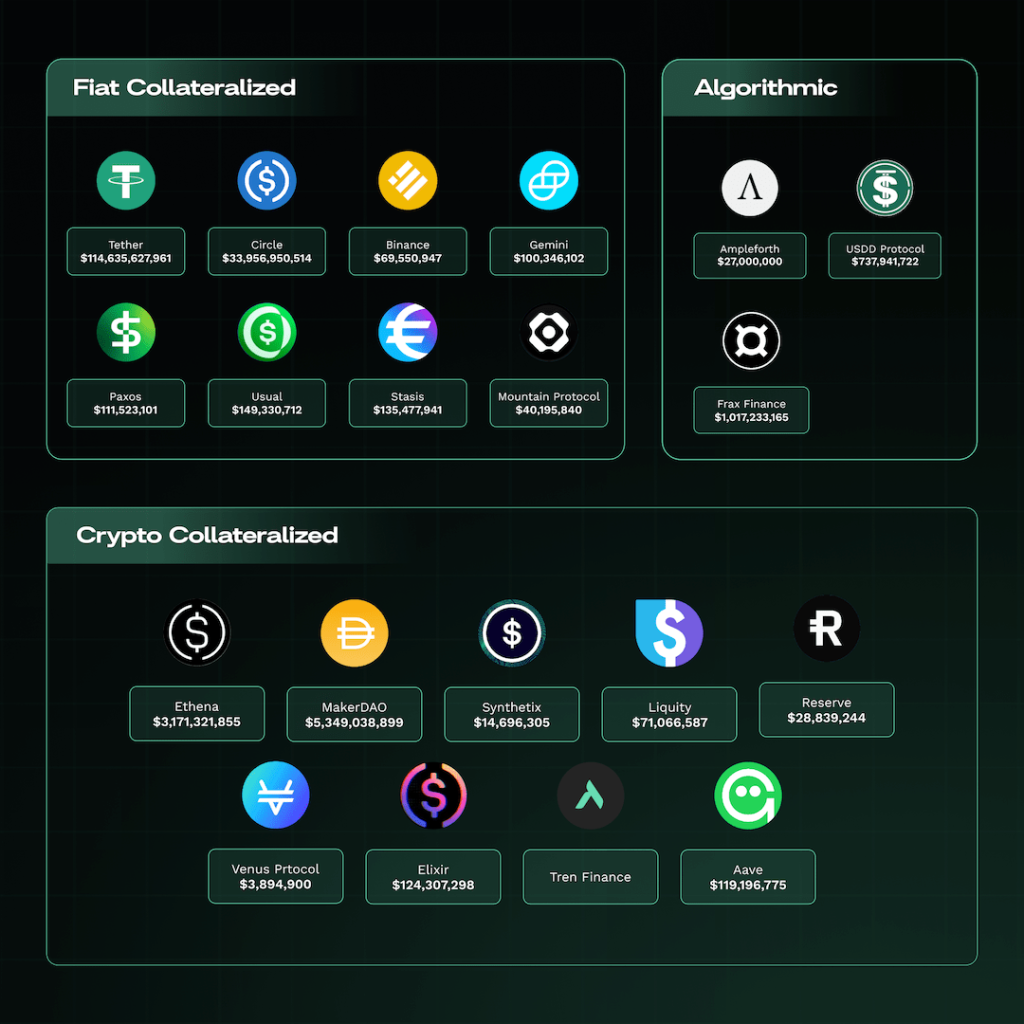
As the stablecoin ecosystem has evolved, three primary categories have emerged, each with distinct mechanisms for maintaining price stability: fiat backed, crypto backed, and algorithmic stablecoins.
1. Fiat Backed Stablecoins
Fiat backed stablecoins, also known as centralized or off-chain collateralized stablecoins, are backed 1:1 by reserves of fiat currency, typically U.S. dollars. These reserves are held in traditional financial institutions.
- Maintained by centralized entities
- Backed by highly liquid, low-risk assets (cash or cash equivalents)
- Subject to regular audits to verify reserves
- Generally considered the most stable and least risky
Advantages
Disadvantages
High stability and low volatility
Easier to understand for traditional investors
Often more regulatory compliant
Reliance on centralized entities
Potential lack of transparency in reserve management
Susceptible to regulatory actions
2. Crypto Backed Stablecoins
Crypto backed stablecoins, also referred to as on-chain collateralized stablecoins, use other cryptocurrencies as collateral. To account for the volatility of crypto assets, these stablecoins are typically over-collateralized.
- Collateralized by other cryptocurrencies
- Often utilize smart contracts for issuance and redemption
- Typically over-collateralized to account for price fluctuations
Advantages
Disadvantages
More decentralized than fiat-backed alternatives
Transparent, as collateral is visible on-chain
Not directly tied to traditional financial systems
More complex mechanisms
Susceptible to crypto market volatility
Higher potential for depeg events
3. Algorithmic Stablecoins
Algorithmic stablecoins are a type of cryptocurrency designed to maintain price stability through programmatic supply adjustments rather than being backed by external assets. These stablecoins use mathematical formulas and protocols to dynamically manage their supply and demand.
- No collateral backing
- Rely on algorithms to expand or contract token supply based on demand
- Often involve a dual-token system (stablecoin and governance token)
Advantages
Disadvantages
Highly decentralized structure
Potentially more capital efficient
Not tied to external assets
Automated supply adjustments
Community-driven governance
Complex mechanisms that can be difficult to understand
Higher risk of failure or loss of peg
Susceptible to speculative attacks and market volatility
Potential for catastrophic failure, as demonstrated by Terra UST’s collapse in 2022
The Current State of Stablecoins
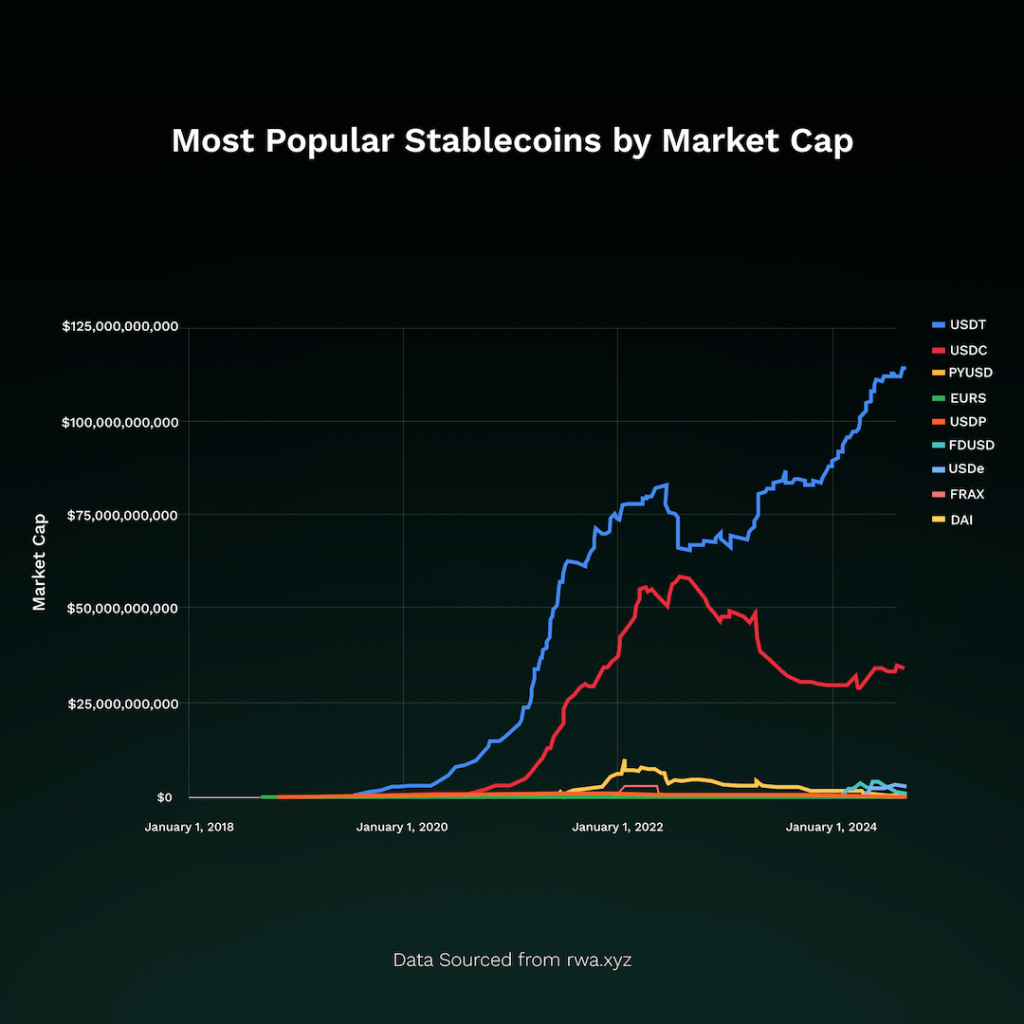
Since the introduction of BitUSD the stablecoin market has undergone significant growth and transformation. Today, Tether’s USDT token dominates the landscape, accounting for approximately 69% of the total stablecoin market capitalization. The sector now represents a substantial portion of the overall cryptocurrency market, with a combined market capitalization of $164 billion. The significance of stablecoins is further underscored by the volume of on-chain transfers, which reached $1.62 trillion between July 7th and August 7th, 2023, and their widespread adoption, with 111 million wallets currently holding these assets.
The rapid growth of the stablecoin market has been primarily driven by applications in DeFi, trading, and liquidity management, rather than the initially expected revolutions in mobile payments, remittances, or settlements. As the cryptocurrency market matures, both individual users and businesses are increasingly recognizing the unique combination of stability, security, and speed that stablecoins offer for financial transactions.
Significant developments in the regulatory environment, such as the Markets in Crypto-Assets Regulation (MiCA) in Europe and the introduction of a stablecoin framework in Singapore, are shaping the future of this sector. These advancements, coupled with improvements in infrastructure around custody, identity management, and accessibility, are enhancing the usability of stablecoins and attracting more institutional actors to the market.
Beyond the cryptocurrency ecosystem, stablecoins present promising solutions for multinational organizations requiring efficient cross-border settlement transactions. Industries such as telecommunications, postal services, and logistics could benefit from stablecoins for settling various charges and costs. As the market continues to evolve, stablecoins may also serve as effective hedges against inflation in specific regions, potentially tracking baskets of currencies or goods to maintain stability in diverse economic environments.
One prediction we have is the emergence of identity-based stablecoins, where people will transact in branded stablecoins that allow them to express who they are, the same way that people choose clothes based on who they are.
Stablecoin Examples
Let’s look deeper at the major stablecoins.
The Most Popular Stables: Tether’s USDT & Circle’s USDC
USD Coin (USDC) and Tether (USDT) have emerged as leading stablecoins in the cryptocurrency ecosystem. USDC, created by Circle in collaboration with Coinbase, was launched in September 2018. Founded by Jeremy Allaire in 2013, Circle initially aimed to simplify the process of converting, storing, and transferring digital currencies. USDT, issued by Tether Limited, has been in circulation since 2014 and was the first stablecoin created, maintaining its position as the largest by market capitalization.
The Centre Consortium, a joint venture between Circle and Coinbase, oversees USDC. This collaboration establishes a standard for fiat representation on the internet and provides a governance framework for the global adoption of fiat stablecoins. Tether Limited manages USDT, and operates independently.
Key Features and Transparency
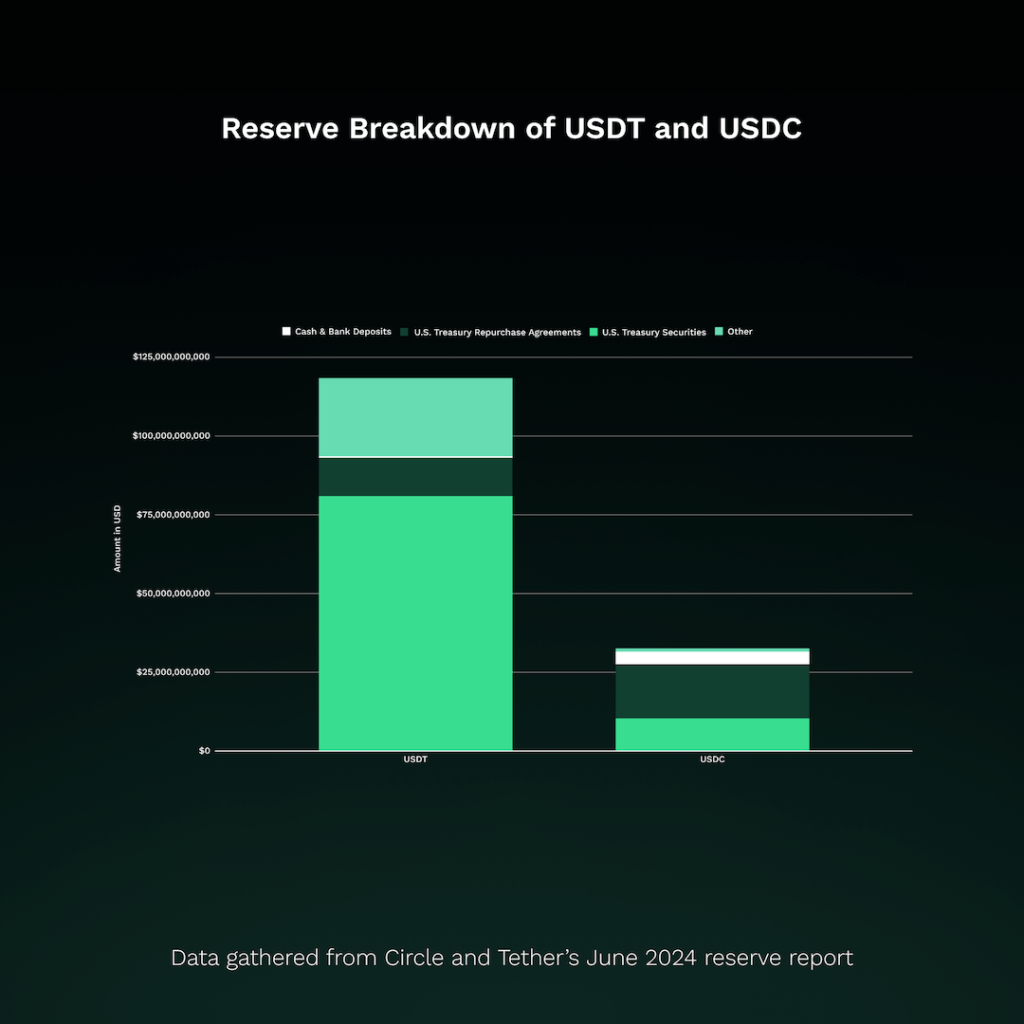
USDC distinguishes itself through its commitment to regulatory compliance and transparency. The cornerstone of USDC’s stability is its 1:1 backing, where for every USDC in circulation, Circle maintains an equivalent amount in cash and highly liquid, short-term U.S. government securities.
As of August 1, 2024, Circle’s reserve composition report provides a clear picture of USDC’s backing:
Total USDC in circulation: $32.9 billion
Total reserves: $33.0 billion
The reserves are composed of cash held at reserve banks and investments in the Circle Reserve Fund. This slight over-collateralization offers an additional layer of security for USDC holders.
Tether, while initially less transparent, has made significant strides in disclosure. As of June 30, 2024, Tether’s reserves totaled $118.4 billion, backing the USDT in circulation. Tether’s reserves are more diverse, including:
U.S. Treasury Securities: $80.9 billion
U.S. Treasury Repurchase Agreements: $12.3 billion
Cash & Bank Deposits: $109.9 million
Circle’s practice of providing weekly reports and monthly attestations enhances its credibility in the market. These reports offer insights into the dynamics of USDC issuance and redemption:
- Over the past year, $109.1 billion of USDC was issued and $102.5 billion was redeemed, resulting in a net increase of $6.5 billion in circulation.
- In the short term (7 days), there was a slight decrease in circulation (-$0.9 billion), while the 30-day trend shows a small increase (+$0.4 billion).
Tether has increased its reporting frequency, now providing quarterly assurance opinions. While not as frequent as USDC’s reports, this represents a significant improvement in Tether’s transparency.
This level of disclosure from both stablecoins allows users, investors, and regulators to verify the stability and backing of the tokens regularly, creating trust in the digital assets.
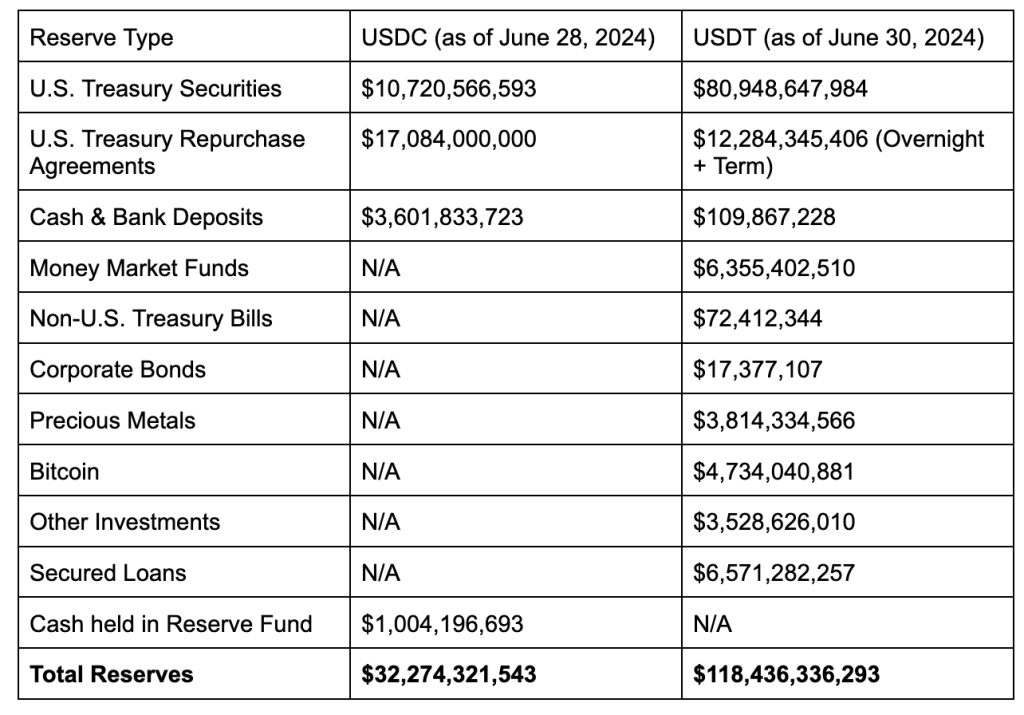
Price Stability
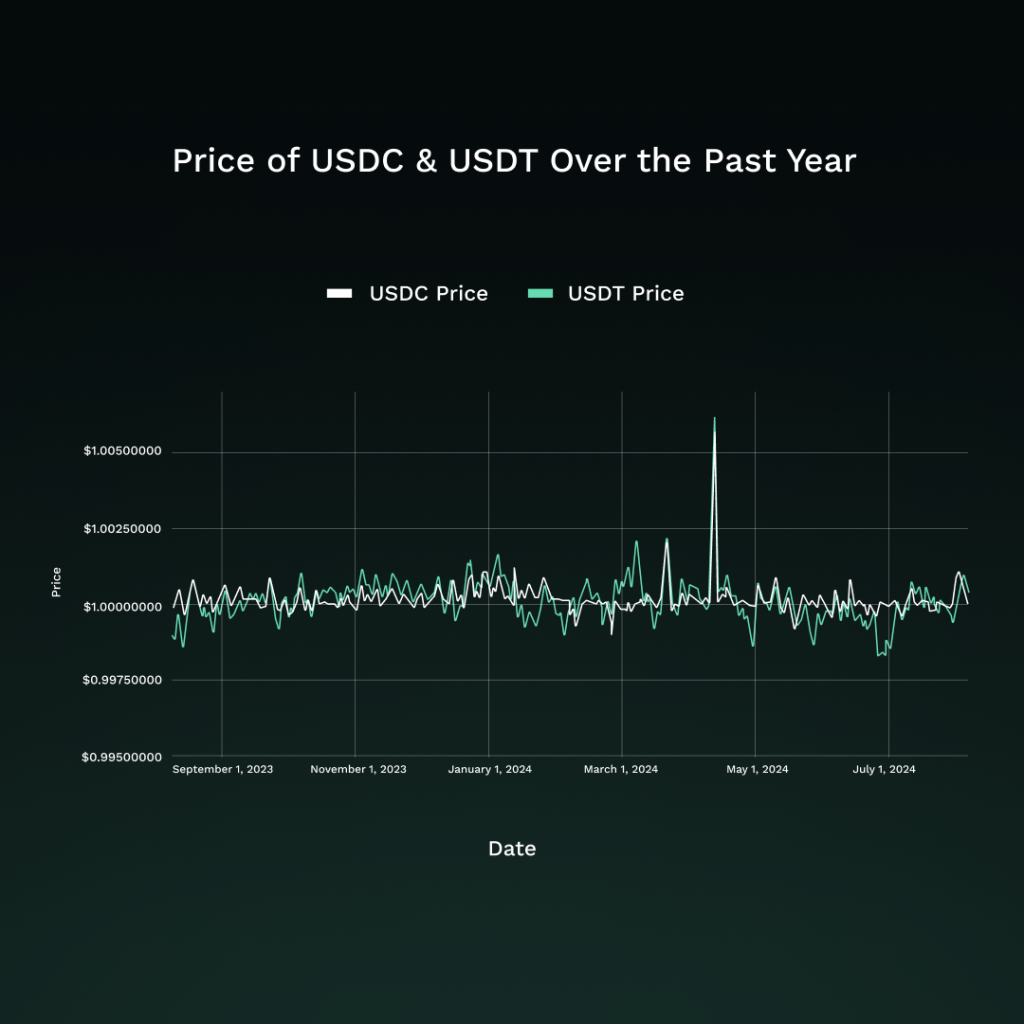
The chart comparing USDC and USDT prices over the past year demonstrates both stablecoins’ remarkable stability. Despite the zoomed-in nature of the chart, which amplifies small fluctuations, USDC has maintained an incredibly tight peg to the US dollar. Over the observed period, USDC’s price rarely deviated more than 5-10 basis points (0.05-0.10%) from its $1.00 target.
USDT, while also stable, shows slightly more pronounced fluctuations. Historically, USDT has experienced more significant deviations from its peg during market stress events. However, it has consistently recovered, demonstrating resilience and market confidence.
Market Position and Adoption
USDC has gained significant traction, available in over 180 countries and supported across 15 blockchain networks, with Ethereum hosting the majority of its supply. Key statistics as of the latest data include:
Monthly transfer volume: $528.1 Billion
Monthly active addresses: 2.6 Million
Total holders: 13 Million
USDT, being the larger and older stablecoin, typically sees even higher adoption metrics:
Monthly transfer volume: $641.1 Billion
Monthly active addresses: 6.3 Million
Total holders: 56.4 Million
Future Outlook
Circle envisions USDC as more than just a stablecoin, aiming to position it as a platform for building new financial systems, the digital currency of choice for institutional investors, and a tool for frictionless, borderless value exchange. The company’s expansion into euro-pegged stablecoins with EURC, compliant with MiCA regulations, demonstrates its intent to diversify and adapt to regional regulatory frameworks.
Tether continues to focus on maintaining its market-leading position while expanding to new blockchains and use cases. The company has also expressed interest in increasing its holdings of U.S. Treasury bills, potentially in response to regulatory scrutiny and to enhance the stability of its reserves.
As the digital asset ecosystem continues to evolve, both USDC and USDT will continue to play significant roles in facilitating cross-border transactions and providing stable digital representations of fiat currency. However, the stablecoin market remains competitive and subject to regulatory developments, which could impact the future growth and adoption of both tokens. The ongoing competition between USDC and USDT, as well as emerging stablecoins, will likely drive further innovations in transparency, stability, marketing and utility in the coming years.
USDe - Ethena
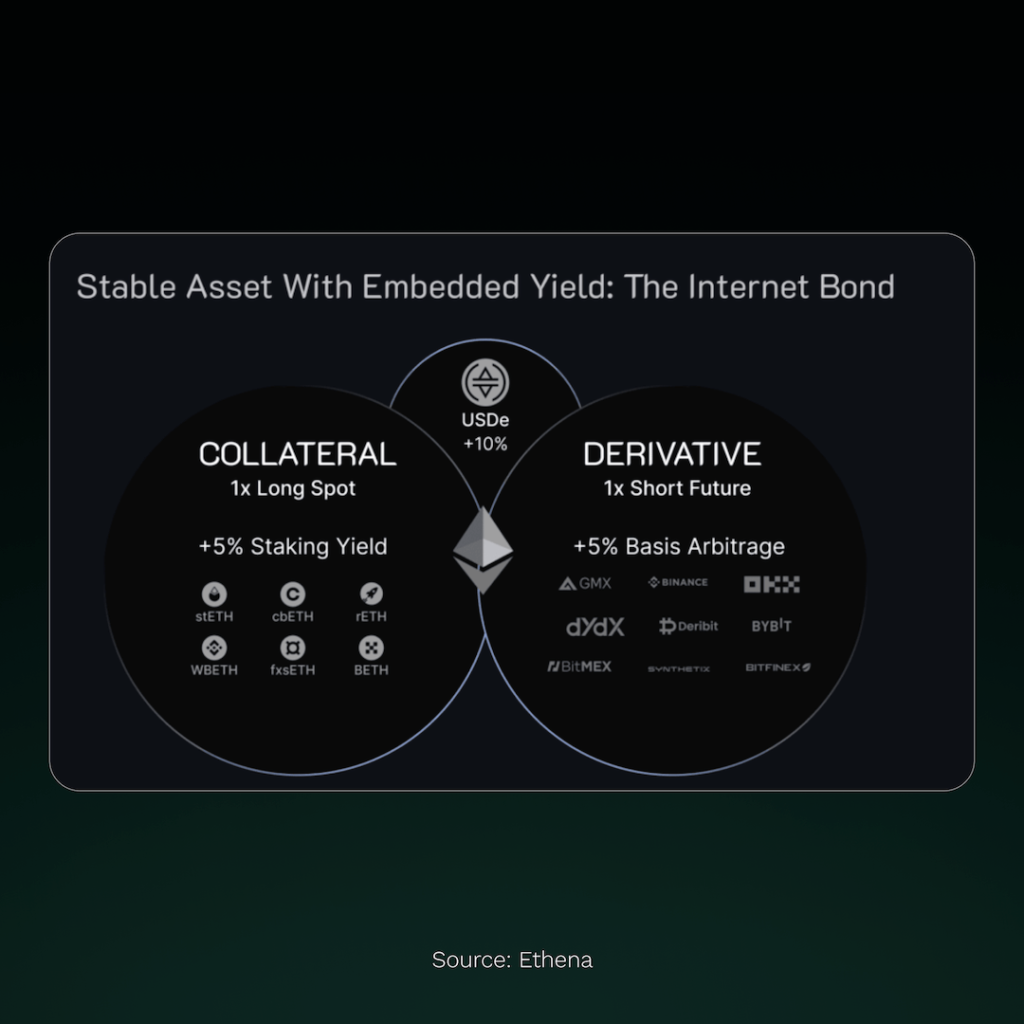
Launched in 2024, Ethena has quickly become a notable player in the stablecoin market with its “Synthetic Dollar”, USDe. Despite initial skepticism due to past incidents like the Luna collapse, Ethena has demonstrated the viability of its unique approach.
At its core, Ethena employs a cash and carry trade strategy, a concept well-established in traditional finance. This strategy involves using spot assets as collateral to open a short position in perpetual futures contracts linked to the same underlying assets. The key to Ethena’s success lies in its implementation of delta hedging.
Delta hedging is a risk management technique that aims to neutralize the impact of price movements on a portfolio. In simpler terms, it’s like balancing a seesaw. If one side goes up, the other goes down, keeping the overall position stable. Ethena applies this concept to maintain USDe’s stability around $1, regardless of market fluctuations.
Here’s a simplified explanation of how it works:
- Collateral: Ethena holds spot assets (like ETH) as collateral.
- Short Position: They simultaneously open a short position in perpetual futures contracts for the same asset.
- Balancing Act: If the asset’s price increases, the collateral value goes up, but the short position loses value, and vice versa.
- Profit Generation: Ethena profits from positive funding rates on the perpetual futures.
- Distribution: These profits are shared between USDe stakers and an insurance fund.
For example, if Ethena holds ETH worth $3000 as collateral and the price of ETH increases by 10% to $3300:
- The collateral value increases by $300
- The short position loses $300
- The net change in value is $0, maintaining stability
This delta-neutral strategy allows Ethena to offer attractive yields on USDe while mitigating the risks associated with market volatility, setting it apart in the evolving landscape of stablecoins.
Ethena's Approach and Potential Impact
Ethena’s USDe stablecoin utilizes a delta-neutral strategy to maintain price stability while generating yield. This approach differs from traditional stablecoins by using perpetual futures markets instead of fiat reserves. The mechanism allows USDe holders to earn returns from funding rates, while the delta-hedging strategy aims to mitigate price volatility risks.
The scalability of this model and its on-chain verifiability are notable features. As the DeFi ecosystem develops, Ethena’s approach to addressing stability, decentralization, and capital efficiency simultaneously may influence future stablecoin designs. However, like all financial products, USDe carries risks, and its long-term viability in various market conditions remains to be tested.
DAI
DAI, launched in December 2017, is a hybrid, multi-collateral-backed stablecoin managed by MakerDAO. Operating on the Ethereum network as an ERC-20 token, DAI aims to function in a trustless, permissionless, and decentralized manner. Created by Rune Christensen, who formed the Maker Foundation in 2014, DAI was designed to be a stable, non-volatile digital currency for loan payouts and other transactions within a decentralized, crypto-collateralized credit system.
Key Features
- Overcollateralization: Users create DAI by depositing collateral in ERC-20 tokens like ETH, Wrapped BTC, or USDC.
- Stability Mechanisms: DAI maintains its 1:1 USD peg through overcollateralization and liquidation of undercollateralized positions.
- Decentralized Governance: While initially created by the Maker Foundation, DAI is now overseen by MakerDAO, a Decentralized Autonomous Organization.
Creation Process
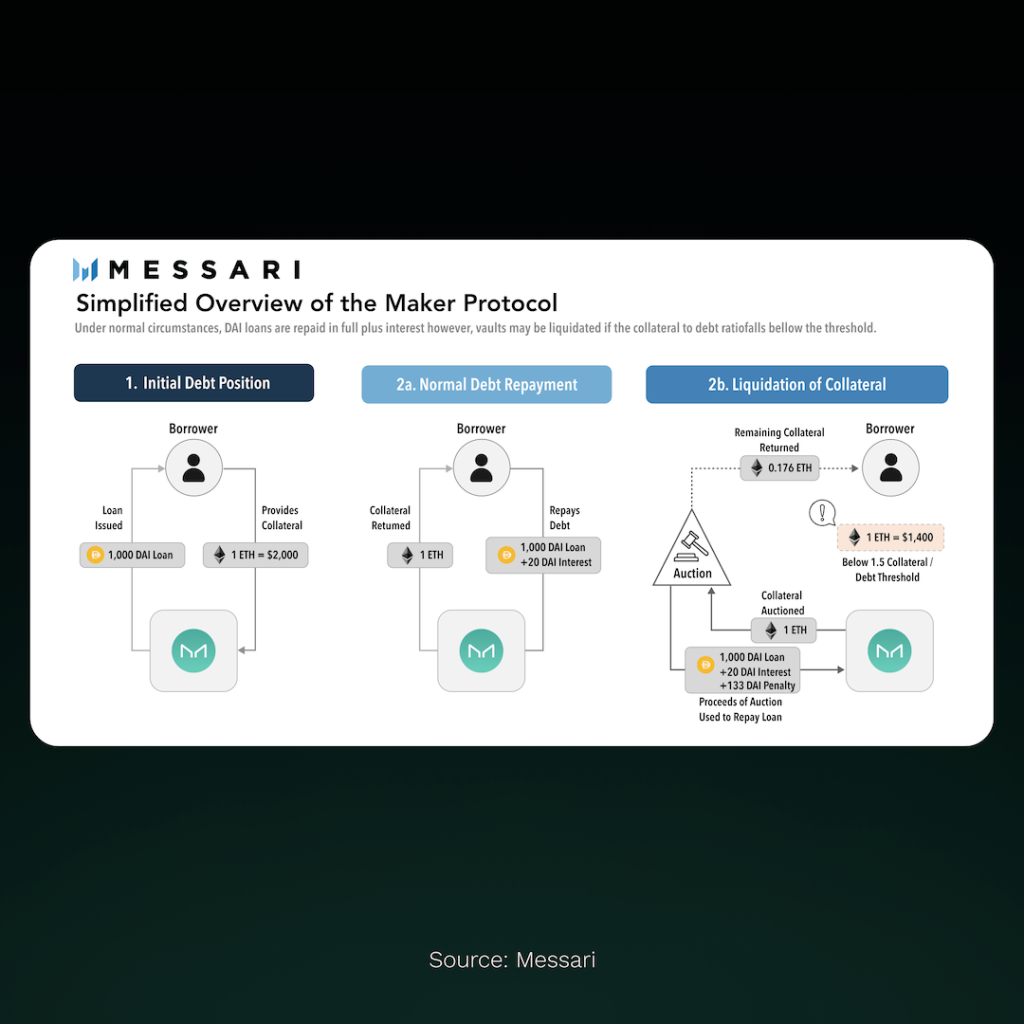
- Users open a Vault by sending collateral to a smart contract.
- They receive DAI in return, with the amount based on the collateral ratio.
- Users can repay DAI to unlock their collateral at any time.
- If collateral value drops below the minimum ratio, the position is liquidated.
Future Outlook: The Endgame Plan
MakerDAO’s future direction, outlined in its Endgame plan, involves the introduction of two new stablecoins: NewStable and PureDAI.
NewStable:
- Intended to be the main successor to DAI
- Focused on growth, yield, and resilience
- Will incorporate real-world assets (RWA) as collateral
- Will include a novel freeze function, subject to governance approval
PureDAI: A return to the project’s ideological roots
- Free-floating target price
- Highly decentralized collateral (ETH and stETH)
- Minimal governance
- Permanent location on Ethereum’s mainnet
- Planned for launch in the coming years
This dual-token approach aims to address the stablecoin trilemma by offering both utility and scale (NewStable) and complete decentralization (PureDAI). The Endgame plan represents MakerDAO’s attempt to evolve its stablecoin offerings to meet diverse market needs while maintaining its commitment to decentralization principles. However, the success of this strategy and its impact on the existing DAI token remain to be seen as the crypto landscape continues to evolve.
Mountain Protocol
Mountain Protocol, established in 2023, introduced USDM, a yield-generating stablecoin backed by short-term U.S. Treasury bills. The company operates under the regulatory framework of Bermuda’s Digital Asset Business Act, with oversight from the Bermuda Monetary Authority. This regulatory approach aims to provide clarity on bankruptcy remoteness and user protections, addressing concerns often associated with stablecoin issuers.
USDM employs a daily rebasing mechanism to distribute yields to token holders. As of August 1, 2024, USDM had $43,248,164.19 in circulation, backed by $44,118,565.08 in reserve assets. These reserves primarily consist of U.S. Treasury bills with maturities under 60 days, managed by an independent investment manager and held in custody by regulated financial institutions. Mountain Protocol publishes monthly attestation reports to verify its reserves, aiming for transparency in its operations.
The protocol has gained traction in the tokenized government securities market. Supported across eight blockchain networks, Mountain Protocol has established 40 ecosystem partnerships and 10 protocol integrations. This expansion indicates growing market acceptance of yield-bearing stablecoins. However, USDM’s market share remains relatively small compared to larger stablecoins, representing approximately 0.03% of the total stablecoin market capitalization.
Mountain Protocol faces several challenges and risks. These include potential U.S. debt default, interest rate fluctuations affecting reserve values, liquidity management during high withdrawal periods, and reliance on third-party service providers. The company has implemented risk mitigation strategies, such as over-collateralization to withstand interest rate changes and partnerships to ensure 24/7 liquidity. Additionally, as USDM is an ERC-20 token, its value in secondary markets may deviate from its $1 peg due to various market factors. The long-term success of Mountain Protocol will depend on its ability to navigate these challenges while maintaining regulatory compliance and user trust.

Abu Dhabi Global Markets said it best: “utility of stablecoins is directly related to it’s quality as store of value.” As such, yield-bearing stablecoins should become the standard for the complete stablecoin market, which should be a lot larger than the beachhead treasury market we are all pursuing today.
Martin Carrica
Co-Founder, Mountain Protocol
Commodities
Commodity trading, a cornerstone of the global economy for centuries, is currently experiencing a significant transformation through the advent of blockchain technology and tokenization. This revolution marks one of the first major shifts in the industry in decades, introducing a new paradigm for investment and trade in the commodities sector.
Tokenized commodities utilize blockchains to represent physical goods such as gold, oil, or agricultural products as digital tokens. These tokens typically correspond to a fraction of the total value or quantity of the underlying commodity, often maintaining a 1:1 claim ratio. This innovative approach is underpinned by blockchain’s core attributes: a secure, transparent, and immutable transaction ledger.
The role of blockchain in this transformation extends beyond mere representation. It establishes a verifiable link between each token and its underlying asset, effectively preventing fraud and double spending. Smart contracts, a key feature of blockchain technology, automate and enforce trading terms, significantly reducing the need for intermediaries and enhancing overall market efficiency.
Use Cases for Tokenized Commodities
Integration with Decentralized Finance: Tokenized commodities can seamlessly integrate with DeFi platforms, unlocking new financial possibilities. For instance, a tokenized oil asset could serve as collateral on lending platforms, enabling users to secure loans for other investments. This integration activates traditionally static assets, allowing for more dynamic capital utilization and complex on-chain investment strategies.
Enhanced Portfolio Diversification: Tokenized commodities offer a solution to the diversification challenges faced by many crypto projects and investors. By incorporating these assets, on-chain portfolios can achieve better balance and risk management. This is particularly valuable for crypto projects seeking to allocate their treasuries beyond volatile cryptocurrencies or low-yield stablecoins. Tokenized commodities provide exposure to various uncorrelated asset types, enabling a more robust and balanced investment approach.
Commodity-Backed Stablecoins: The concept of using tokenized commodities to back overcollateralized stablecoins represents another promising application. Similar to how MakerDAO has integrated U.S. Treasury bonds alongside cryptocurrencies to collateralize DAI, tokenized commodities could further diversify and strengthen stablecoin reserves. Incorporating assets like precious metals, energy resources, or agricultural products into stablecoin collateral pools could enhance stability and resilience, as these commodities often move independently of crypto markets and traditional financial instruments.
Current Challenges
While blockchain technology has paved the way for tokenized commodities, several significant challenges must be addressed for this innovation to fully realize its potential in commodity markets. Regulatory complexity stands as a primary hurdle. Tokenized commodities often fall under existing legal frameworks for securities, commodities, and financial markets, requiring navigation through intricate regulatory environments.
Market depth and liquidity present another significant challenge. Despite the potential for 24/7 trading and fractional ownership, building sufficient market depth to accommodate large-scale transactions remains difficult. The success of tokenized commodity markets hinges on attracting institutional investors and traditional market participants, which requires establishing trust and demonstrating the viability of these new trading mechanisms.
Most Popular Tokenized Precious Metal Products
Name
Issuer
Chain
Pegged Commodity
Paxos Gold
Paxos
Ethereum
Gold
Tether Gold
Tether
Ethereum
Gold
tGold
Aurus
Ethereum
Gold
Comtech Gold
Comtech Gold
XDC
Gold
tSilver
Aurus
Ethereum
Silver
WisdomTree Gold
Wisdom Tree
Stellar
Gold
tPlatinum
Aurus
Ethereum
Platinum
VNX Gold
VNX
Ethereum
Gold
Tokenized Commodity Example
Let’s take a look at a live example of a tokenized commodity: gold.
Paxos Gold
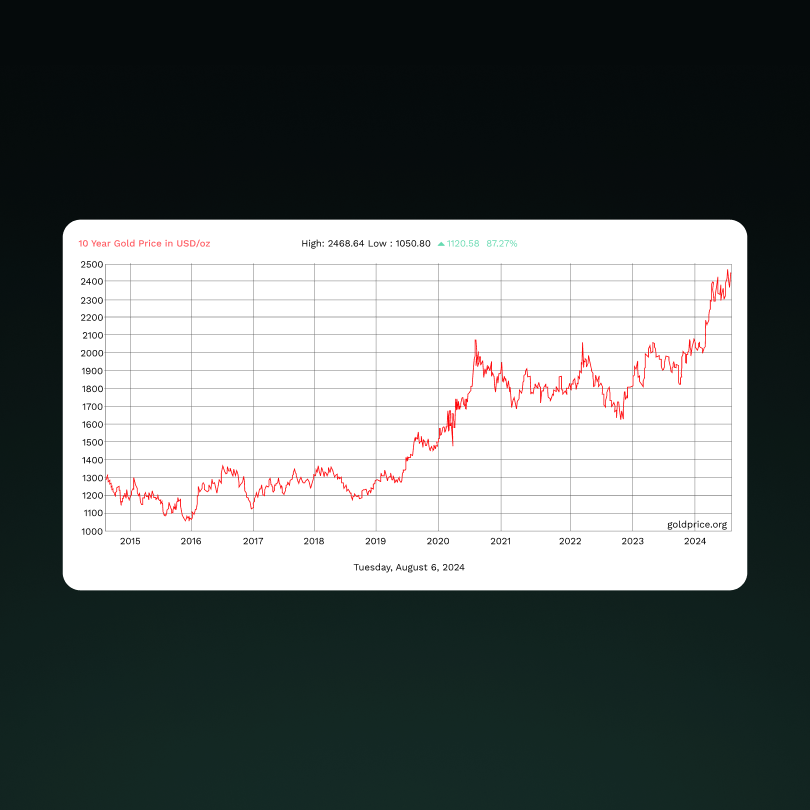
Paxos launched their gold product, Paxos Gold (PAXG), in 2019 with the aim of bringing a portion of the world’s 212,000 tonnes of gold on-chain. Gold has long been recognized as one of the most enduring assets, serving as a reliable form of money for centuries. Its significance in the global financial system was underscored by its role in backing the US dollar until 1971. The price of gold has seen significant appreciation over the past decade, rising from around $1,200 per ounce in 2015 to over $2,400 in 2024. PAXG represents an attempt to merge this time-tested asset with modern blockchain technology, potentially transforming how gold is owned, traded, and utilized in the digital age.
Key Features
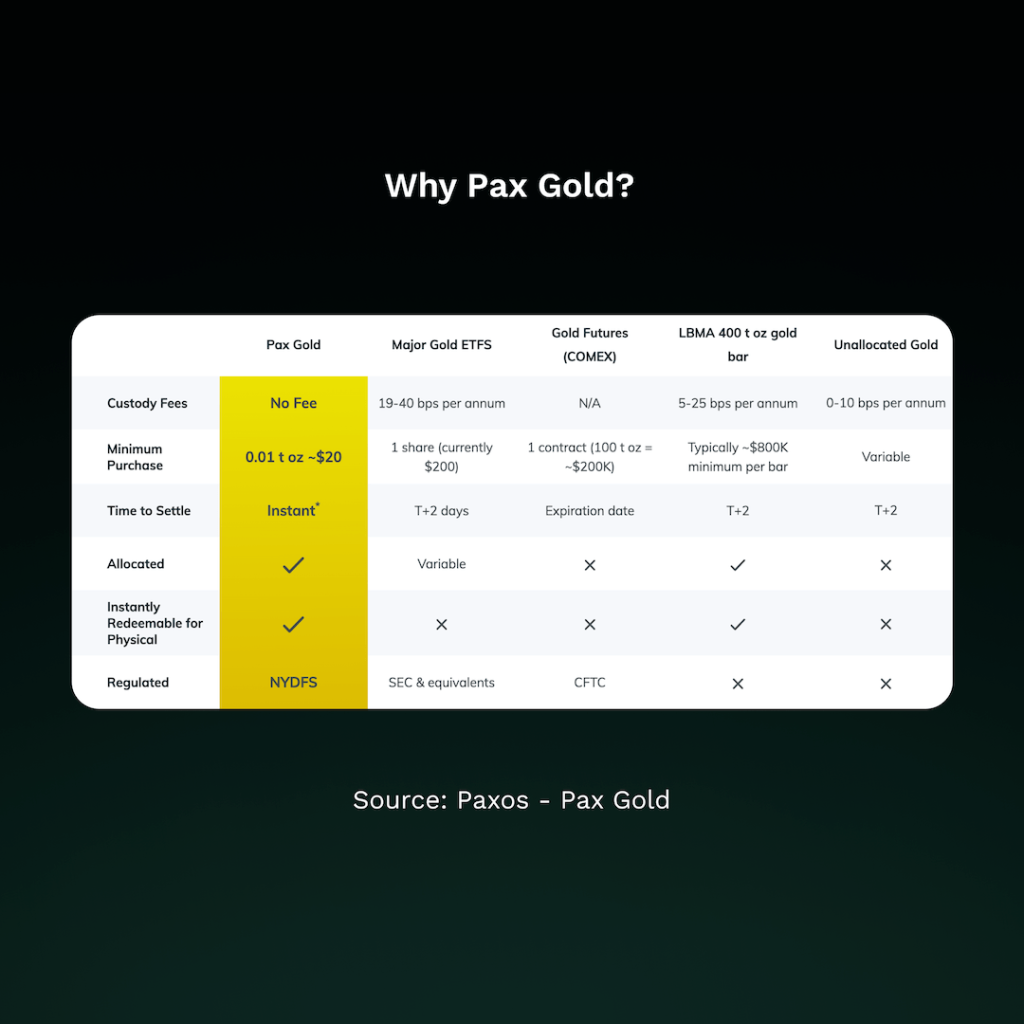
Unprecedented Accessibility: PAXG dramatically lowers the barrier to entry for gold investment. Traditional gold bars, typically 400 ounces and worth around $964,000, are out of reach for most individual investors. PAXG allows investments as small as 0.01 troy ounces (approximately $24), making institutional-grade gold accessible to a much wider range of investors.
Simplified Logistics and Liquidity: PAXG eliminates the complexities associated with physical gold ownership. Paxos handles all aspects of storage and transportation, removing the need for investors to manage security and logistics. Moreover, PAXG tokens can be instantly sold or traded 24/7 on various cryptocurrency exchanges, providing unprecedented liquidity compared to physical gold.
Cost-Efficiency and Regulatory Compliance: PAXG minimizes traditional gold investment costs by eliminating storage fees and reducing transaction costs. As a regulated financial institution, Paxos ensures PAXG adheres to strict compliance standards, offering a level of trust and oversight often lacking in the cryptocurrency space.
Market Performance and Potential
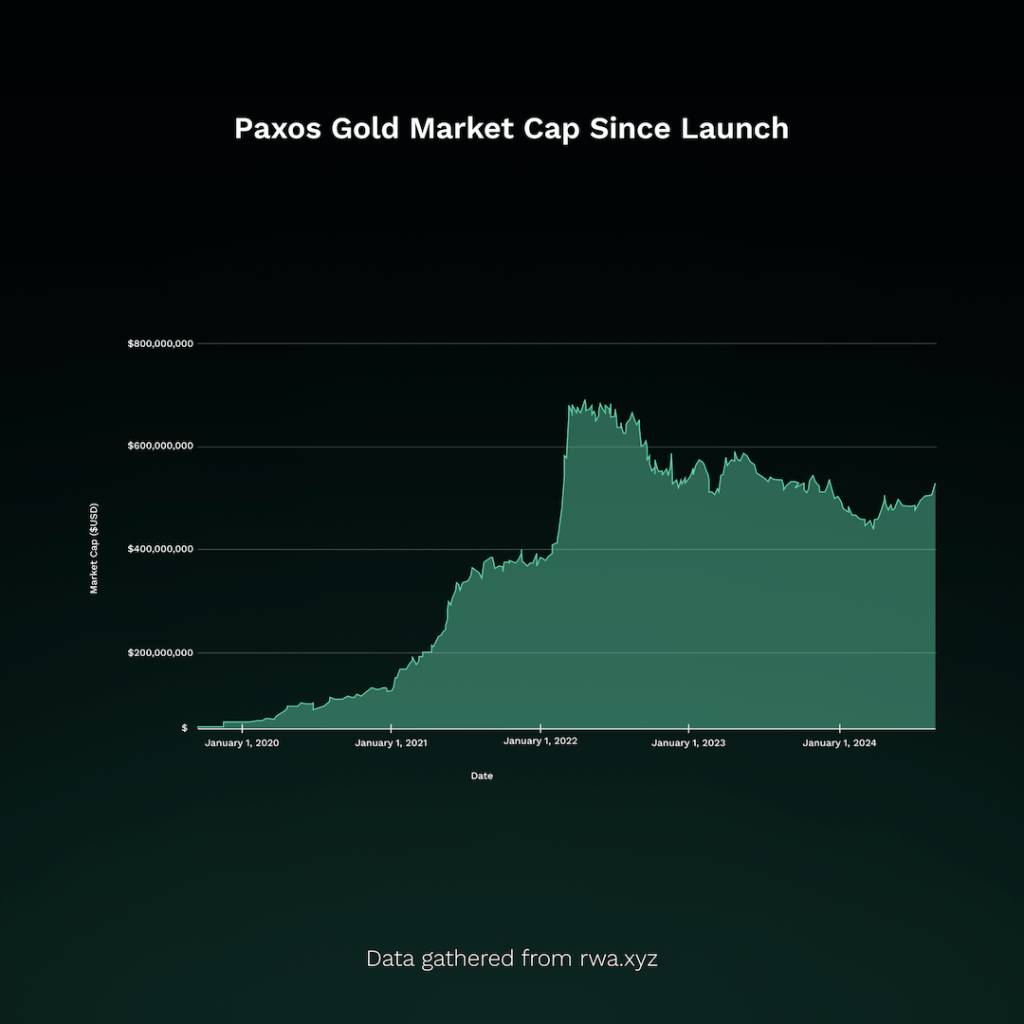
The circulation of PAXG has experienced steady growth since its inception, indicating increasing demand for tokenized gold. Notably, supply has remained relatively stable since 2022, even during bear markets in the broader cryptocurrency space. This stability underscores the appeal of gold-backed tokens as a store of value in volatile market conditions. The growing interest in accessible gold investment vehicles like PAXG aligns with the overall trend of gold’s increasing importance in investment portfolios.
Challenges and Future Outlook
While PAXG has made significant strides in democratizing gold ownership, challenges remain. These include regulatory uncertainties in various jurisdictions and the need for wider adoption among traditional financial institutions. However, the potential for growth is substantial. The total gold market accounts for approximately 212,582 tonnes, while PAXG currently represents just 185,852.614 troy ounces (about 5.78 tonnes) of tokenized gold (0.002718950805%). This stark difference illustrates the immense growth potential for PAXG and similar tokenized gold products in the coming years. As the tokenization of real-world assets gains traction, PAXG stands as an example of how blockchain technology can revolutionize traditional asset markets. By addressing key pain points in gold ownership and trading, PAXG offers insight into the future of asset management where traditional value stores seamlessly integrate with digital innovation.
VNX
Launched in 2021, VNX’s tokenized gold product, VNXAU represents ownership of physical gold bars stored in a high-security vault in Liechtenstein. Each VNXAU token corresponds to 1 gram of gold that complies with London Bullion Market Association (LBMA) standards.
A key feature of VNXAU is its regulatory compliance. VNX Commodities AG is registered with the Financial Market Authority of Liechtenstein as a TT Service Provider under the country’s blockchain laws. Furthermore, VNX operates across multiple jurisdictions, with a Luxembourg-based entity registered as a virtual assets service provider (VASP) with the CSSF. This dual-jurisdiction approach, covering both CHF and EUR, positions VNX uniquely in the European market. The regulatory oversight adds a layer of legitimacy and security to the project. Additionally, VNX maintains a transparent Gold Entitlements Register, allowing token holders to verify their ownership of specific gold bars.
VNXAU tokens offer several advantages to investors. They are freely transferable across multiple blockchains including Ethereum, Avalanche, Polygon, Q, Solana, Tezos, and Stellar. This multi-chain strategy enhances accessibility and liquidity. Token holders have the option to redeem their tokens for physical gold, either by collecting it from the vault in Liechtenstein or requesting delivery (with a minimum of 1kg). Alternatively, holders can sell their tokens back to VNX Commodities for fiat currency or supported cryptocurrencies.
As of October 1, 2024, there were 10,100 VNXAU tokens in circulation, backed by an equal amount of physical gold in grams. The tokens are distributed across multiple blockchains, with the majority (6,605 tokens) on Ethereum. Beyond VNXAU, VNX also offers euro (VEUR) and Swiss franc (VCHF) backed tokens, demonstrating a comprehensive approach to tokenizing real-world assets.
VNX has secured significant institutional support, including a 2.2 million Euro grant from the Luxembourg government. The company has also partnered with Cumberland, a leading crypto OTC and market maker, to enhance liquidity and market access for its tokens. In the competitive landscape of tokenized assets, VNX distinguishes itself by focusing on European securities rather than U.S. securities, setting it apart from competitors like BlackRock and Franklin Templeton.
With its regulatory compliance, physical gold backing, flexible redemption options, and strategic positioning in the European market, VNXAU represents an interesting case study in the evolving landscape of tokenized real-world assets.

“With MiCA regulation now in effect, Europe is entering a new phase of structured growth in the digital asset space. With global crypto ownership reaching 6.8% and Europe growing by 60.3% to 49.2 million users, the market is poised for rapid expansion. The RWA sector is set to take off, and VNX is ready to fuel this growth and capitalize on the opportunity ahead.”
Alexander Tkachenko
CEO & Founder of VNX
Real Estate
Real estate tokenization is the process of representing property ownership as digital tokens on blockchain platforms. This approach aims to address certain challenges in the traditional real estate market, such as limited liquidity, high capital requirements for entry, and transparency issues. The global real estate market was valued at $326.5 trillion in 2020 (ULI report), yet it remains one of the least liquid asset classes. Tokenization potentially offers a method to increase accessibility to this market.
By utilizing blockchain technology, tokenization allows for the digitization of property rights, which can then be divided into smaller units. This fractional ownership model may enable a broader range of investors to participate in real estate markets that traditionally require significant capital
Key Features of Tokenized Real Estate
Real estate tokenization combines the stability of traditional property investments with the flexibility of digital assets. The primary features include:
- Fractional Ownership: Properties can be divided into smaller, more affordable units, allowing a wider range of investors to participate in the real estate market.
- Increased Liquidity: Tokenized real estate assets can be traded more easily than traditional properties, potentially on 24/7 markets.
- Global Accessibility: Investors worldwide can participate in diverse real estate markets, breaking down geographical barriers.
- Transparency: Blockchain technology ensures clear ownership records and transaction history, enhancing trust in the investment process.
- Automation: Smart contracts handle various processes, reducing intermediary costs and streamlining operations.
The Tokenization Process
- Deal Structuring: This initial phase involves defining terms and conditions, ensuring regulatory compliance, and preparing the property for tokenization.
- Digitization: Property information is uploaded to the blockchain, smart contracts are coded, and tokens are issued representing ownership shares.
- Primary Distribution: Tokens are distributed to investors, and investor information is recorded on a digital register of members.
- Post-tokenization Management: Corporate actions such as dividends and voting are handled via smart contracts, streamlining property management.
- Secondary Trading: Token trading between investors is enabled, either over-the-counter or on specialized exchanges.
Future Outlook
As the technology and business models around tokenization continue to mature, real estate tokenization has the potential to create new business opportunities and transform existing operations. Some potential future applications and benefits include:
- Fractionalized Ownership: By allowing investors to purchase smaller portions of properties, tokenization could democratize real estate investment. This would enable a broader range of individuals to participate in the real estate market, potentially increasing overall market liquidity and diversity.
- Lower Barrier to Entry: With the ability to invest smaller amounts, more people could earn income from real estate investments. This could provide new avenues for wealth creation and financial inclusion, particularly for those previously priced out of the traditional real estate market.
- Lease-to-own Arrangements: Tokenization could facilitate gradual property purchases, allowing tenants to acquire ownership tokens over time. This model could make homeownership more accessible, especially in markets with high property values.
- Co-working Spaces: Tokenized commercial properties could integrate time-sharing or co-working spaces, linking fractional ownership with community engagement. This could create new models for commercial real estate utilization and investment.
However, challenges remain. Regulatory uncertainty in many jurisdictions, limited awareness in the traditional real estate sector, and potential technical vulnerabilities need to be addressed. The success of real estate tokenization will depend on overcoming these hurdles and demonstrating clear benefits over traditional property investment methods.
As the market evolves, tokenized real estate has the potential to increase accessibility, enhance liquidity, and bring operational efficiencies to the property sector. While the full impact remains to be seen, real estate tokenization represents a significant step towards modernizing one of the world’s largest asset classes.
Protocol Overview
Protocol
Description
Sabai Properties
Integrates real estate into the metaverse, allowing users to invest in tokenized properties within a virtual environment that combines physical assets with digital experiences.
Parcl
Allows users to gain exposure to real estate markets by trading digital assets tied to the price movements of real-world property markets, offering a liquid and accessible way to invest in real estate.
Etherland
Focuses on the tokenization of real-world locations, enabling users to buy, sell, and trade tokenized land on the blockchain, with an emphasis on digital representation and global accessibility.
RealT
Specializes in fractional ownership of U.S. real estate, allowing investors worldwide to purchase tokenized shares of rental properties and earn passive income through blockchain technology.
Landshare
Offers a DeFi-based platform that enables fractional real estate investing, allowing users to buy shares in tokenized properties and participate in property appreciation and rental income.
Propchain
Combines real estate and blockchain technology to allow users to invest in tokenized properties, offering fractional ownership and access to global real estate markets.
Lofty
Provides a platform for fractional ownership of real estate, allowing users to buy tokenized shares of rental properties and earn passive income through blockchain technology.
Tangible
Facilitates the trading of tokenized real-world assets, including real estate, through NFTs, providing a secure and transparent way to own and transfer property on the blockchain.
Lufina
Focuses on luxury real estate, allowing users to invest in high-end properties through tokenization, making premium real estate accessible to a broader audience.
metawealth
Provides access to fractional ownership in global real estate through blockchain technology, allowing users to diversify their investment portfolio with tokenized property assets.
Brickblock
Bridges the gap between real estate and blockchain by enabling tokenized investments in real-world properties, offering a secure and efficient way to invest in global real estate.
Propy
Streamlines real estate transactions by enabling property purchases and sales through blockchain technology, focusing on transparency and security in property transfers.
Real Estate Example
Let’s look at an example from the tokenized real estate category.
Lofty
Lofty AI is a real estate tokenization platform that operates as a marketplace, allowing property owners to sell fractional ownership of their properties to multiple investors. Founded with the goal of democratizing real estate investment, Lofty has quickly gained traction in the market, attracting approximately 7,000 monthly active users as of September 2023.
Unlike traditional real estate investment funds, Lofty functions as a marketplace similar to Airbnb or eBay, connecting property owners with investors. This model has enabled the platform to tokenize 148 properties across 11 US states, demonstrating its ability to scale across diverse real estate markets. The platform’s approach to tokenization uses Algorand Standard Assets (ASAs) to represent an investor’s stake in a property, allowing for fractional ownership with investments starting as low as $50.
Key Features
- Marketplace Model: Lofty’s marketplace approach facilitates direct connections between property owners and investors.
- Tokenization: Properties are tokenized using ASAs, providing a blockchain-based representation of ownership.
- Fractional Ownership: With an average of 231 buyers per property, Lofty has made real estate investment accessible to a broader range of investors.
- Governance: Token holders participate in property management decisions through a legal DAO (Decentralized Autonomous Organization) structure, empowering investors with real decision-making authority.
- Liquidity: Lofty offers a secondary marketplace for trading property tokens, enhancing liquidity for investors.
Tokenization Process
Property Listing: Owners submit properties for listing on the Lofty marketplace.
- Due Diligence: Third-party providers conduct property inspections and appraisals.
- Background Checks: Property owners undergo background and credit checks.
- Legal Structure: Properties are transferred to individual Wyoming LLCs.
- Token Sales: Investors can purchase equity in the property through token acquisition.
Benefits for Investors and Future Outlook
Lofty’s model offers several advantages that make it an exciting development in real estate investment. Investors can earn daily rental income with flexible withdrawals, potentially benefit from property appreciation, and enjoy the tax advantages associated with real estate investments. The absence of a mandatory lock-up period and the ability to vote on property decisions provide investors with flexibility and control.
The platform’s approach to professional property management also addresses one of the key barriers to real estate investment – the time and expertise required for effective property management. By handling these aspects, Lofty allows investors to benefit from real estate ownership without the traditional hands-on management responsibilities.
Looking ahead, Lofty’s model demonstrates the potential for tokenization to reshape real estate investment. The platform’s ability to lower entry barriers, provide enhanced liquidity, and offer a more engaged form of property ownership could lead to increased participation in real estate markets. As the platform continues to grow and evolve, it may pave the way for further innovations in how we conceptualize and engage with real estate as an investment asset.
Intellectual Property
Intellectual property (IP) refers to creations of the mind that are protected by law, encompassing inventions, literary and artistic works, designs, symbols, names, and images used in commerce. This includes patents, copyrights, trademarks, and trade secrets. As intangible assets, IP rights are crucial drivers of innovation and economic growth, often representing significant value for businesses and individuals.
However, the current IP market faces several critical challenges that hinder its full potential. Accurately assessing the value of IP assets is complex and often subjective, leading to potential undervaluation or overvaluation. IP assets are typically illiquid, making it challenging for rights holders to quickly monetize their intellectual property. Many inventors and creators struggle to secure funding for their IP development, as traditional financial institutions often view IP as high-risk collateral.
The licensing process for IP can be time-consuming and costly, involving complex negotiations and legal procedures. Furthermore, the opacity in IP transactions can lead to disputes over ownership and usage rights. Fragmented markets, often siloed by industry or geography, limit potential buyers and sellers, further complicating the IP landscape.
IP tokenization represents a significant innovation in addressing these issues. By converting IP rights into digital tokens on a blockchain, this process allows for fractional ownership, increased liquidity, and more efficient management of these valuable intangible assets. Tokenization has the potential to revolutionize how IP is valued, traded, and monetized, offering solutions to longstanding problems in the traditional IP management system.
Types of Intellectual Property
- Patents: Patents are granted to inventors, giving them the exclusive right to use, make, sell, or distribute their invention for a certain period.
- Trademarks: Trademarks protect symbols, names, and slogans used to identify goods or services.
- Copyrights: Copyrights provide protection for original works of authorship, including literary, musical, artistic, and certain other intellectual works.
- Trade Secrets: Trade secrets encompass formulas, practices, designs, instruments, or a compilation of information not generally known.
Benefits
- Fractionalization and Accessibility: IP can be divided into smaller, more accessible units, allowing for broader market participation. This enables startups and individual inventors to sell or license portions of their IP to fund development or attract investors. For instance, a software company could fractionalize rights to its code, selling tokens to finance future upgrades while retaining majority ownership.
- Enhanced Liquidity and Global Exposure: Tokenized IP can be traded 24/7 on blockchain platforms, dramatically increasing market liquidity. This global accessibility exposes IP to a worldwide audience of potential investors or licensees, potentially increasing its value. A patent owner in one country could easily connect with interested parties across the globe, facilitating international collaboration and commercialization.
- Transparency and Security: Blockchain technology provides an immutable record of IP transactions and ownership. This transparency helps reduce disputes and enhances security against fraudulent claims or unauthorized use. The technology can potentially save billions lost annually to IP infringement by creating a clear, verifiable chain of ownership and usage rights.
- Efficient Value Extraction through Smart Contracts: Tokenization enables IP owners to monetize their assets more effectively through automated, programmable agreements. Smart contracts can manage licensing terms, royalty distributions, and usage rights without intermediaries, reducing costs and increasing efficiency. For example, a musician could tokenize their song rights, with smart contracts automatically distributing royalties to token holders whenever the song is played.
IP and Copyrights
Copyrights, a subset of IP rights, protect literary and artistic works. The World Intellectual Property Rights Organization (WIPO) defines copyrights as rights creators have over their works, encompassing both economic and moral rights. Tokenization offers innovative solutions to copyright-specific challenges, potentially revolutionizing how creative works are managed and monetized in the digital age.
In the music industry, for example, tokenized copyrights could implement dynamic royalty structures that adjust in real-time based on a song’s popularity. This approach could incentivize early supporters of emerging artists and create a more equitable distribution of revenues. Similarly, in film production, smart contracts could automatically manage rights and royalties among various contributors – writers, directors, actors, and crew members – based on their specific inputs, streamlining a traditionally complex process.
Tokenization also opens up new possibilities for managing collaborative creations and time-based rights. It could facilitate a more nuanced approach to public domain entry, potentially implementing gradual transitions that automatically adjust usage rights and royalty distributions over time. This could strike a balance between protecting creators’ interests and ensuring public access to cultural works.
Use Cases
The tokenization of intellectual property (IP) is poised to revolutionize a wide range of sectors, offering new opportunities for innovation, collaboration, and value creation. This technological advancement is not limited to a single industry but has far-reaching implications across various fields. From research-intensive sectors to creative industries, the impact of this technology is both profound and diverse. The following examples illustrate how different industries are leveraging or could potentially benefit from IP tokenization:
- Pharmaceuticals and Biotechnology: These industries, with their high-value IP, can benefit from tokenization for funding research, managing patents, and fostering collaborative R&D efforts.
- Technology: Software companies can tokenize source codes and algorithms, protecting their digital assets while potentially opening new funding avenues for smaller developers.
- Culture and Creative Industries: Artists and content creators can tokenize their work, revolutionizing digital ownership and monetization in the creative space. This extends to tokenizing cultural archives and public domain works for preservation and research purposes.
Protocols Exploring IP Tokenization
Protocol
Sector
Description
Royal
Music
Focuses on music rights, allowing artists to tokenize their music royalties and sell them as investments.
Bolero
Music
A platform that enables the tokenization of various types of IP, including patents and trademarks, facilitating easier management and monetization.
JKBX
Music
This protocol allows music creators to tokenize their rights, enabling fans to invest in their favorite artists’ music.
IPwe
Industrial Property Rights
Offers a blockchain-based patent registry that revolutionizes patent management, allowing for easier licensing and monetization of patents.
Molecule
DeSci
A platform that focuses on tokenizing life sciences IP, enabling researchers to monetize their innovations through fractional ownership.
ACXYN
Gaming rights
This protocol aims to create a marketplace for tokenized IP, allowing creators to sell and trade their intellectual property.
Story Protocol
Blockchain
A layer 1 blockchain specifically for tokenizing IP, making it programmable and accessible, transforming various forms of IP into digital assets.
Tokenized IP Example
Story Protocol
Story Protocol is an open-source platform designed to standardize and automate the management of intellectual property (IP) on the blockchain. Launched in 2023, the project aims to create a decentralized infrastructure for registering, licensing, and monetizing creative works. Story Protocol addresses the challenges faced by creators in the digital age, where content is easily replicated and remixed, making it difficult to track ownership and ensure proper attribution and compensation.
The protocol has garnered significant attention from investors, raising $54 million in a funding round led by a16z crypto in 2023. This substantial investment, particularly noteworthy given the current market conditions, suggests strong confidence in Story Protocol’s potential to transform the IP landscape. As the digital content creation industry evolves, especially with the rise of AI-generated content and increasingly complex collaborative projects, Story Protocol positions itself as a solution to emerging IP management challenges.
The protocol’s architecture consists of three main components:
- Story Network (L1): A general-purpose Layer 1 blockchain optimized for handling complex IP-related data structures.
- Proof of Creativity Protocol: Manages core functions like licensing, automated royalty payments, and dispute resolution.
- Programmable IP License (PIL): A universal licensing agreement that facilitates the onramping and offramping of IP to and from the blockchain.
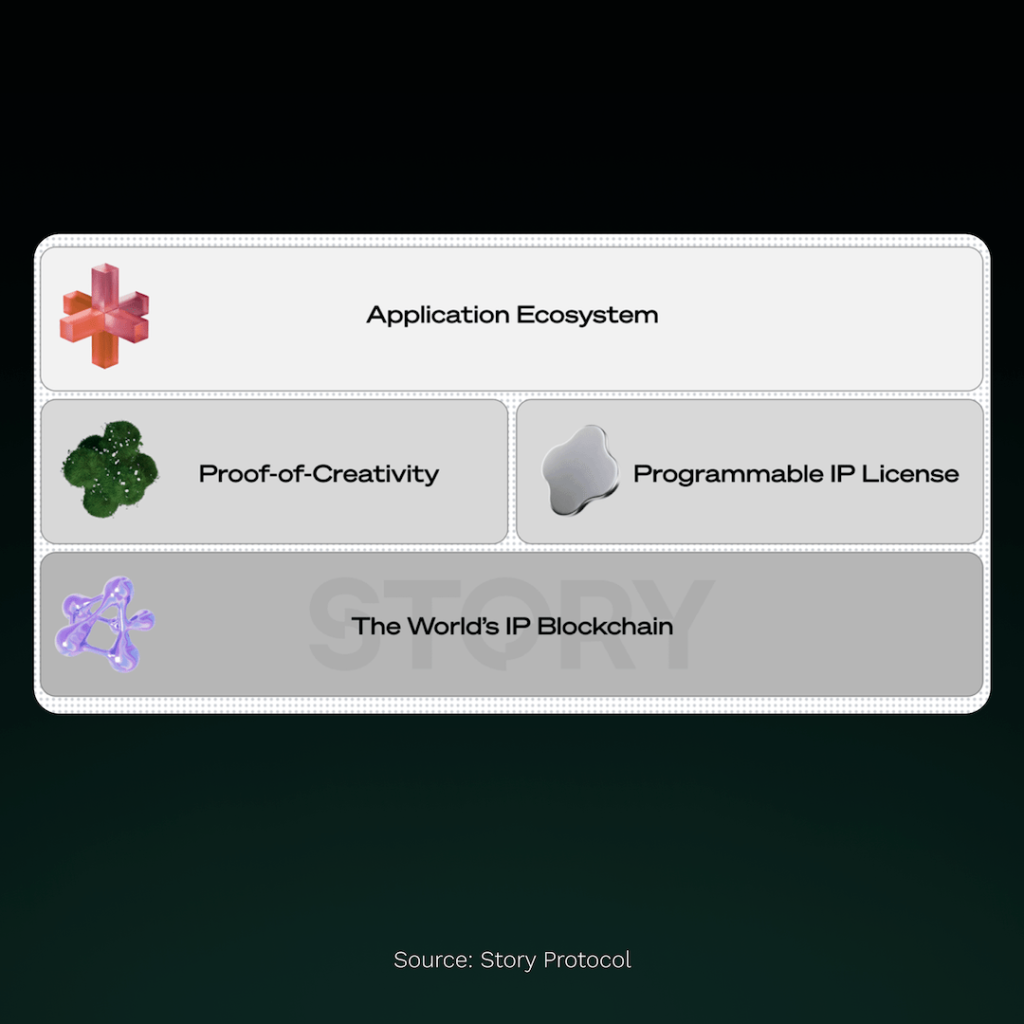
The image above illustrates the structure of Story Protocol, showing how different components interact. The Story Network forms the foundation, upon which the Proof of Creativity Protocol and PIL are built. Applications can then be developed on top of this infrastructure.
A key feature of Story Protocol is its approach to IP licensing. The PIL allows creators to set flexible, parameterized license terms represented on-chain. This enables IP to be licensed, remixed, and monetized according to pre-defined rules, all enforced through smart contracts. The protocol introduces the concept of “IP Assets,” which are on-chain representations of creative works, each associated with an IP Account that manages permissions and interactions with the protocol’s modules.
Story Protocol’s potential use cases include creator tools, AI-related applications such as attribution and attestation, and traditional IP-related functions like borrowing/lending and license trading. By providing a standardized, programmable framework for IP management, the protocol aims to reduce barriers to entry for creators and foster collaboration in the digital content economy.
As Story Protocol moves forward, its success will depend on its ability to bridge traditional legal frameworks with blockchain-based systems and achieve widespread adoption among creators and content platforms. The project’s innovative approach to IP management has the potential to create new opportunities for value creation and distribution in the creative industries, but it will need to navigate complex regulatory landscapes and overcome adoption challenges to realize its full potential.
Molecule

Molecule is pioneering a new approach to intellectual property management in biomedical research through its innovative use of Intellectual Property Non-Fungible Tokens (IP-NFTs). Launched in 2021, the platform creates a marketplace where researchers and biotech companies can tokenize their IP rights and research data, transforming traditionally illiquid intellectual assets into tradable digital tokens. These IP-NFTs represent both data access and legal IP rights to specific research projects, allowing for fractional ownership and more efficient trading of intellectual property.
The impact of Molecule’s IP tokenization approach has been significant. As of 2024, the platform has facilitated over $30 million in funding across more than 17 research projects, with a community of over 15,700 members. This model has enabled novel funding opportunities, such as a longevity research initiative that raised $2.2 million through IP-NFTs in just a few hours. By tokenizing IP, Molecule is creating early-stage IP markets where potential intellectual property from upcoming R&D projects can be traded efficiently, even before incurring the costs associated with filing patent protections.
Molecule’s platform demonstrates how blockchain technology and smart contracts can revolutionize the management and commercialization of intellectual property. It points to a future where complex IP rights can be more easily managed, traded, and leveraged, potentially transforming the drug discovery and development ecosystem. This approach not only changes how research is funded but also how scientific collaboration occurs, creating a more transparent, efficient, and democratized landscape for intellectual property in the biomedical field and beyond.
Luxury Collectibles
The tokenization of collectibles represents a significant shift in how high-value assets are owned, traded, and invested in. This process involves creating digital representations of physical items on blockchain platforms, allowing for fractional ownership and increased liquidity in markets that have traditionally been illiquid and exclusive.
The global market for tokenized luxury assets is rapidly expanding, with projections suggesting it could reach a value of $16 trillion by 2030. This growth is driven by increased accessibility, enhanced liquidity, and the ability to fractionally own high-value items that were previously out of reach for most investors.
Tokenization is being applied to a wide range of collectibles, transforming how these assets are perceived and traded in the digital age. Some prominent examples include:
- Luxury artwork
- High-end watches
- Jewelry
- Classic cars
- Luxury fashion items
- Rare coins and currency
- Antiques and historical artifacts
- Fine liquor and wine
The fine wine and liquor market serves as a prime example of the potential for tokenization. With the global wine market valued at $339.53 billion in 2021 and expected to reach $456.76 billion by 2028, tokenization opens up new avenues for investment and trading in this traditionally exclusive market.
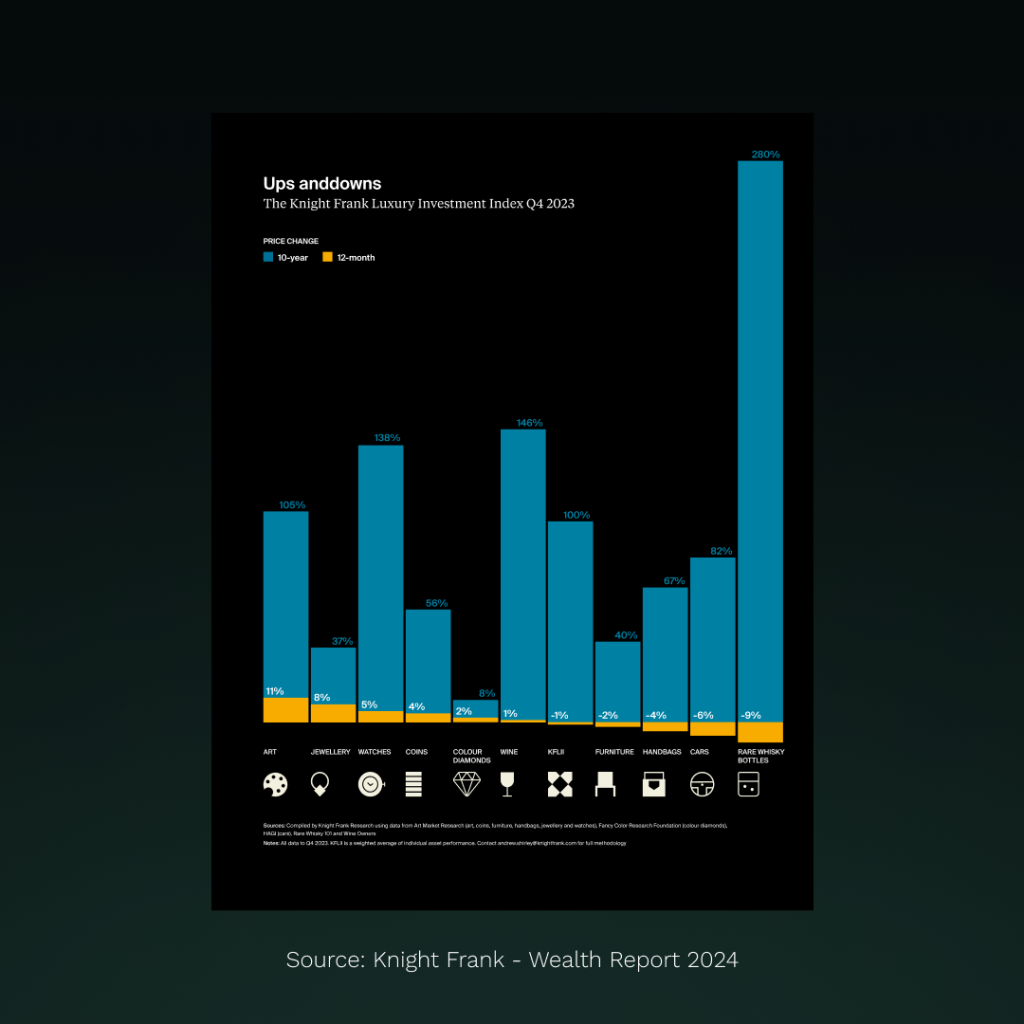
The Knight Frank Luxury Investment Index provides valuable insights into the performance of various luxury collectibles over the past year and decade. Notable performances include:
- Art: 105% growth over 10 years, with 11% growth in the last 12 months
- Watches: 138% growth over 10 years, with 5% growth in the last 12 months
- Rare whisky: Despite a 9% decline in the last 12 months, it showed an impressive 280% growth over 10 years
These figures demonstrate the long-term potential of luxury collectibles as investment assets, making them prime candidates for tokenization. The recent volatility in some categories, such as rare whisky, could be mitigated through fractional ownership enabled by tokenization, allowing investors to diversify their holdings more easily.
Current Problems
The traditional collectibles market faces several challenges that tokenization aims to address:
- Limited Liquidity: High-value collectibles are often illiquid assets, making it difficult for owners to quickly sell or realize the value of their investments. For example, selling a rare classic car or a piece of fine art can take months or even years, tying up significant capital.
- High Barriers to Entry: The collectibles market has traditionally been accessible only to wealthy individuals or institutions due to the high cost of entire assets. A single bottle of rare vintage wine can cost tens of thousands of dollars, making it unattainable for most investors.
- Authentication and Provenance Issues: Verifying the authenticity and ownership history of collectibles can be challenging and prone to fraud. In the luxury watch market alone, it’s estimated that 40 million counterfeit watches are produced annually, highlighting the need for better authentication methods.
- Storage and Insurance Costs: Physical collectibles require proper storage and insurance, which can be expensive and logistically challenging. For instance, storing and insuring a collection of fine art can cost up to 1-2% of the collection’s value annually, eating into potential returns.
Tokenization Process
The process of tokenizing collectibles typically involves the following steps:
- Asset Verification: Experts authenticate and value the physical asset.
- Digital Representation: A digital token is created to represent the asset or a fraction of it.
- Smart Contract Creation: Terms of ownership and trading are encoded in a smart contract.
- Token Issuance: Tokens are issued on a blockchain platform, often as Non-Fungible Tokens (NFTs).
- Custody Solution: The physical asset is stored in a secure facility.
- Trading Platform: Tokens are made available for trading on specialized platforms.
Project Examples
Protocol
Type
BlockBar
Rare Spirits and Liquor
BlockCellar
Rare Spirits and Liquor
Baxus
Rare Spirits and Liquor
Galileo Protocol
General Marketplace for tokenized collectibles
ArkeFi
General Marketplace for tokenized collectibles
Courtyard
Tokenized trading cards
Buk Protocol
Tokenized ticketing
Luxury Investment Trends
The Attitudes Survey data from Knight Frank’s: The Wealth Report 2024 provides crucial insights into the current landscape of luxury investments among Ultra High Networth Individuals. This information is particularly relevant when considering the potential for tokenization in these markets.
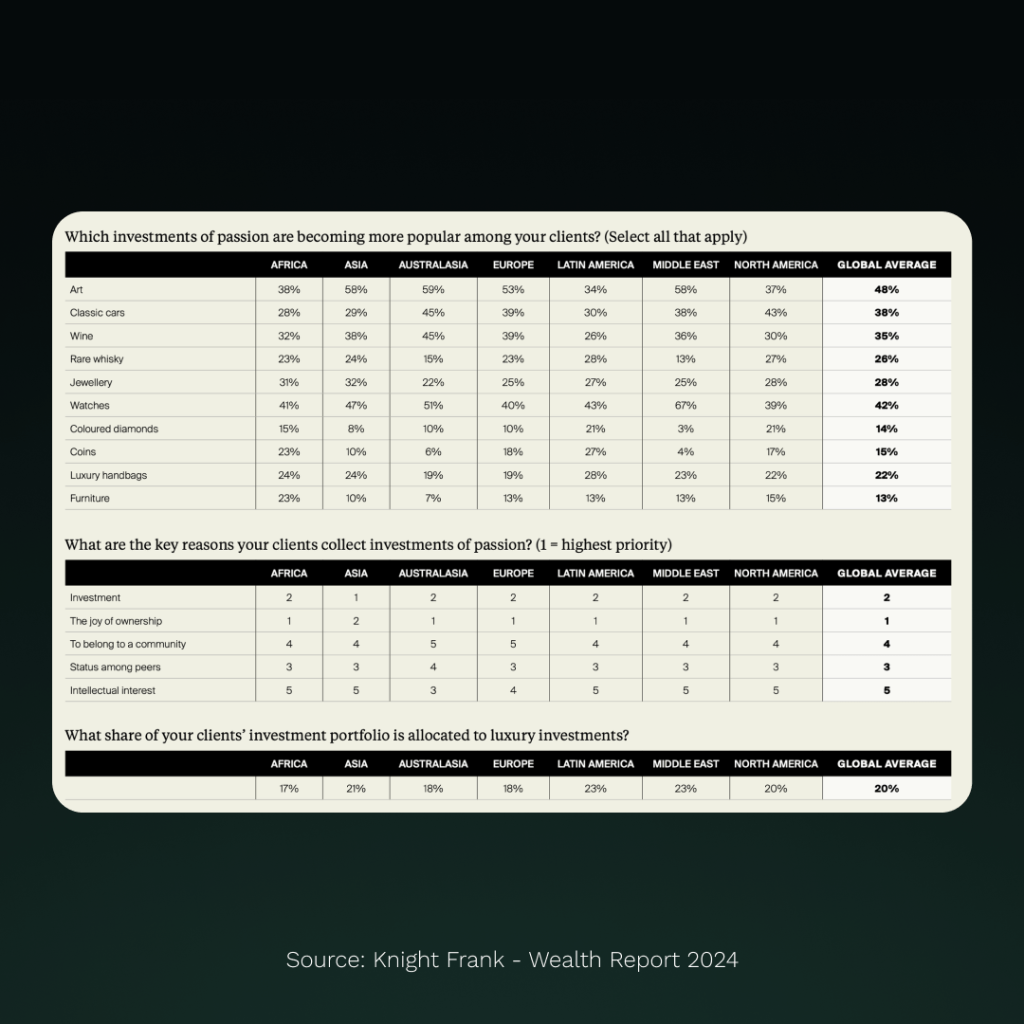
Art remains the most popular investment of passion globally, with 48% of respondents indicating increased interest. This aligns well with the growing trend of tokenizing fine art, allowing for fractional ownership of high-value pieces.
Watches (42%) and classic cars (38%) follow closely. The high interest in these categories suggests they could be prime candidates for tokenization, especially given their typically high values and the challenges of storage and maintenance.
Wine (35%) and rare whisky (26%) show significant interest, particularly in certain regions. The growing popularity of these assets, combined with their need for proper storage and authentication, makes them ideal for blockchain-based solutions.
Potential of Blockchain in Collectible Markets
The integration of blockchain technology in the collectibles market holds immense potential for transforming how these assets are traded and owned. This development is particularly exciting because it democratizes access to high-value assets and creates new investment opportunities for a much wider audience.
Historically, luxury collectibles have been the exclusive domain of high-net-worth individuals due to their high costs and the complexities of ownership. However, tokenization and fractionalization of these goods through blockchain technology are set to revolutionize this landscape, opening up these markets to a vast new client base.
Blockchain’s ability to provide transparent, immutable records of ownership and provenance addresses many of the current challenges in the collectibles market. In the luxury watch industry, for example, tokenization could potentially save billions in losses due to counterfeiting by providing a foolproof method of authentication. This is particularly relevant given the high interest in watches, especially in regions like the Middle East where 67% of respondents indicated increased interest.
The fractional ownership model enabled by tokenization is opening up new possibilities for diversification and investment. In markets like fine art or rare whisky, where individual pieces can be prohibitively expensive for most investors, tokenization allows for partial ownership at more accessible price points. This democratization of ownership makes it possible for a broader range of investors to participate in markets that were previously reserved for high-net-worth individuals or institutions.
the technology increases liquidity in traditionally illiquid markets, allowing for more dynamic trading of high-value assets. This is particularly beneficial for categories like wine and rare whisky, which show significant interest (35% and 26% respectively) and require specialized storage and authentication – challenges that blockchain-based solutions are well-suited to address.
The potential for growth in tokenized collectibles is substantial across various sectors. From luxury cars to rare wines, the trend towards tokenization is not only reshaping how collectibles are traded but also how they are perceived as investment assets. This shift could lead to a more efficient and transparent market for luxury goods and collectibles, potentially unlocking billions in value and creating new opportunities for investors, collectors, and asset owners alike.
As the luxury investment market continues to evolve, tokenization stands poised to play a significant role in reshaping how these assets are owned, traded, and appreciated. By addressing issues of accessibility, liquidity, and authentication, tokenization can enhance both the emotional and financial aspects of luxury investing, making these exclusive markets more dynamic than ever before.
BlockBar
BlockBar addresses several challenges in the fine wine and spirits market through blockchain technology. The platform serves as a marketplace for high-quality wines and spirits, using blockchain for authentication. This approach aims to resolve issues related to authenticity, provenance, and accessibility that have been persistent in the traditional market.
The platform’s core function is to streamline the process of sourcing, storing, and trading fine wines and spirits. BlockBar creates a digital token (NFT) minted directly from producers’ wallets, which represents proof of authenticity, ownership verification, and the right to redeem the physical bottle. This system is designed to reduce the risk of counterfeiting and damage during transportation, which are recognized issues in the conventional market.
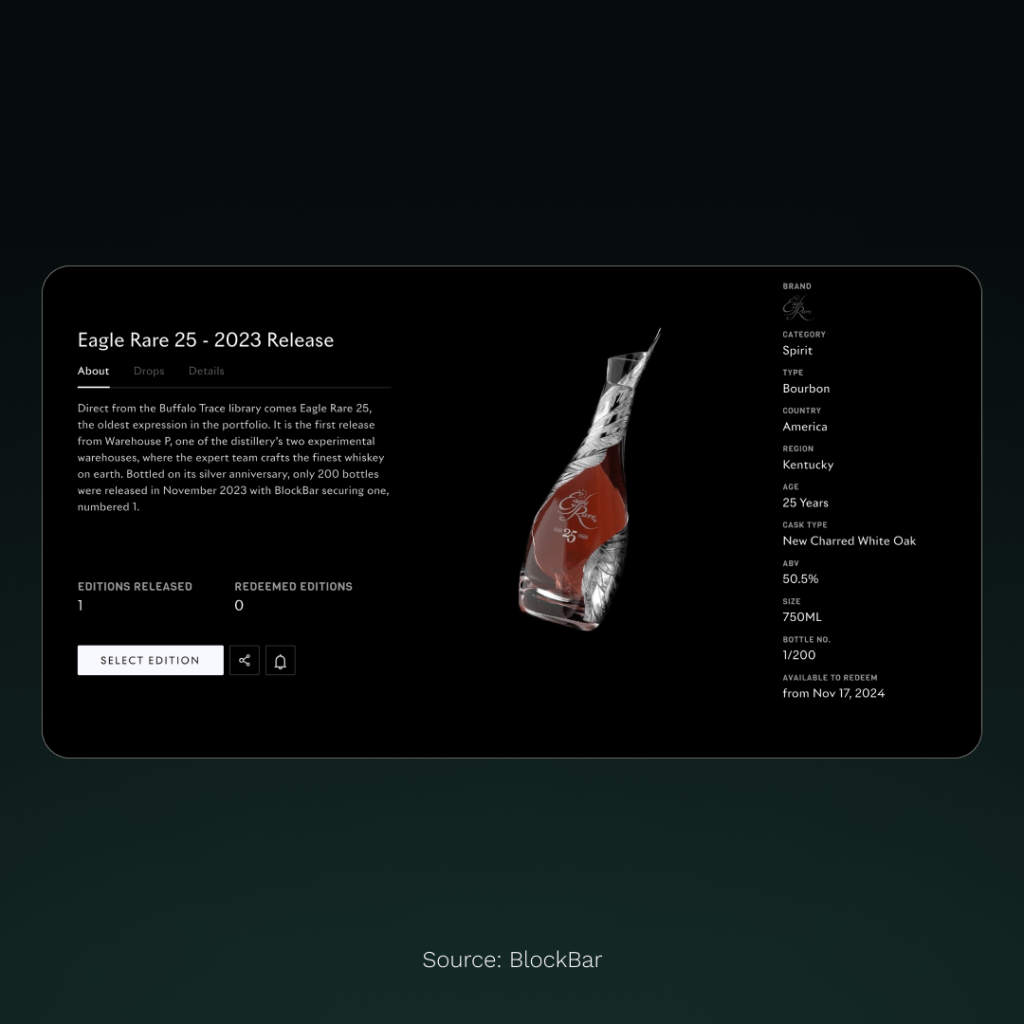
BlockBar has seen success in high-profile auctions. For instance, the platform sold bottle number one of 200, Eagle Rare 25 – 2023 Release for $55,000. This sale demonstrates the platform’s ability to facilitate transactions of rare spirits while providing authentication.
The Knight Frank Luxury Investment Index reports that the wine market grew by 1% in 2023.While this growth appears modest, it’s noteworthy in the context of broader luxury investment markets. Wine has demonstrated consistent performance over the years, with the report indicating a 146% growth over the past decade. This long-term stability contrasts with more volatile luxury assets, positioning wine as a resilient investment. BlockBar’s model intersects with this established market, offering a digital approach to trading and authenticating fine wines and spirits. This method may appeal to investors and collectors seeking new ways to engage with these traditionally stable assets.
BlockBar’s future plans include expanding its storage facilities globally and offering free storage for owners until 2030. As the fine wine and spirits market continues to evolve, BlockBar’s blockchain-based solution presents a new option for collectors and producers. The long-term impact of this approach on the trading and consumption of these luxury assets remains to be seen.
Carbon Credits
In recent years, environmental sustainability has become a critical focus for businesses worldwide, largely driven by the increasing importance of Environmental, Social, and Governance (ESG) criteria. Among the various strategies employed to meet ESG goals, carbon credits have emerged as a significant tool in the fight against climate change. The urgency to combat climate change has led global institutions to introduce innovative solutions, with carbon credits standing out as a key mechanism.
Carbon credits, also known as carbon offsets, are permits that allow the owner to emit a certain amount of carbon dioxide or other greenhouse gases (GHGs). One credit permits the emission of one ton of carbon dioxide or its equivalent in other GHGs, serving as a universal unit of account for emissions associated with specific production processes or economic activities. This system incentivizes companies to reduce their carbon footprint by allowing them to sell unused credits or requiring them to purchase additional credits if they exceed their emission limits.
Current Problems with Carbon Markets
The voluntary carbon market, despite its potential, faces several significant challenges. The market is complex and vulnerable to frauds or scams, primarily due to its fragmented nature and lack of transparency. It consists of numerous carbon credit standards and registries operating independently, making it difficult to track credits and ensure robust accounting. This fragmentation leads to high transaction costs, as navigating between different registries and standards is burdensome for both project developers and buyers. Additionally, the limited public information on carbon credit prices and transactions reduces market efficiency, with some brokers reportedly reselling credits for up to seven times their original purchase price.
The Need for On-Chain Solutions
Bringing carbon credits on-chain through blockchain technology addresses these issues in several ways:
Improving transparency and connectivity between registries – Blockchain technology provides an immutable and transparent ledger of all transactions. By recording carbon credit issuance, transfers, and retirements on a public blockchain, all market participants can have access to real-time, verifiable information. This transparency helps to build trust in the market and enables better decision-making by both buyers and sellers.
Reducing transaction costs and eliminating intermediaries – The current voluntary carbon market is plagued by intermediaries who often charge exorbitant fees for their services. These middlemen or brokers typically educate buyers, create carbon credits, and retire them on behalf of the purchaser, but at a significant cost. In some cases, they buy carbon credits from developing nations at low prices and sell them at inflated rates, sometimes up to three times the original value.
Smart contracts on the blockchain can automate many of these processes, effectively eliminating the need for these costly intermediaries. This automation not only reduces transaction costs but also speeds up processes that traditionally take months to complete. By removing middlemen, a larger portion of the funds goes directly to the project developers, incentivizing more carbon reduction initiatives and ensuring fairer pricing in the market.
Market efficiency and liquidity – Tokenization of carbon credits allows for easier trading and fractional ownership. This increased liquidity can attract more participants to the market, from large corporations to individual investors. The ability to trade carbon credits more freely and quickly can lead to more accurate pricing and a more efficient market overall.
Preventing double counting through immutable record-keeping – One of the most significant issues in the current carbon credit market is double counting, where the same credit is counted towards multiple climate commitments. Blockchain’s immutable record-keeping makes it virtually impossible to double count credits, as each credit is uniquely identified and its entire history is traceable on the blockchain.
Tokenization Process
Tokenization of carbon credits involves moving the credits’ information and functionality onto a blockchain, where each credit is represented as a token. The process includes:
- Verifying and quantifying carbon emission reductions achieved by specific projects
- Recording verified data on the blockchain, ensuring immutability and transparency
- Issuing tokens representing carbon credits via smart contracts
- Enabling easy buying, selling, and trading of these digital assets
The Potential of Blockchain in Carbon Markets
The integration of blockchain technology in carbon markets offers exciting possibilities for the future of environmental sustainability. By addressing the current market inefficiencies, blockchain can help to scale the carbon credit market significantly. This scaling is crucial, as the global carbon credit market is projected to reach $100 billion by 2030, according to PwC. The increased efficiency and trust in the market could encourage more companies to participate in carbon offsetting, leading to greater overall reductions in global carbon emissions.
Blockchain technology enables the creation of more innovative carbon credit products. For example, carbon credits can be easily bundled with other environmental assets or used in complex financial instruments. This flexibility could attract more investment into green projects and accelerate the transition to a low-carbon economy. The ability to fractionalize carbon credits also democratizes access to the market, allowing smaller businesses and even individuals to participate in carbon offsetting.
We are particularly excited about the potential for blockchain to bring unprecedented transparency to the carbon credit market. In the current system, it’s often difficult to trace the impact of carbon credit purchases. With blockchain, every step from project initiation to credit retirement can be tracked and verified. This traceability not only builds trust but also allows buyers to more easily choose credits from projects that align with their values or geographical preferences.
In conclusion, the tokenization of carbon credits on blockchain represents a significant step forward in our fight against climate change. By addressing the key issues of transparency, efficiency, and integrity in the carbon credit market, blockchain technology has the potential to accelerate global decarbonization efforts. As this technology continues to evolve and gain adoption, we can look forward to a more robust, accessible, and effective carbon credit market that plays a crucial role in achieving our collective climate goals.
Projects Overview
Protocol
Type
Flow Carbon
Tokenizes carbon credits to bring them on-chain, creating a transparent and liquid marketplace where companies and individuals can buy, sell, and retire verified carbon offsets to combat climate change.
Toucan
Brining traditional carbon markets onchain by facilitating carbon credits to be tokenized, traded, and used within the DeFi ecosystem, creating more accessible and efficient climate action.
Nori
Establishes a marketplace focused on carbon removal, where carbon removal certificates are issued and traded, incentivizing the capture and long-term storage of carbon dioxide to mitigate climate change.
Veridium
Uses the blockchain to streamline the carbon offsetting process, integrating environmental assets into corporate sustainability strategies and automating the verification of carbon credits.
Carbify
Provides a platform for the tokenization and trading of carbon credits, allowing users to participate in carbon offsetting by investing in verified projects aimed at reducing atmospheric carbon dioxide.
ClimateTrade
Connects companies with environmental projects for direct carbon offsetting through a blockchain-based marketplace, simplifying and improving access to the carbon credit market.
Moss Earth
Specializes in offering tokenized carbon credits, enabling individuals and organizations to offset their carbon emissions through a secure and transparent blockchain platform.
KlimaDAO
A DAO that drives climate action by creating a carbon-backed digital currency, encouraging the reduction of carbon emissions through innovative DeFi mechanisms.
Regen Network
Focuses on building a blockchain-based marketplace for ecological assets, where users can invest in, monitor, and verify the impact of regenerative land management and environmental projects.
Tokenized Carbon Credits Examples
Let’s look a little deeper into some of these projects building in the carbon credits space.
Toucan
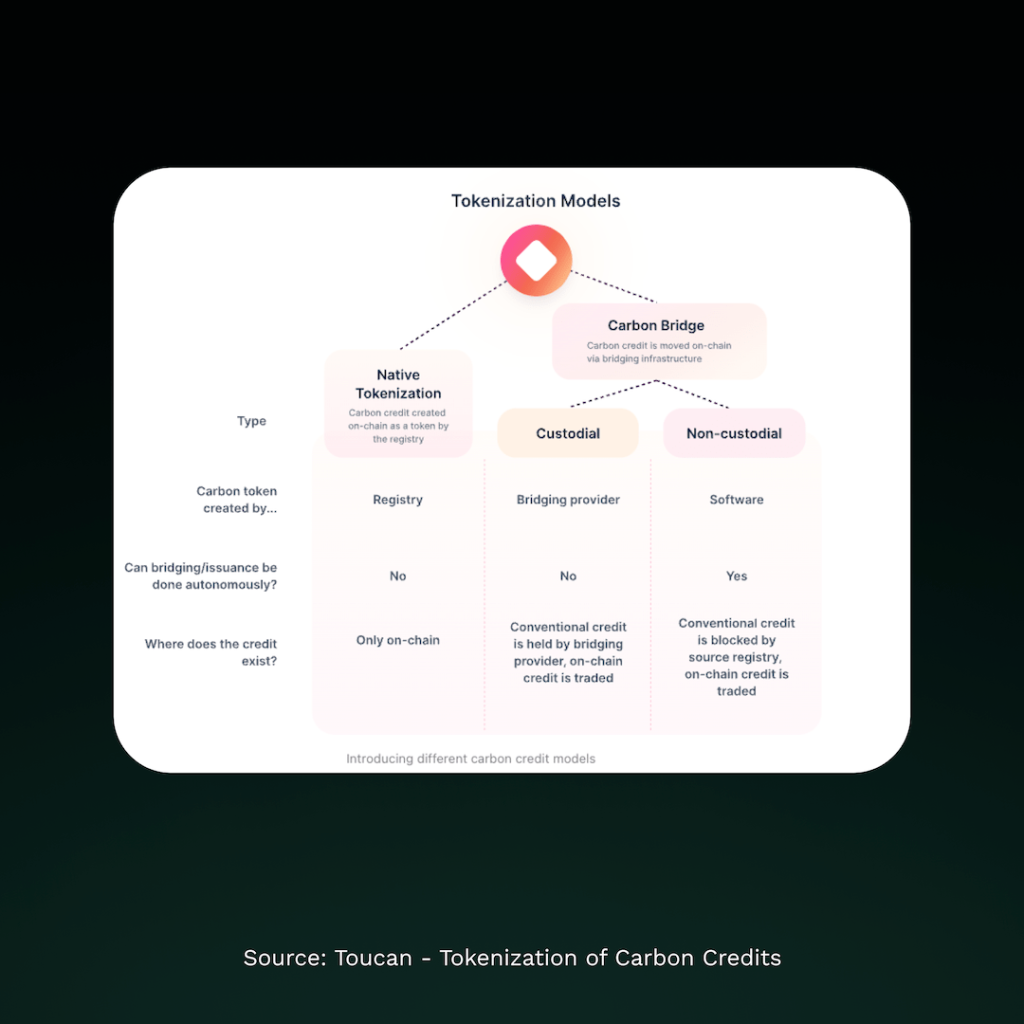
Toucan Protocol, launched in October 2021, represents an initiative to integrate traditional carbon markets with blockchain technology. The protocol provides a platform for tokenized trading of carbon credits from the Voluntary Carbon Market (VCM). Toucan’s primary function is to transfer carbon credits from external non-blockchain carbon registries onto the blockchain, where they are stored as TCO2 crypto tokens.
Central to Toucan’s operation is its Carbon Bridge, which connects to registries operated by respected standards bodies such as Verra and Gold Standard. This connection ensures the credibility of the credits brought onto the platform. As illustrated in the tokenization models image, Toucan’s approach falls under the “Carbon Bridge” category, specifically the “Non-custodial” subcategory. In this model, the carbon token is created by software, bridging can be done autonomously, and while the conventional credit is blocked by the source registry, the on-chain credit is traded.
Toucan utilizes energy-efficient blockchains, currently Polygon and Celo, which are Ethereum Virtual Machine (EVM) compatible and use Proof of Stake validation. Once a carbon credit is moved onto the Open Climate Registry, it becomes a TCO2 token, containing all relevant data of the original credit. Toucan also implements “Carbon Pools,” which aggregate similar carbon tokens, issuing pool-specific tokens like the Base Carbon Tonne (BCT).
While Toucan aims to increase transparency and accessibility in carbon trading, it faces ongoing challenges in the evolving landscape of carbon markets and blockchain technology. These include addressing concerns about the quality and additionality of carbon credits, ensuring the integrity of the tokenization process, and navigating the regulatory environment.
KlimaDAO
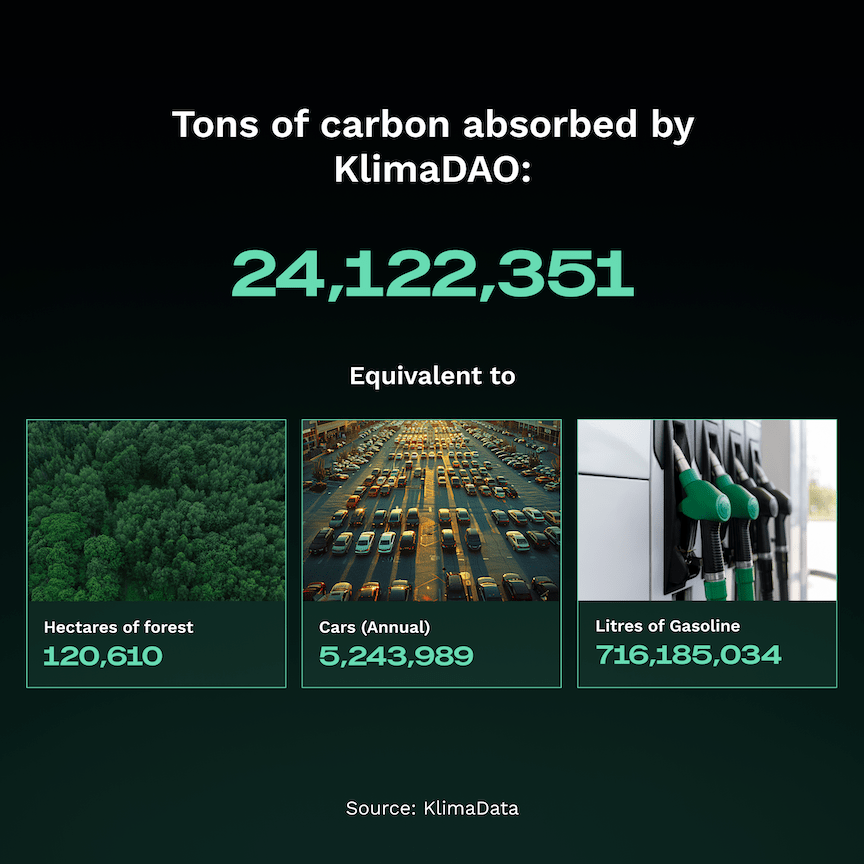
KlimaDAO, established in 2021, represents an initiative to integrate blockchain technology with carbon market operations. This decentralized autonomous organization (DAO) focuses on accelerating the appreciation of carbon assets through the use of Web3 technologies. The primary mechanism of KlimaDAO is the $KLIMA token, a utility token backed by at least one carbon tonne in the KlimaDAO treasury, which functions as both a medium of exchange and an index for carbon projects.
KlimaDAO’s operations encompass several areas within the carbon market ecosystem. The organization allocates funds to carbon removal projects, contributes to liquidity in carbon markets, and develops infrastructure for the acquisition and retirement of digital carbon credits. By participating in carbon pools on platforms such as Toucan Protocol and supporting listings on Carbonmark, KlimaDAO aims to increase the accessibility of carbon credits to a broader range of investors and facilitate more efficient trading processes.

An analysis of the current carbon market reveals the significant potential for growth that KlimaDAO possesses. As shown in the sector breakdown table, KlimaDAO’s market share across various sectors remains relatively small compared to the total number of Verified Carbon Credit Units issued by traditional platforms like Verra. For instance, in the Energy Industry sector, KlimaDAO has tokenized only 3.05% of the total credits issued. This pattern is consistent across other sectors, demonstrating that while KlimaDAO has made notable progress, there remains substantial room for expansion within the existing carbon market.
KlimaDAO’s potential for growth is further emphasized by its current total absorption of 24,122,351 tons of carbon. As KlimaDAO continues to develop its infrastructure and expand its operations, it has the potential to capture a larger portion of the carbon market, potentially reshaping how carbon credits are traded and utilized in addressing climate change. The organization’s focus on data provision, community governance, and innovation within the carbon market space positions it well to contribute to the evolution of carbon market mechanisms and strategies for climate change mitigation on a broader scale.
Honorable Mentions
While major sectors like real estate, commodities, and government securities dominate much of the tokenization conversation, the true revolutionary potential of this technology often emerges in unexpected places. This section explores a selection of niche tokenization projects that are pushing the boundaries of what can be digitized, owned, and traded on the blockchain.
These innovative ventures demonstrate the versatility and far-reaching implications of tokenization technology. From the air above our cities to the very minutes of our day, these projects are reimagining ownership and value in the digital age. While some may seem unconventional or even experimental, they offer valuable insights into the future possibilities of tokenization. By exploring these cutting-edge applications, we gain a broader understanding of how blockchain technology could reshape various aspects of our economy and society, far beyond traditional financial assets
Tokenized Air Rights
SkyTrade is developing a platform for the tokenization and trading of air rights – the space above properties that can be sold or leased for purposes such as real estate development or drone flight paths. As of early 2024, SkyTrade has tokenized 7,000 airspaces with a total value of $35 million. The platform utilizes blockchain technology to facilitate transactions and record ownership of these rights, which have historically been challenging to value and transfer.
The market for air rights is potentially large, with SkyTrade estimating the global value of unclaimed air rights at $31 trillion. In New York City, air rights are valued at approximately $550 billion, while London’s are estimated at $51 billion. Prices per cubic foot range from $25 to $400, depending on location and potential use. By creating a marketplace for these rights, SkyTrade aims to provide property owners with a way to monetize their airspace and create opportunities for urban development and drone operations. However, the project faces regulatory complexities and the need to educate potential users about this asset class.
Air rights have multiple use cases beyond traditional real estate development. They can be used to protect views, enable drone delivery routes, or even for future urban air mobility infrastructure. In dense urban areas, developers can purchase air rights from neighboring properties to build taller structures. For drone operations, SkyTrade envisions a system where drone companies can rent airspace for their flight paths, creating a new revenue stream for property owners.
Jonathan Dockrell, co-founder and CEO of SkyTrade, explains the potential: “We’re tokenizing these air rights on the Solana blockchain, creating a transparent and liquid marketplace accessible to a broader range of participants. Moving it from where it effectively is now, non-digitized on chain and bringing all of the positive aspects of on-chain immutability, the quick transactions, the low transaction costs, is a zero to one move.”
While the concept is innovative, SkyTrade will need to navigate complex regulatory environments and work closely with local authorities to realize its full potential.
Tokenized Agriculture
AgriDex is a blockchain based platform for tokenizing and trading agricultural assets, aiming to bring liquidity and transparency to the agricultural commodity market. As of early 2024, the company has made significant strides in developing its infrastructure and forging key partnerships. The need for tokenization in the agricultural sector arises from several persistent challenges, including a lack of liquidity in traditional markets, limited access to capital for smaller farmers and businesses, inefficient supply chains, and significant price volatility in agricultural commodities.
The market potential for tokenized agricultural assets is substantial, with the global agricultural market valued at $11.3 trillion in 2022 and projected to reach $15.6 trillion by 2030. By tokenizing even a fraction of this market, AgriDex could tap into a multi-billion dollar opportunity. The company’s blockchain-based platform addresses these industry challenges by increasing liquidity through the tokenization of agricultural assets, improving access to capital by allowing farmers to tokenize future crop yields, enhancing supply chain transparency through immutable blockchain records, and potentially stabilizing prices through increased market participation and efficiency.
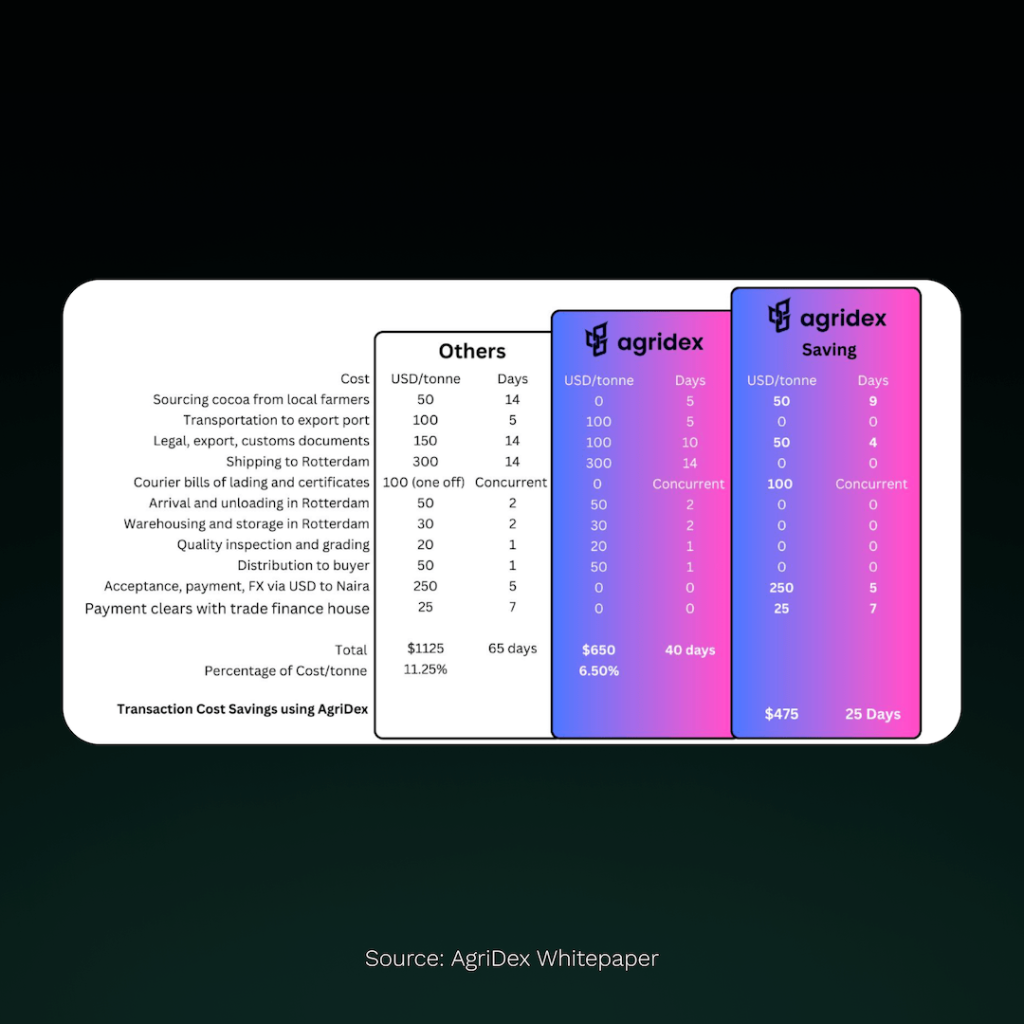
AgriDex’s platform offers significant benefits to farmers and other stakeholders in the agricultural supply chain, as evidenced by a comparative cost analysis for cocoa sourcing. The data shows that using AgriDex can reduce the total cost per tonne from $1,125 to $650, a savings of $475 per tonne. Moreover, the process time is dramatically shortened from 65 days to just 40 days. These efficiencies are achieved through reductions in various costs, including legal and customs documents, shipping, and payment processing.
As part of its growth strategy, AgriDex is actively developing partnerships with key players in the agricultural industry. However, the company faces challenges in navigating complex agricultural regulations across different countries and educating potential users about the benefits of tokenized agricultural assets. Despite these hurdles, AgriDex’s innovative approach, as demonstrated by the significant cost and time savings in cocoa sourcing, has the potential to reshape the agricultural economy, benefiting farmers, traders, and consumers alike through improved market dynamics and financial accessibility in the agricultural sector.
Tokenized Energy
Powerledger, founded in 2016 in Australia, is revolutionizing the renewable energy sector with its blockchain-based platform for decentralized energy trading. The company addresses key challenges in the energy market, such as inefficient distribution and limited access to renewable sources, by enabling peer-to-peer (P2P) trading of renewable energy. Utilizing blockchain technology, Powerledger creates a transparent and secure system for energy transactions, with its native POWR token facilitating access to the ecosystem. The platform allows prosumers to sell excess renewable energy directly to other consumers, creating a more efficient and democratized energy market.
The market potential for tokenized energy trading is substantial, with the global energy market valued at over $9 trillion. Powerledger’s diverse range of applications, including xGrid for P2P energy trading, μGrid for embedded networks, and VPP 2.0 for virtual power plants, positions the company to capture a significant portion of this market. These applications cater to various scenarios, from individual homeowners trading excess solar energy to large-scale commercial energy management. By enabling P2P trading, Power Ledger empowers consumers to have greater control over their energy sources and costs, potentially leading to more competitive pricing in the energy market.
One of Powerledger’s most notable successes was a pilot project in Lucknow, Uttar Pradesh, India, in 2021 which led to legislative changes. The state government directed all utilities to make provisions for P2P trading, demonstrating the real-world impact of tokenized energy trading. This pilot resulted in energy market buy prices 43% lower than retail tariffs, increased transparency and reliability of data, and reduced transaction costs. Despite these successes, the company faces challenges including regulatory hurdles, infrastructure requirements, and the need for market education about blockchain technology and tokenized energy trading.
As the world moves towards more sustainable and decentralized energy solutions, Powerledger stands at the forefront of this transformation, demonstrating the potential of blockchain technology to create a more efficient, transparent, and sustainable energy future. The company’s progress and real-world impact suggest that tokenized energy trading could become a significant part of the global energy landscape in the coming years.

“The world faces a crucial choice between meeting growing energy demands and scaling up renewables. Tokenizing and trading clean energy assets with blockchain technology opens up a transparent and efficient way of democratizing power. Real-World Assets, like tokenized energy, give people greater control over their energy use and costs. At Powerledger, we’re committed to a future where energy is both greener and accessible to all.”
John Bulich
Co-Founder & Director at Powerledger
Tokenized Time
Tokenizing time is a fascinating new development in blockchain and digital assets. This concept goes beyond traditional notions of value, offering a unique way to quantify and trade one of humanity’s most fundamental and scarce resources. By transforming time into a tradable digital asset, blockchain technology opens up new possibilities for valuing expertise, attention, and personal engagement in the digital economy.
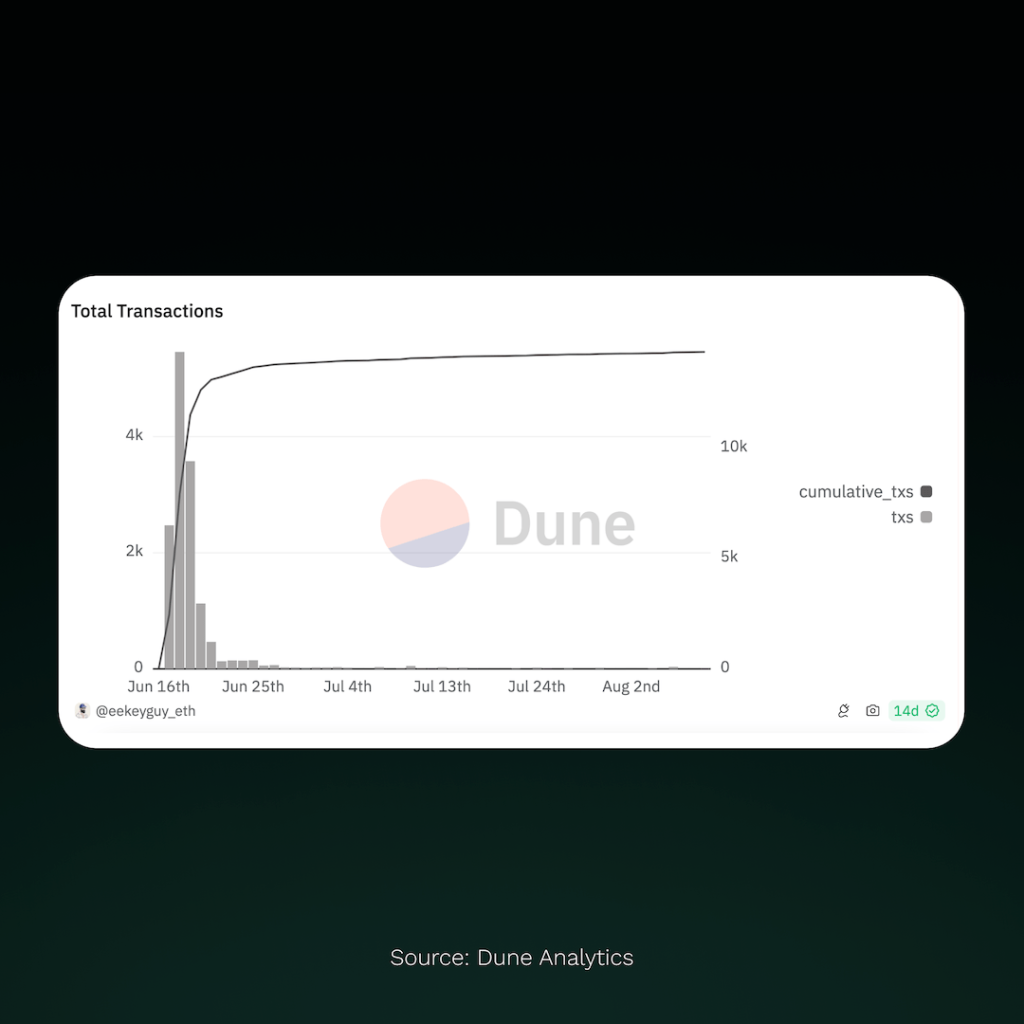
Time.fun is one example of how this concept can be applied in practice. Launched in 2024 on the Base blockchain, the platform allows creators to tokenize minutes of their time, which fans can then trade and redeem for personalized experiences. The platform uses a bonding curve mechanism where the value of time increases with fan demand, creating a dynamic marketplace for creator-fan interactions. While Time.fun initially generated significant interest, with a surge in token creation and trading activity in its early days, the platform has experienced a notable decline in engagement over time.
The tokenization of time has broader implications beyond individual platforms. It represents a potential shift in how we perceive and value human capital, expertise, and interpersonal connections. In a world where attention is increasingly fragmented and valuable, tokenized time could provide a more direct and transparent way to allocate and compensate for focused engagement. This concept could revolutionize fields such as consulting, mentorship, and education, where time and expertise are the primary commodities.
However, the challenges faced by platforms like Time.fun highlight the complexities of bringing such abstract concepts to the blockchain. While the idea of tokenizing time is intriguing, sustaining user interest and demonstrating long-term value remains a significant hurdle. Nevertheless, these experiments contribute valuable insights to the ongoing exploration of new asset classes being tokenized, potentially influencing future developments in the tokenization of intangible assets and reshaping our understanding of value in the digital age.
Tokenized Car Leases
Econommi, a web2 company specializing in car leasing solutions, is venturing into the blockchain space with its project Comunitti. This is a great example of how traditional finance companies are exploring blockchain technology to streamline operations and offer new services. While Econommi itself operates as a conventional leasing platform with a unique fixed-fee model, Comunitti represents their foray into tokenizing car leases.
Currently running a testnet on Avalanche, Comunitti, though currently inactive, showcased an intriguing concept for bringing car leases onto the blockchain. The platform aimed to create a marketplace where users could invest in tokenized car leases, effectively allowing for fractional ownership of vehicle lease contracts. This approach demonstrated the potential for blockchain to increase transparency and liquidity in traditionally opaque and illiquid markets like car leasing.
The relationship between Econommi and Comunitti highlights a growing trend of web2 companies developing blockchain-based offshoots to enhance their existing business models. By leveraging blockchain technology, these companies aim to offer more transparent, efficient, and accessible financial products. In the case of car leasing, this could mean easier trading of lease contracts, more granular investment opportunities, and improved tracking of asset ownership and value.
While Comunitti’s current inactivity suggests challenges in implementation or market readiness, the concept itself remains valuable. It demonstrates how traditional financial products like car leases could be transformed through tokenization, potentially opening up new avenues for investment and asset management. As companies like Econommi continue to explore blockchain integration, we may see more successful implementations that bridge the gap between conventional finance and the digital asset ecosystem.
Part 3
The Future of Tokenized Assets
The conclusion is clear: there is a lot happening in the world of tokenizing real-world assets.
2030 Tokenized Real World Assets Predictions
Several research reports have been published by reputable companies, making predictions around the 2030 market size of tokenized assets.
Organization
Bear / Base
Bull
Source
Current market size is $185bn, including stablecoins, for reference
Expansion Across Asset Classes
Aside from what we’ve covered in this report, we are also keen to see other assets come on chain. We’ve already seen successful implementations in real estate, fine art, and financial instruments, the next wave of tokenization is set to transform even more sectors:
- Intellectual Property: Patents, copyrights, and trademarks could be tokenized, allowing for fractional ownership and more efficient licensing models.
- Future Earnings: Athletes, artists, and even corporations could tokenize their future income streams, creating new investment opportunities and funding models.
- Natural Resources: Tokenization could revolutionize how we manage and trade commodities, from precious metals to carbon credits.
- Infrastructure: Public works projects and utilities could be tokenized, allowing for more direct community investment and ownership.
Particularly interesting will be tokenization of things that do not already exist, such as future earnings from income.
Room for Growth
As we look towards 2030, the potential market size for tokenized assets is staggering. According to the industry reports above, the market for tokenized real-world assets could reach anywhere from $2 trillion to as much as $30 trillion by the end of the decade. Today that number sits at around $12bn according to RWA.xyz, excluding stablecoins.
The future of tokenized assets appears exceptionally bright because of the benefits tokenization brings. The integration of traditional finance with blockchain technology is not just a trend, but a fundamental shift towards a more accessible, efficient, and dynamic financial ecosystem. As the market matures and adoption grows, tokenized assets are likely to capture a significant share of the global financial market, potentially reshaping how we invest, trade, and own assets in the years to come.
Capitalizing on The Great Tokenization
To capitalize on the explosive growth predicted for asset tokenization, investors and businesses should strategically position themselves now to reap future rewards. This includes investing in the infrastructure that supports tokenization, such as blockchain platforms, tokenization services, and secure digital wallets. Additionally, exploring opportunities in sectors likely to see early adoption, like real estate, art, and commodities, could provide significant returns. Building partnerships with emerging tokenization platforms or launching tokenized assets early can also provide a competitive edge. As trillions are expected to come on-chain, establishing a foothold now could yield substantial long-term gains.
Tren Finance & RWA Tokenization
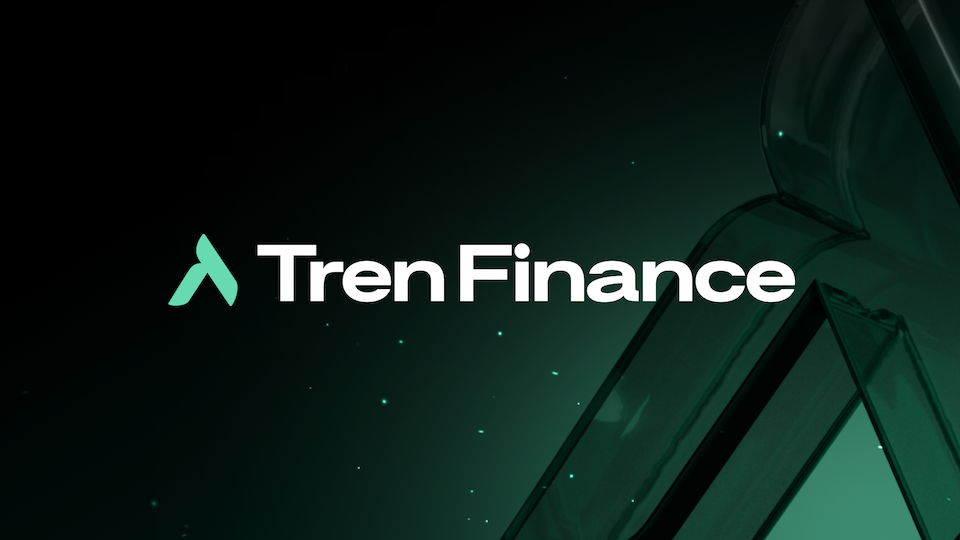
At Tren Finance our mission is to unlock liquidity for the long tail of crypto. Our vision is to make these real world assets that are coming on chain more liquid, by allowing the use of those assets, or receipt tokens of those assets to be used as collateral to take out a stablecoin loan.
We envision a future where any asset, regardless of its nature or origin, can be seamlessly integrated into the DeFi ecosystem. We aim to accelerate the adoption of tokenized assets and contribute to the creation of a more accessible and efficient financial system.
Disclaimer
Our best efforts have gone into citing sources. Should a source be missing from any information you come across in this post, feel free to reach out in Discord and we’re happy to make prompt corrections.


